2016
Greetings colleagues. A brief update for the week of December 12-16:
- Last Saturday, ARMAS sponsored the “Hour Of Code” event. This activity attracted many children and parents to our campus to learn how to code and to increase their interest in STEM disciplines generally. Congratulations to Mr. Mariano Ulibarri, Ms. Elizabeth Ratzlaff, and others who made this day a success. Joan and I welcomed participants to our campus. We were joined by our mayor and members of the town council who attended the event. More than 75 people attended. Later this week, Mr. Ulibarri, Dr. Gil Gallegos, and Ms. Elizabeth Ratzlaff met with me to go over some plans for a powerful outreach effort to children in our community. Tentative plans call for some showcase type events (like the Hour of Code), enhanced effort’s to get more K-12 students on our campus (after school workshops, summer courses, etc.), and more outreach efforts (going to local schools). As you may know, Mr. Ulibarri ’s position is supported by a generous gift from Los Alamos Labs.
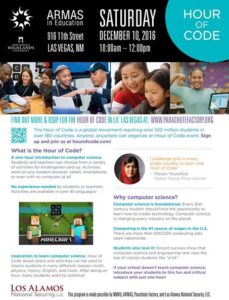
- Things are moving forward on the new (and hopefully, improved) approaches we are using in the recruitment area. As everyone knows, adding students is very important to HU. We have the capacity to add students. Tuition is a significant source of revenue for us and…we should provide a good and affordable higher education to as many students as we can manage and still do so with high quality. To realistically add students is a daunting challenge. The population of our main catchment area (Northern New Mexico) is decreasing at a rather severe rate. High school populations are down. Young people are leaving New Mexico in search of jobs and better opportunities. All this means that we must use the best processes and tools we can muster to increase our enrollment. And, that is what we are doing. The next major push to add students will begin February 13. On or about that day, our partners at Ruffalo Noel Levitz will send the first of nine emails to approximately 20,000 prospective students carefully screened as students potentially interested in HU. No more random emails or mailings in the hopes a student might be interested in HU. Those pre-screened 20K will be added to about 7,000 names we already have in our system right now. Students will receive targeted emails (that is, if someone indicates they have some interest in HU after the first email, they’ll get a different one the next time around). There will also be direct mailings to some of these students and some will also receive a phone call. This approach is but one major push in hopes of enrolling more students. The new student recruiters under the direct leadership of Jessica Jaramillo will visit many high schools and college fairs and we now have more and much better recruitment materials to share with them. We are also revamping our campus tour program to make it more up-to-date, modern, and welcoming. Finally, Dr. Warren Lail is assuming overall leadership for graduate student recruitment and we hope for some improvements there. The schools with high cachet do not need to recruit. They simply draw a line and accept everyone above it. However, there are really only a few schools like that. These days, everyone else must actively recruit. The new approach we are employing will improve over time. Using new technology, we will send even more targeted messages to prospects and we’ll also work more on our messaging in printed materials.
We’ll see how this new approach works, but I am very pleased that it has been engineered and implemented so quickly. The new Division of Strategic Enrollment Management (SEM) was conceived last fall and established last spring—only about nine months ago. In less than a year, the unit is fully up and running with a new leader, a new head recruiter, all new student recruiters, a new Native American recruiter, new and exciting promotional materials, a new branding campaign and proposed visual identity, and new analytical tools. Most of the credit should be given to Dr. Edward Martinez who is managing and leading this unit. In my view, SEM is now soundly engineered…now it is time to perform. - Many thanks to those who attended the HU holiday potluck and gift exchange last Tuesday afternoon. It was very nice and I thank Margaret and her team for making it happen. A photo from this event:
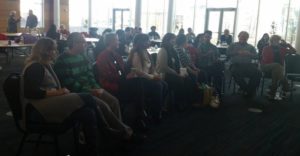
- Approximately 80 faculty and staff members attended the HU Holiday Gathering at the University Residence on Wednesday afternoon. The trees you see in the living room were decorated by student groups from the HU campus. A photo of the event:
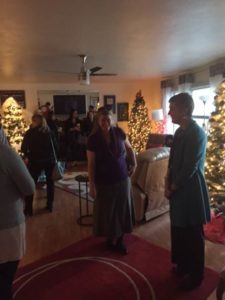
- The Executive Team is nearly done with our budget hearings. We received lots of good input from the various units on campus and frankly, in virtually every case the requests made sense and would enhance or strengthen HU in some meaningful way. The requests totaled several million dollars, as anticipated, so now the hard work of prioritizing the requests against our mission begins. In my view, the process has been quite transparent and open. As you can imagine, not everyone agrees with the prioritization of others. This is as much art as science, but as I previously wrote—the driver is how congruent the request is with our mission. It is also the case that some requests are highly congruent, but simply too costly to get done right now. Still the connection between the request and the mission will be critical in the ultimate priority list. As promised, there will be a campus meeting to share the overall priorities at that point.
- I have made a verbal agreement with one of the finalist for the Provost/VPAA position. I will be making a campus-wide announcement as soon as the contract is signed and there is an opportunity for our new provost to inform people on the other end. In my view, this search was nearly a textbook example of how professional searches are run. We hit every mark in regard to our timelines, we attracted a very large number of applicants, the campus visits were well organized, and…in the end, the search was successful. Well done to the Search Committee and everyone who contributed to this success. We have also made an offer and come to terms with the new (and permanent) Dean of the Facundo Valdez School of Social Work—Dr. Cristina Duran. For the first time since I have been at HU, we now have permanent (no-interim) deans managing and leading all of our units. The Provost and I have high confidence in Cristina to effectively manage and lead what is already a high performing unit and a very important one on our campus. The Interim Dean, Dr. Andrew Israel, served with high distinction in the interim role. We all owe him our gratitude for a job well done.
- A few recent articles focusing on the New Mexico budget situation:
http://www.ruidosonews.com/story/news/education/2016/12/15/cash-strapped-new-mexico-cancels-financial-literacy-lessons/95476062/
- On Thursday evening, Joan and I attended a wonderful student/alum/friends of HU event in Rio Rancho. The Rio Rancho Center organized an ice skating event complete with pizza, soft drinks, and snacks. More than 100 people attended the event. Well done to Virginia and the team at Rio Rancho as well as our Alumni Office.
- This will be last weekly update for the 2016 year. I will resume them once we are back in session in January. Joan and I hope everyone has a wonderful holiday season and can enjoy some well-deserved R&R. May the new year bring you good health, happiness, and prosperity.
Sam Minner,
President
Greetings colleagues. A brief update for the week of December 5-9.
- The Board of Regents recently met on our campus. There were several action items, but the focus was on the new approach we have started in recruitment and retention specifically focusing on new recruitment materials and the analytical tools and technical assistance we are now receiving from Ruffalo Noel Levitz. After the board meeting, more than 40 faculty attended the board/faculty social event at the University Residence and I thank the faculty (and the board) for taking the time to do that. I think it is important for the faculty to get to know the board and for the board to hear directly from the faculty. There will also be an opportunity for students and staff members to interact with our board. More on that later.
- So many HU alums continue to bring great honor to themselves and to alma mater. Some excel in the professional domain. Some on the athletic field. Some in other ways. Ms. Melissa Kovac (HU, Class of 2005) recently won a very prestigious Milken Educator Award. One of only 35 awardees in the entire nation, Ms. Kovac received a $25,000 award from the Milken Family Foundation. Winning this award is an incredible honor. It is said that film has the Oscar, science has the Nobel prize, sports has gold medals and teachers….have the Milken Award. It is one of the top teaching awards…if not the very top award…in the nation. Recent HU Vatos standout, Mr. Kevon Williams, is now playing professionally and doing great things on and off the field. A photo of Ms. Kovac and Mr. Williams. Bottom photo of Kevon with some of his rugby mates. Takeaway for me—-our students blast out of HU and achieve great things in the world and for themselves. To be even a small part of that is such a great thing, no?
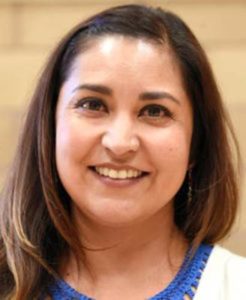
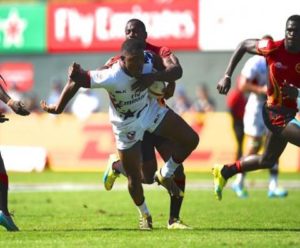
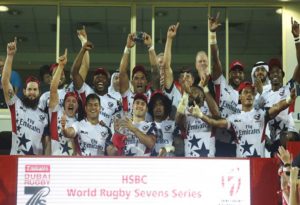
- On Tuesday, Max and I attended a Legislative Finance Committee meeting in Santa Fe. Secretary Barbara Damron made her presentation for HED and requested flat funding for the upcoming fiscal year. In my view, Secretary Damron continues to be a great friend to New Mexico higher education and works hard to advocate for us as best she can. Dr. Carruthers, the President of the Council of University Presidents, made our presentation and we collectively requested a 2% increase in funding. I certainly will not predict what will happen, but realistically, any increase is highly unlikely in my view. State revenue projections continue to decline and it is possible that HU and other institutions of higher ed will take another rescission this year. For more on the budget forecast, go here: http://www.lasvegasoptic.com/content/economists-slash-revenue-projections. Given the overall budget situation, there is no plan to fund any capital projects in higher ed for FY18, but we did, of course, pass the General Obligation Bond so the Rodgers Building renovation is likely to move forward. Some schools continue to reduce their personnel (see: https://www.abqjournal.com/904153/san-juan-college-to-enact-layoffs-due-to-state-funding-cuts.html?utm_source=abqjournal.com&utm_medium=sidebar+-+post+list+-+north&utm_campaign=post+list). Again, my approach—maintain the core mission to teach the classes necessary for our students to graduate and to the maximum degree possible, protect the people who make that happen while doing all we can to enhance our other sources of revenue. It is cold comfort, I am sure, but am thankful HU is not in Illinois (http://jg-tc.com/news/local/eastern-to-cut-personnel-by-million/article_9c0e705f-baba-5a7f-ab90-ccd5078b63f8.html). Here’s a figure everyone examined at the CUP meeting. As you can see, the value of a college degree in New Mexico (and really, every state) is undeniable, and yet….public funding for public higher education continues to decrease. How will we ever improve our state outcomes (e.g., health, social, economic, etc.) without a strong and sustained major push to provide higher education to more of our citizens?
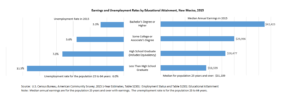
- I have made my recommendation to Governor Susanna Martinez to fill the soon to be vacant Student Regent seat. I will let the campus know once a final decision has been made on this important position. As I think most people know, our Student Regent has a full vote on the Board of Regents.
- On Tuesday evening, members of the Foundation Board participated in a discussion of good board practices led by Dr. James Lyons, President Emeritus of California University Dominguez Hills and consultant to the Association of Governing Boards (AGB). In my view, the AGB represents the gold standard for modern board practices. Jim is an interesting man. He is one of the few individuals to have led a Historically Black College and University (HBCU) and a Hispanic Serving University. He served as the Secretary of Higher Education in Maryland and currently serves on the board of two private universities. It was a great discussion and I think it was helpful in very many ways. On Wednesday, Jim met with the Board of Regents for an all-day training session. I am so grateful to the board—we had 100% participation—and a high level discussion concerning best board practices in 2016 (and beyond), the fiduciary responsibilities of board members, and establishing and maintaining appropriate board culture (what is acceptable board member behavior and what is perhaps not). We were hosted by the HU Center in Santa Fe. I should also note that the Board of Regents completed an extensive self-assessment prior to this training and the results of that self-assessment were discussed at some length on Wednesday. In short, both our Foundation Board and our Board of Regents have now received state-of-the-art training by the top organization in the nation—AGB. Several actionable items already flowed out of the AGB training. First, there was an agreement that the Board of Regents should routinely meet with the Foundation Board. There was a decision that there should be some form of ongoing board professional development and finally, the board has charged me with restructuring board meetings to decrease the time taken in routine reports by the VPs and add time for more in-depth discussions of selected HU programs and or services.

- Last weekend, several HU students participated in the ski trip to Sipapu. This is one of the excursions supported by the Campus Life fee. Students paid nothing at the gate and received a free lift pass and free ski/snowboard rentals. We transported them to Sipapu…again at no cost. The trip was advertised last week and filled within 40 minutes. A photo of the group getting ready to make the trip to Sipapu. We are so fortunate to live in a place of such natural beauty and such easy access to the natural world. It is great that our students are having these experiences. The research on “what matters” in college is pretty clear. Lots of things matter. But, the social interactions one has with new friends, getting to know people similar to and unlike yourself, and sharing healthy and fun adventures matter… a lot.
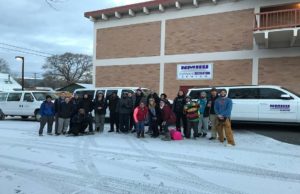
- Many thanks to all who attended the December Coffee with the President event on Thursday. This is such a busy time of year and I appreciated seeing you there and your great questions and input. We had about 40 in attendance. Again, thanks to all who took the time to attend.
- The third and final finalist for the position of Provost/VPAA was on campus this week. The search committee will provide me with a summary of the strengths and weaknesses of each individual. I will then complete some due diligence checks and make an offer…hopefully next week. Again, many thanks to Kerry Loewen and all members of the search committee who handled this so well….on time, fully professional, and in the end, put three good candidates before us. This week, we also completed the interviews for the Dean of Social Work. My goals—finish this search before the break and have a full complement of permanent (no interim) deans at HU.
- The weekly HLC update—12/9/16: This Week in HLC Accreditation: Thanks again to the over 50 volunteers who have agreed to help on the HLC assurance argument. We’ll begin our work in January. The Co-Curricular Assessment Process was approved by the Board of Regents on Friday (12/2) and will be implemented in Spring 2017, resolving probation area 4.B. Diana Marrs, Director of the Center for Teaching Excellence, has helped to design the Contingent Faculty online orientation module, an asynchronous course all our new faculty can complete to help familiarize themselves with the policies and resources of Highlands. In conjunction with the Contingent Faculty Handbook and our new Contingent Faculty evaluation process, this will resolve probation areas 2.A and 3.C.
I also previously noted the AGB training this week (see item 5 above) and that activity pretty much resolves yet another HLC issue.
Have a nice weekend my colleagues,
Sam Minner,
President
Greetings colleagues. A brief update for the week of November 28-December 2… a bit late due to the board meeting on Friday…
- This week we learned that the HU online MBA program was rated #9 in the nation by Great College Deals. The methodology in this ranking included the number of specializations and concentration areas in the program, class size, and student to faculty ratio. The overall cost of the program was also a significant factor. Well done to Bill and all who helped make this happen! We also learned this week that our nursing program was ranked 15th in the nation by NCES College Navigator. That organization rates schools on accreditation status and tuition. Well done to Susan and her colleagues and thanks to all for their hard work to earn these rankings.

- Many thanks to everyone who participated in the interviews of the first two finalists for the position of Provost/VPAA. I know that participating in these interviews is on top of what is already a very busy schedule for most people, but frankly, I can’t imagine a more important use of time. The first finalist contacted me this weekend and expressed thanks to all who welcomed her and helped her understand our many assets as well as challenges. She also expressed high continued interest in the position. The second finalist was on our campus this Thursday and Friday. One more to go.
- Several members of the campus community contacted me this week after the tragic events at Ohio State. They asked what steps we have taken or will take to prepare for such a terrible event here. I assured them that we have prepared and continue to prepare for these types of events. A few months ago, we held a significant joint training exercise with our PD, the local police, and other first responders. Later, Max and I joined the group for a discussion of the training—what went well, what needs to be improved, etc. Bottom line for me—we are doing everything we can do to prepare for these events while (obviously) hoping we never have to implement our plans. I assure the campus that the relevant folks train for these events and prepare themselves for issues on our campus.
- I imagine some of you saw the very nice story about Carmen Lopez who recently won top honors as the 2016 New Mexico Recycling Employee/Operator of the Year. Carmen was noted as having a positive attitude, engaging in numerous outreach efforts, and bringing many new innovations to our recycling efforts. In 2015, HU recycled 85 tons of material and generated several thousand dollars in new revenue. Highlands opened the Recycling Center in 2010 and opened it to the public shortly thereafter. The Center is located at 9th and Raynolds. It is so great that HU is demonstrating such leadership in this area. We should be the local leaders for promotion of a green work environment and concern for our planet…and…we are. Next challenge for me in regard to the environment—let’s drastically reduce the paper we use on this campus. The reams of paper we use to communicate with each other just has to go. It takes too much time, things can (and do) get lost, and of course, we’re killing all of those trees. Technology is usually the answer to that problem, but if you have other thoughts, I am interested in hearing them. Congratulations to Carmen!
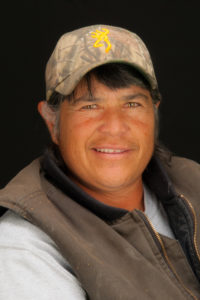
Carmen Lopez
- I have reviewed the application materials for HU students interested in serving as the Student Regent on our Board of Regents and will soon be making my recommendation to the Governor. As you probably all know, New Mexico puts a student on the board of each institution of higher education and those students have a full vote. It is fairly common to have a student on the board (about 70% of public schools do so), but much less common to allow them a full vote (only about 50% of schools do that). I have spoken with the individual I will nominate and have high confidence in this person’s ability to promote HU today and into the future. I’ll communicate with the campus more when I hear from the governor. Thanks to all students who considering throwing their hat in on this. It is a major commitment.
- Thanks to all who contributed to the HU Giving Tuesday campaign. This was our first effort to try the Giving Tuesday campaign and more than 30 friends of HU donated more than $3,000 during a 24 hour period. Thanks to everyone who contributed.
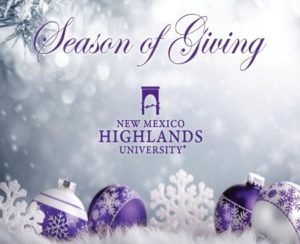
- I was in DC on Tuesday, Wednesday, and Thursday meeting with some of our elected officials and other friends of HU. I was joined by VP Baca and our Student Senate President, Mr. Julian Padilla. Some may not realize that Max actually wears (at least) two hats on our campus—the VP role plus the Director of Government Relations role. In this latter role, he keeps in close contact with elected officials and looks out for HU here in the state as well as the federal level. We met with Senator Udall, Senator Heinrich, Congressman Ben Ray Lujan, and staff members for Congresswoman Michelle Lujan Grisham—all in a single day. We made certain everyone understood the needs of HU and the many good things going on here at home. We had good discussions about how we might work more closely together to promote HU. We also met with a Foundation board member over dinner. It was a bit of a whirlwind trip, but I feel we made some good progress on several fronts. Several elected officials spoke to us about sending HU interns to their offices and I hope to engineer a plan to do that.
- I am so pleased to inform everyone that we will soon be interviewing a candidate from the Division of Vocational Rehabilitation (DVR) to possibly work on our campus. Our Director of HR, Dr. Denise Montoya, will soon be sending out a global message informing people of the many advantages of hiring candidates through DVR. Thank you so much Denise for bringing this to our campus. The DVR assists individuals with qualifying disabilities to obtain employment and live lives of dignity and meaning. The DVR helps qualified people get their foot in the door and then…it is up to them to get hired permanently and perform in the job a t a high level. HU should be a leader in this area and this represents the first step to make that happen. Well done Denise!
- This week I received the Higher Ed Performance Report Card from the New Mexico Legislative Finance Committee (LFC). It is attached (above). As you can see we received a Yellow Rating in regard to fall to fall retention rates. We were at 52.7% and the public schools in our sector were at 81%. This is not acceptable. We are just getting started with Ruffalo Noel Levitz and some new retention efforts and maybe all that will improve our performance, but….again, where we are at now is not acceptable to me and I know many others as well. We must improve. In regard to six year graduation rates, we received a Green Rating given our improvement over time. That is good, but still much to do.
- I imagine everyone saw Dr. Kempner’s message regarding volunteers for the various HLC committees we are putting together (more on that below). He informed me on Monday that he had already heard from numerous people about serving. Thank you all very much. But, we still need some additional volunteers. Please consider volunteering for one of these groups and encourage your students to do the same. Brandon did a nice job explaining the work of each group, time commitments, etc. The committees will meet for the first time in January. Please contact him and volunteer for this most important duty. We need good minds and people willing to work on those various committees.
- We held a board meeting on Friday and several agenda items were covered with a focus on the recruitment and retention assistance we are receiving from Ruffalo Noel Levitz. Dr. Martinez reviewed the technical assistance we are not getting from that firm and explained how the measure employed by RNL assist us in working on recruitment and retention. I think it is safe to say that the board was impressed with this new approach. After the board meeting, about 40 people congregated at the university residence for a board-faculty social event. I thank the members of the board for attending this event and the faculty who added a few hours to their long week to meet the board and spend some time with them.
- Dr. Kempner’s HLC update for this week: 12/2/16: This Week in HLC Accreditation: I’ve made a formal call for volunteers to work on the HLC Assurance Argument, which is due November 1, 2017. Right now, we have over 40 different volunteers from faculty, staff, students, and administration. Having a broad range of volunteers will show the HLC how seriously we take accreditation and how much as a community we want to improve our University. There is still time to volunteer, so if you’re interested in working on the HLC argument, send me an e-mail at bkempner@nmhu.edu. The Co-Curricular Assessment Process, a central requirement to resolving Probation Area 4.B, was passed by the Faculty Senate this Wednesday (11/30); it goes to the Board of Regents this Friday (12/2) and also to the Staff Senate. Track our progress in all these areas at our accreditation website: www.nmhu.edu/hlc.
Have a nice week my colleagues,
Sam Minner,
President
Greetings colleagues. A brief update for the week of November 21-25—sent a bit early due to the holiday this week:
- Last Friday I attended the Council of University Presidents (CUP) meeting in Albuquerque. All presidents received this year’s Performance Effectiveness Report (PEP), which summarizes each institution’s annual performance. The report is widely distributed to elected officials and many others. I’ll send an e-copy of the entire report soon, but here’s a preview:
- 59.1% of our resources at HU are devoted to instruction, research, and public service (our critical goals). This is a higher percentage than our national peers.
- 13% of our resources are devoted to administrative costs. This is a lower percentage than our national peers.
- Our tuition and fees are at about 54.6% or our peers. We are much lower—slightly more than half. As I have mentioned several times recently, HU is the most affordable four-year university in New Mexico and the third most affordable in the entire Southwest.
- The number of degrees we award has gone up over time. Last year, we awarded 939 degrees. In 2011-2012,we awarded 809.
- 92.5% of our students are satisfied (overall) with HU.
- Our faculty to student ratio has remained consistent. Last year the ratio was 14:1. In 2011, it was 14:1.
- Our average faculty salary is at 96.1% of the peer average; up from 94.2% in 2010.
- Our external funding is down a bit. $15.3mil last year—$17.2mil in 2013.
- In the Fall 2016, 57.4% of ours students were Hispanic and 8.7% were Native American. I am also pleased to report that the percentage of first-year Hispanic students who returned for a second year was 59.6%.
- This week, I also received our National Survey of Student Engagement (NSSE) report. There is much to like and of course, room for improvement. A few highlights:
- The biggest “perceived gain” among HU students was thinking critically and analytically. 85% of our students responded that they had improved in this domain very much or quite a bit.
- 75% of our first-year students rated their overall HU experience as excellent or good. That sounds good, but is actually less than the students at our peer institutions (84% rated their overall experience as excellent or good). However, among our seniors, 86% of our students rated us as excellent or good while 84% of students at peer institutions made that rating. My take away—ours students like us more over time.
- 28% of our first-year students participated in two or more HIPs. 49% participated in one. This compares to 11% participating in two or more nationally and 47% in one.
- We really looked great in regard to challenging students to do their best work. 55% of our first-year students felt appropriately challenged—43% of students at our peer institutions did so. Among seniors, 72% of our students felt challenged, while 62% felt similarly challenged at peer institutions. This speaks to the expectations we have for our students.
- Among first-year students, our highest performing variable relative to our peers was participated in learning communities—27 points higher than our peers.
- In terms of overall engagement indicators, our students (these were graduating seniors) rated HU significantly lower than average (compared with our peers) on the factor supportive environment. That particular construct measures things like encouraging contact among students from different backgrounds, providing opportunities to be involved socially, providing for overall well-being such as recreation, counseling, etc., and attending campus events in the performing arts, athletics, etc. Keep in mind that these senior students completed the NSSE before our Campus Life initiative was underway. HU students also rated us lower than average on student-faculty interactions and collaborative learning. Students rated HU significantly above resondents at other schools on the factor reflective and integrative learning.
Again, we’ll discuss this report in more detail at a campus-wide meeting.
- On Monday, we hosted another HLC forum—this one focusing on the fiscal issues noted by our accreditor. About 40 people attended the event and heard the progress we have already made in this area and what is still before us. Dr. Kempner led the meeting and did a great job. We had some participation at the Centers. A photo from the event:
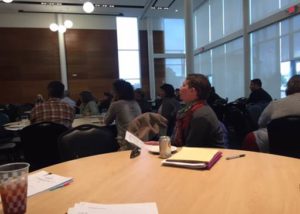
- On Monday evening, Joan and I hosted four student groups who decorated trees in the living room of the university residence. Visitors to the residence will vote on the best tree and we will host the winners at a pizza party at JC’s. A photo of some of the students finishing up their tree:
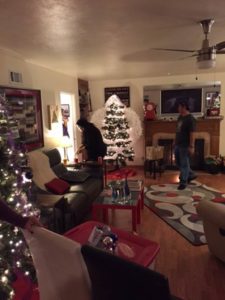
- On Tuesday, we had an Executive Leadership Team meeting and began the meeting with a brief review of our latest NSSE results (see above) and a discussion of how accreditation problems and challenges sometimes work out at public institutions. We discussed the long standing issues at San Francisco State as an example. Their accreditor threatened to pull accreditation altogether. The school sued the accreditor. This all went on for years and is still basically not settled. The remainder of the meeting was devoted to an HLC update and reports from the various units on campus. The meeting ended with an interesting discussion of some things people were thankful for. As expected, many people talked about their family and their friends. Several people commented on their jobs and the people they worked with on a daily basis. I’ve heard it said that there is really no such thing as a “good” job. When people say they have a good job what they really mean is that the work brings meaning to their life and they enjoy the people they work with. Lots of things go into a good job, I suppose, but bringing meaning to life and enjoying co-workers seems about right to me. One of my favorite quotes about thanks from Thoreau: “I am grateful for what I am and have. My thanksgiving is perpetual.”
- The remainder of Tuesday was spent on budget hearings. I am very grateful to everyone who participated in discussions at the departmental or unit level about what was needed or desired and how those budget requests fit into our strategic plan. I made a point to ask all VPs and other executives to attend the meeting yesterday where the various requests were discussed and vetted. In some cases, some units put forth many requests and it took a great deal of time to hear all of them. Therefore, the meeting scheduled for Monday will be postponed until we can hear from each of the divisions and about each request. After all the discussions to get to this point, I do not want to shortchange or minimize anything. The goals in all this—to engage the campus community more actively and transparently in the budget process, to vet each request in relation to the strategic plan, and to ultimately build a budget that has high potential to strengthen the institution and improve our outcomes.
I hope everyone enjoys a nice holiday and takes some well-deserved R&R.
Sam Minner,
President
Greetings colleagues. A brief update for the week of November 14-18.
- Last Friday was totally devoted to a Foundation board meeting in Santa Fe. VP Law and her team had prepared a full agenda including various business items, budget issues, and reports from committees. Mr. Bill Garcia was re-elected as President of the Foundation board. Several potential new members also attended the meeting. The meeting was followed by a nice social gathering at the Ranch House.
- Last weekend was packed with athletic events including two close and hard fought games by our women’s and men’s basketball teams and a competitive contest between our Cowboys football team and Adams State. Several seniors were honored at the football game. The parents of one graduating senior lauded HU for providing their son with a solid academic and athletic experience and for helping him take the next important steps in his life. The student’s mother indicated that her son would be graduating with zero debt. It was very gratifying and a high testament to the efforts of so many people at this institution. A photo of our team prior to the game:
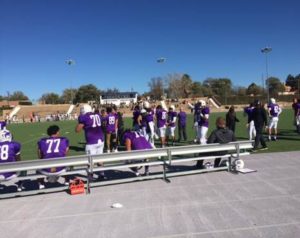
- On Monday evening, Joan and I hosted a reception for Mr. Egzon Sadiku, an Artist-In-Residence at United World College. Mr. Sadiku has been here about two months and will still will be in our area for a few more weeks. He has worked with numerous World College students and some art students from our campus. It was a very nice event with good participation from World College faculty, HU faculty, and some students from both campuses. Mr. Sadiku is a graduate of the World College (Adriatic Campus) and Macalester College in Saint Paul, MN. He is a resident of Kosovo.
- I previously informed the campus that we recently hired Mr. Mariano Ulibarri to serve as our first LANL Liaison. One dimension of Mr. Uilbarri’s duties includes outreach to students in the local community and he has taken that task on fully and with great vigor. Here’s a poster of one of his initiatives—this one, to get kids and teachers involved in coding. Mariano works in ARMAS. Well done to Mariano! This week I also met with Ms. Carol Rutten, our connection to the LANL Foundation, who also expressed high enthusiasm for Mariano’s work.
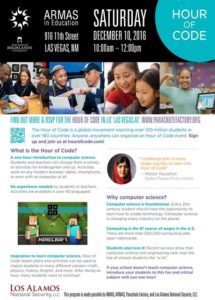
- On Tuesday evening, the Big Ideas Book Club met at the University Residence to discuss the novel Welcome to Braggsville. This was the third meeting of the club and once again, it provided a space for a wonderful and high-level discussion of important ideas in the academy and in society. This kind of meeting is what I thought my life as an academic would be like. But, what I found is that these discussions are all too rare. Little did I know…Ultimately, it is up to us to make time for these interactions. We’ll choose another book for the spring discussion and once again solicit volunteers to read the material and meet to discuss. On Tuesday evening, our discussion leader was Dr. Brandon Kempner who tried valiantly (and mostly succeeded) to keep us on track.
- On Wednesday evening, Joan and I attended the Governor’s Public Service Award Ceremony in Albuquerque where Bill and Aileen Garcia received an award for their service to the state of New Mexico. Bill is the President of the NMHU Foundation and both he and his wife are such good friends of HU. A nice HU contingent attended the event including Vice President Terri Law, Carlotta Lockmiller, Regent Sandy Turner, Tina Cordova, Regent Frank Marchi, Doyle Daves, and others. I really cannot imagine any two people more deserving of this award than Bill and Aileen and HU is very lucky that both continue to devote so much of their time, energy, and other resources to our institution and to New Mexico. Bill and his wife receiving the award:
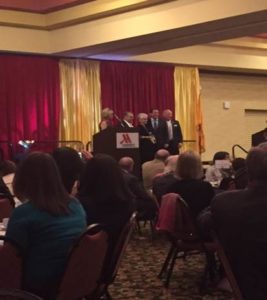
- The Campus Life initiative launched this fall term continues to grow and become an even more important dimension of life at HU. The Office of Outdoor Recreation is beginning to plan several winter activities including a ski trip to Sipapu. We offered a ski trip to that resort to the first 40 students—first come/first served. The excursion included round-trip transportation from campus to the ski area, free rental of a board or skis, a free lift ticket, and a free beginner lesson. The 40 slots were taken in a matter of minutes and given the level of interest, we intend to organize more ski trips in the future. The value of this trip is about $125.00 not including transportation—that would probably be another $25.00 or so. This single trip easily covers the entire student fee for the year so clearly, students are getting a good value for their money. Turning to other Campus Life events, on Monday, there was a sellout at the Indigo Theatre at the bi-monthly HU at the Movies night. The popular Hollywood film Dr. Dr. Strange was screened at the Indigo (again, no fee at the door for HU students with a valid ID), and on Tuesday this week, 71 HU students participated in another HU Night at JC’s Pizza where they munched on pizza, sipped soft drinks, and enjoyed some bowling. A photo of one of our students apparently having a very good time:

- There appears to be some dispute about how much money, if any, the state government has in the kitty. This from a recent article in the Santa Fe New Mexican. There is very little left to cut here at HU without significant and very noticeable cuts to programs and people. We’ll just have to see how this plays out. Again…my priorities…protect the core mission of offering the classes we require students to complete in order to graduate and to the maximum extent possible, protect the people who make that happen. Here’s the story:
The top budget executive for Gov. Susana Martinez on Wednesday disputed a contention by some state lawmakers that New Mexico continues to run a deficit, saying there actually was a small surplus in the general operating fund as of this week. Duffy Rodriguez, secretary-designate for the Department of Finance and Administration, told the Legislative Finance Committee that the most up-to-date analysis of the general fund for the 2017 fiscal year that ends June 30 shows a cash balance of about $60 million, or 1.2 percent of approved general fund spending of $5.7 billion. An analysis by Legislative Finance Committee staff, however, estimates a $100 million deficit for the 2017 fiscal year. “We have zero reserves” to cover a deficit, committee Chairman John Arthur Smith, D-Deming, said. “In all likelihood, we’re going to have to make additional cuts.” Asked after the committee hearing about the projected deficit, Rodriguez said, “I don’t know where that’s coming from.” In a special session that ended in October, the Legislature rebalanced the budget for both the 2016 and 2017 fiscal years, cutting spending about 5 percent across government and transferring balances from dozens of accounts to cover day-to-day expenses in areas such as education and law enforcement. Legislative Finance Committee staff made the projection of a $100 million deficit after looking at solvency bills and spending cuts approved during the session. The possible deficit raises the prospect of further spending cuts to agencies already struggling to maintain payrolls and services. State Supreme Court Justice Charles Daniels told the Legislative Finance Committee on Tuesday that spending cuts so far for the judiciary could result in employee furloughs. Chief Public Defender Bennett Baur also said his office is leaving jobs unfilled and is turning away some new clients. Smith said lawmakers have been more conservative in their budget outlooks than Martinez as a way to try to get ahead of any necessary spending cuts. So far during the budget crunch, they have been right. Smith was among those who called for a special session last summer. Rodriguez said new economic data, including projections of tax revenue, for fiscal years 2017 and 2018 will be released early next month by a group of forecasters that meet quarterly. That will then be used by lawmakers and the Governor’s Office to set agency spending levels. The general fund had more than $700 million in cash reserves in June 2015, but a rapid decline in state revenue has led to the unprecedented depletion of balances throughout state accounts. The fiscal troubles led Moody’s Investors Service to downgrade the state government’s bond rating and give it a negative outlook going forward. That move will probably lead to slightly higher borrowing costs for state and local governments. Rodriguez told the Legislative Finance Committee that Martinez will present a budget to the 2017 Legislature in January that would restore general fund operating reserves to 5 percent by June 30. The governor also plans to raise that to 10 percent at the end of the 2018 fiscal year. “We want to return reserve levels to 5 percent and then up them to 10 percent as soon as possible,” she told lawmakers. Smith asked Rodriguez how Martinez hopes to reach her goal of 5 percent of reserves, about $280 million, in just seven months. The secretary-designate said she has had discussions with the Legislature’s top budget staffer, David Abbey, and they are looking at several options. Smith disputed that. “I’ve already had that discussion with Mr. Abbey, and he said, ‘I don’t know what she’s talking about,’ ” Smith said. “Quite frankly, we don’t know where we’re at with reserves.” A revenue tracking report released Wednesday shows that through August the general fund was running a shortfall, but it was smaller than expected. The tracking shows that gross receipts tax revenue in the state was down 8 percent from a year ago, but some of that is already baked into the pared-down budget. Overall, revenue in the first two months of the fiscal year — July and August — was running $19 million short of what is needed to balance the budget. Smith and other Democrats in the Legislature have been saying for two years that the state cannot dig out of its fiscal crisis without new tax revenue. Several efforts to do that — from increasing the gasoline tax to taxing sales from out-of-state internet companies such as Amazon — were rejected by Martinez and the House of Representatives, which has been led by Republicans since 2015. As a result of the Nov. 8 election, Democrats will have a majority in both the House and the Senate when the Legislature convenes in January. That means some of the tax-revenue measures can move forward but likely will face a veto from the governor. Martinez has pledged not to increase taxes. Lawmakers said Wednesday that efforts are underway to identify revenue-increasing measures that would be supported by both Democrats and Republicans. With bipartisan support, the House and Senate could override any Martinez veto. “To build reserves we’ve got to get some revenues,” Smith said.
- I feel it is very important that HU reach out more powerfully to our elected officials in DC and toward that end, Max and I will be spending a few days in Washington. We have numerous appointments set up with elected officials and a few social/alum/Friends of HU events scheduled as well. No one quite tells the story like a student so Julian Padilla, President of the Student Senate, will be accompanying us on this excursion.
- We’ve been producing numerous new promotional materials and they are quite nice. Take a look at our electronic Viewbook:https://spark.adobe.com/page/GMNOMFGNyV2MI/.
- On Thursday, we received notification from the American Chemical Society (ACS) that our chemistry program meets all of the requirements for continued accreditation and is approved until our next visit in 2021. Congratulations to Dr. Sammeth and everyone who contributed to this successful visit.
- On Thursday evening, Joan and I hosted a Power of Excellence event at the University Residence, This one focused on individuals who have supported HU by virtue of their personal donations. Many thanks to Provost Carol Linder for organizing these events.
- Today, Max and I will attend the CUP meeting in Albuquerque. The CUP is banging out an agenda all the presidents can all get behind to put before legislators in the upcoming session. These are tough times for public higher ed and it is more important than ever that public schools work together and collaborate on win-win initiatives. I hope to be back in town in time for the Flamenco dance performance and I hope to see you there. It promises to be a special event.
- This Week in HLC Accreditation. We have our next HLC forum on Monday, 11/21 from 3-4 PM in the SUB Ballroom. Our Zoom link will be https://nmhu.zoom.us/j/910223218. Please join us, but if you aren’t able, we record these and link them on our HLC forums page, http://www.nmhu.edu/accreditation-information/forums/. We’ll be discussing the Strategic Budget concerns raised by the HLC, Area 5A, and our plans to resolve them. We’ve also updated the link on our main www.nmhu.edu page to link to the full Accreditation website. We’ll be using this website to present our action plans and to archive evidence of our accomplishments. We want this to be a transparent process, so if you’d like any additional information to be linked on the website, please let me know at bkempner@nmhu.edu
Have a nice weekend,
Sam Minner,
President
Greetings colleagues. A brief update for the week of November 7-11:
- The HU Office of Outdoor Recreation continues to make arrangements with businesses in the region to provide healthy and fun recreational opportunities for our students. As the weather gets colder, the Outdoor Recreation team has been working with local ski resorts. We are close to making final arrangement with one resort which will (hopefully) be of great interest to our students. Once this is finalized, HU students will take HU transportation to the ski area and will be provided with a free snowboard or ski rental and lift tickets. We’ll be able to accommodate a set number of students—first come/first served. Ideally, we’ll be able to make arrangements with a second ski resort soon. Many thanks to Ms. Kim Blea, Mr. Joseph Dominguez, and the entire Campus Life team who are making this happen.
- The Executive Management Team met Tuesday and we began the meeting with a discussion of the reduction in state budgets in various states and how those have impacted public higher education. To read the brief article, go to: http://www.nytimes.com/2016/11/06/education/edlife/college-budgets-affect-your-education-but-its-not-all-bad-news.html?ref=edlife&_r=0. As you can see, cuts in public higher education have ranged from an incredible 54% in Illinois to 28% in Wisconsin to 30% in New Mexico. A few states have increased the funding to public higher education since 2008 (e.g., North Dakota and Wyoming), but the significant downtown in the extraction industry has recently also been felt in those states. We debated the questions: Does anyone think that funding will come back to the pre-recession levels and if not, what should we do? The consensus opinion was that funding levels are not likely to return to pre-recession levels. Assuming they do not, what to do? It was a good discussion all the way around. Some individuals believe that, if trends continue, the situation will become so bad that many Americans will not be able to send their sons and daughters to university and at that point, we’ll have a serious national conversation about the appropriate role of state government in public higher education.
- I attended the UNLV-HU basketball game last Friday. The Cowboys had a good showing against the Division I Runn’in Rebels. There was a very nice Friends of HU/Alumni event prior to the game and several HU fans attended the contest. A photo from the game and the Friends of HU event. I should note that this trip was memorable one for me. A few minutes after checking in, the entire hotel (more than 3000 guests and 800 employees) was evacuated due to a total power outage. Joan and I were located on the 18th floor and negotiated an interesting walk to the lobby in total darkness. The guests were in a upbeat mood for some time. It was all kind of exciting and unusual. However, it took nearly 24 hours to get the power back on and people were not quite so happy about that. I should also note that during the long drive from LV (NV) to LV (NM) we encountered a brief but very intense hailstorm about 20 miles west of Albuquerque. The hail was piled up maybe two feet in some cases resulting in numerous vehicles off the road and extremely hazardous conditions. Welcome to New Mexico!
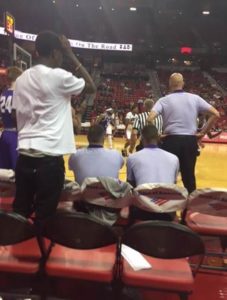
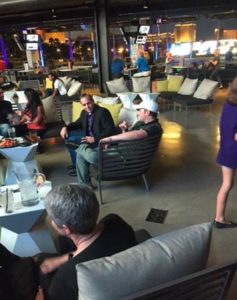
- The election has come and gone and Bond C passed. Thank you, thank you, thank you, thank you to everyone who voted. We will immediately start planning for the renovation of Rodgers. I should also note that Bond B passed. That measure will provide some much needed resources to our library.
- Dr. Craig Conley recently accompanied a group of our students to Madison to attend the Society of American Foresters conference. These excursions mean so much to our students and play an important role in their professional development. A photo from the event:
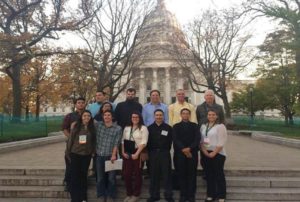
- HU has been asked by the Office of the Attorney General in partnership with the Department of Higher Education to host a special Conscious Campus event to address issues of sexual violence on college campuses in New Mexico. Other schools invited to participate in this program include UNM, NMSU, and Eastern. The event will include a screening of the documentary film The Hunting Ground, a discussion of the film afterward, and a Stakeholder’s Square where information about services and programs will be provided to interested parties. Many thanks to Ms. Kim Blea for bringing this program to HU. More on this later as dates and final arrangements are set. Here’s a link to the film: http://www.imdb.com/title/tt4185572/.
- On Wednesday, several individuals participated in a demo of Slate—a Customer Relationship Management (CRM) system used to manage recruitment activities. Here’s a link to their website: https://technolutions.com/. CRM’s (there are many of them) are used in most recruitment operations to send messages, sometimes highly targeted messages, to prospective students. To the best of my knowledge, we have never used them here at HU. Basically, we have an employee send individual emails or texts to prospective students and as you can imagine, it is very time consuming and inefficient. In our current process, things fall through the cracks all the time. A CRM does this for you and provides good analytical information to inform your practices. There has been no decision to purchase this product, but we do need something to help us with this task. We are basically managing this the same way it was done many decades ago. Our downward enrollment trend suggests that new solutions must be tried. Dr. Martinez has stopped using some ineffective and or inefficient services in student recruitment, which frees up some resources to possibly acquire Slate or some other CRM. More on this later.
- This week I made the final arrangements for the AGB Board of Regents and Foundation Board workshops. Both will be held the first week of December. This week, the Board of Regents were also sent the board self-assessment instrument from the AGB. The results from that self-assessment will be discussed at the workshop in December. The time for students to apply for the Board of Regents Student Representative is now over. A committee will provide me strengths and weaknesses for all applicants and I will make a recommendation to the Governor. Our Student Regent, Ms. Ryan Andrews Armijo will come off the board at the end of this year. Ryan has represented the students of HU very well and I thank her for her service.
- On Thursday, I attended the CESDP’s 25th Back to School Family and Youth Institute. I attended this meeting last year and once again, it was a 2wonderful program. I brought greetings from the main campus and heard several nice presentations.
- This Week in HLC Accreditation. The Retention Summit last week was well-attended, generating specific ideas on how to address our retention and persistence issues, including improvements in academic alignment, cross training, internships, advising, and admissions. Now that the Board of Regents has approved the Retention Plan and the Retention Advisory Committee has been formed, Highlands is making good progress towards resolving this probation area. A draft of the Co-Curricular Assessment process, another major probation area, has been completed and sent out to impacted programs for feedback. This process will be completed by January 2017, giving us a full year to collect data to present to the HLC in November. Lastly, the new Budget Process continues to be implemented. Individual units have submitted their budget requests, and budget hearings are currently taking place. Budget prioritization by the Executive Management Team will take place the week of November 21st, with a full budget presentation to the campus shortly afterward.
Have a nice weekend my colleagues,
Sam Minner,
President
Greetings colleagues. A brief update for the week October 31-November 4.
- The Board of Regents met last Friday and heard various reports and took several actions. Among them:
I briefed the Regents on the College Board’s 2016-2017 list of most affordable four year universities by region. Once again, HU is the most affordable four-year university in New Mexico and the third most affordable four-year in the entire Southwest. I mentioned to the Board that affordable tuition is very desirable, but that being as affordable as we are really means that we are extremely reliant on state support. When that support decreases (as it did this year), it cause major ripples throughout the institution. For purposes of comparison, I also briefed the board on the tuition rates of a few comparable institutions and one that is really not quite so comparable. If our rate was the same as Western’s, we’d accrue about $4mil more per year. If we assessed students the same rate as Adams State, we’d accrue about $12mil more per year. If we assessed a tuition rate equal to that at Colorado School of Mines (and I pointed out to the board that CSM had a very different mission and is really not all that comparable to us), we’d accrue about $36mil more per year.Enrollment is on everyone’s mind, and Dr. Edward Martinez presented his work on the formation of the Retention Advisory Council and a four-year retention plan. Eighteen Highlands faculty and staff comprise the Advisory Council. Combined with the strategic tools from Ruffalo Noel Levitz, I am confident we will see a substantial impact in our retention efforts and these actions will also address some of the concerns of our accreditor.Highlands’ new director of recruitment, Jessica Jaramillo, unveiled the university’s new online tour to the Regents. The tour will go live in a few weeks and will showcase our campus to prospective students across the country. The recorded narrative will be in three languages: English, Spanish and Navajo. The tour also comes with a virtual reality feature so our recruiting staff can give students a sense of what it’s like to actually stand on our main campus.Professor Angela Meron presented components of Highlands’ visual identity proposals to the board. The Board will vote to adopt a complete branding policy at its next meeting.Dr. Brandon Kempner provided an update on our accreditation progress as he will for every upcoming board meeting. Under Dr. Kempner’s leadership, we are making great strides to ensure we have the documentation in place to remove Highlands from probationary status. The university community may follow our progress online at www.nmhu.edu/hlc.On the financial side of the house, the Regents approved the university’s fourth-quarter financials, approved a resolution recognizing Highlands new collective bargaining unit, and approved a motion to negotiate a food service contract with Sodexo, a national firm that provides service to schools, hospitals and universities across the country. Vice President Baca also reported on the impact of the university’s state funding. We can expect to see deeper cuts next year, however, the Board of Regents and I are committed to preserve our core mission and work collaboratively with HU staff and faculty to improve our outcomes.
- Everyone is anxiously awaiting the new legislative session and there are many concerns about what will come out of the session for higher education. Max and I met with Marc Saavedra this week in preparation for the next CUP meeting. An interesting article about the NM budget from the New Mexican:
Projections: $100 million state budget gap remainsBy Bruce KrasnowJust days after Gov. Susana Martinez signed measures into law to eliminate unconstitutional budget deficits, lawmakers were greeted with a current operating budget that is still $100 million short and has no cash reserves, as well as a request for at least $80 million more in Medicaid funds for the next fiscal year. Wednesday’s meeting of the Legislative Finance Committee also came a day after a credit downgrade by Moody’s Investors Service, which lowered the bond rating for state borrowing. In a report issued Tuesday, Moody’s cited New Mexico’s volatile revenues and the rapid depletion of cash balances in its decision to change the state’s rating for general obligation bond debt from the top tier, Aaa, to the agency’s second-highest rating, Aa1.The change will result in slightly higher borrowing costs, perhaps $200,000 a year, according to some economists. More important is that Moody’s lowered the long-term outlook of the state from stable to negative, which means state spending decisions face more scrutiny in the coming year, and an even lower credit rating is possible. During a recent special legislative session, lawmakers approved spending cuts to most state agencies and transfers of unspent money from several accounts into the state’s general fund to close shortfalls totaling more than $600 million for fiscal years 2016 and 2017. But the actions were not sufficient. Lawmakers learned Wednesday that updated estimates indicate state revenues for fiscal year 2017, which began in July, are still $100 million short of what’s needed.Sen. John Arthur Smith, D-Deming, chairman of the Senate Finance Committee, was among the lawmakers who pushed for measures that would have brought in more tax revenues so the budget could be balanced with less one-time money. He supported a tax on internet purchases from out-of state companies such as Amazon and also argued for an increase in the gasoline tax. Those efforts were rejected by Gov. Martinez and House Republicans, who say any new taxes would hurt economic growth.Smith reiterated Wednesday the need for more stable revenue sources. He said the state needs to diversify its tax base away from oil and gas revenue, and that means working on an agreement with the governor on a wide range of measures that can stabilize the $6 billion general fund.“We’ve got to have an agreement that can move us, and we’re a far cry from that right now,” he said. One-third of all general fund revenue is in some way tied to the energy sector. In June 2015, the state had more than $700 million in cash on hand for operating reserves. It also had more than $220 million in tobacco settlement money, invested in long-term equities, and $147 million stashed in a tax stabilization account for emergencies. All that money, more than $1 billion, is now gone, and general fund reserves are projected to be just $30 million at the end of the 2017 fiscal year.And Wednesday, lawmakers heard that the state Medicaid program will need $80 million to $100 million in additional money to continue providing all current services to its 874,000 patients in fiscal year 2018, including 250,000 low-income adults who now qualify for the health coverage through expanded eligibility rules under the federal Affordable Care Act. Medicaid spending is expected to reach $7.3 billion in New Mexico next year, but 80 percent of that will come from the federal government, which matches dollars spent by states. The state’s general fund contribution to the program is expected to increase 11 percent, to $1.1 billion, if the Medicaid request is approved. This year, New Mexico moved to cut Medicaid payment reimbursements to doctors, therapists and hospitals to help fill a budget gap. Human Services Department Secretary Brent Earnest said his budget request for 2018 includes copayments for adult Medicaid patients’ emergency room visits and brand-name medications, pending approval by the federal government. Copayments are common in private insurance plans so patients share in the cost of health care, perhaps picking less expensive generic drugs instead of brand names. But Medicaid patients are often too poor to afford copays, so the cost of collecting the money falls on doctors and hospitals. Earnest said any copay system has to balance that consideration. Lawmakers also heard from an economist at Moody’s Analytics, a sister company of the ratings agency. Dan White said states around the country are grappling with reserve funds and trying to find the right level to cushion their volatility, especially during recessions. He said there is no magic percentage, but most states’ reserve funds average 3 percent to 4 percent, with some as high as 6 percent. Whatever New Mexico decides, he said, it needs to move forward with a plan to replenish its rainy-day funds in anticipation of the next downturn. “What the rating agencies want to see is a plan,” he said. Senate Minority Leader Stuart Ingle, R-Portales, agreed. “We’ve got to come back and make some tough decisions,” he said. - Saturday was a busy one with a football game, a Vatos game, and the Mana Del Norte Scholarship Banquet in Santa Fe. I am pleased to report that HU was very well represented at the banquet. Our own Dr. Thomasina Ortiz-Gallegos served as the Mistress of Ceremonies and did a fantastic job. Several HU students were awarded scholarships and a nice contingent of HU staff and administrators cheered our students on. Many thanks to Ms. Carolina Martinez, Dr. Edward Martinez, and Ms. Kim Blea for devoting a precious Saturday evening to this event. A photo from the banquet:
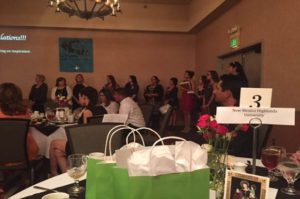
- Please vote on November 8. Proposition C is toward the end of the ballot. New jobs for San Miguel County. The renovation of another historic building on campus including the WPA era murals. No new taxes.

- Several good colleagues volunteered for the “pie in the face” fundraiser benefiting breast cancer research. The “winners” each got a gooey pie in the face at a special event in the SUB. Those winner are, from left to right, Dr. Brandon Kempner, me, Dr. Bill Taylor, and Coach Jeff Mills. Many thanks to Ms. Margaret Gonzales and her team for organizing this event.
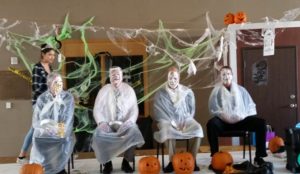
- Basketball season begins this week and our first game is against the Running Rebels of UNLV. The game will be played at the Thomas and Mack Center in Las Vegas, NV. A nice contingent from HU will attend an alumni event prior to the game. You can watch the game at home on Stretch Internet. Just log on to the NMHU athletic site and click on Stretch Internet.
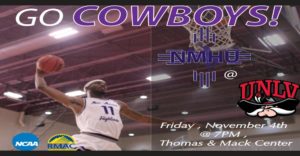
- HLC Update: This week I finalized the arrangements for the Association of Governing Boards (AGB) to conduct some board training for both the Foundation Board and the Board of Regents. The AGB is the gold-standard of how modern boards work and what best practices look like today. The AGB will also conduct a board self-assessment (for the Board of Regents). These actions will ensure that both of HU’s boards are acting in accordance with best practices and are familiar with contemporary issues in the oversight of the institution. Our consultant (I’ll reveal his name once we sign the contract with AGB) could not be a better fit for us. He served as President of a Hispanic Serving Institution, has deep experience with accreditation issues (the school he led was experiencing challenges very similar to those here), and worked with a number of boards over the years. His work with our boards will not only provide members with new and cutting-edge perspectives on how boards should work, but will also address a number of our HLC concerns.
This week’s HLC update from Dr. Kempner:
11/4/16: This Week in HLC Accreditation. First, the HLC FAQ Student trifolds are in—if you’d like to have copies to pass out to students or have available in your office, either e-mail me at bkempner@nmhu.edu or drop by 104 Rogers in the mornings to pick them up. This should be a good document to answer student questions, and can also serve as a script if students call or e-mail you. Second, Dr. Edward Martinez and the Office of Strategic Enrollment Management are hosting a two-day retention summit on campus this week, Thursday 11/3 from 12:30-4:00 and Friday 8:30-3:30 in Sala de Madrid. This forum will help address the Retention Probation Area of the HLC concerns, as we work together to find better ways to make data-driven decisions to help our students succeed here at Highlands. Please drop by some or all of the summit.
Have a good weekend my colleagues.
Sam Minner,
President
Greetings colleagues. A brief update for the week of October 24-28:
- This week I received information from the College Board pertaining to the most affordable four year schools by region. Once again, HU is noted as being extremely affordable—the most affordable four-year in New Mexico and the third most affordable in the entire Southwest. See the attachment for the complete list. It is highly desirable to maintain a very affordable tuition rate (as we do), but the net result of that is that we heavily rely on other our other major support of revenue….state government. If your tuition is very low and your partner (state government) reduces funding, the institution feels it very powerfully and that is certainly the case at HU. The Governor recently signed the final bill coming out of the Special Session and we will indeed realize a 5% cut in this year’s budget. That is in excess of $1.5mil and of course, that is on top of the cut we took July 1. To put our tuition rate in perspective, if we were Colorado School of Mines (I know that is a different intuition with a different mission and different students) and we charged students their tuition rate, we would accrue approximately $36mil in additional tuition revenue per year. Thirty-six million dollars…per year. Each and every year. If we charged the same rate as Adams State (an institution actually very much like HU), we’d accrue about $12mil more each and every year. If we assessed students a rate identical to Eastern’s (the 4th most affordable in the Southwest), we’d have about $360K more to spend each year. I am not advocating that we assess our students rates like those at other schools, but it is important that everyone understand the relationship between tuition rates and state support as well as the rather incredible differences between what we accrue in tuition revenue here and what other schools bring in. Here’s a recent article about the state budget (http://www.santafenewmexican.com/news/legislature/projections-million-state-budget-gap-remains/article_af794785-1e73-5f58-8ef2-5492b7e8385f.html) and another piece noting that, as anticipated due to our low state reserves, the reduction in our state credit rating by Moody’s (http://www.kob.com/politics-news/moodys-investor-services-financial-standing-budget-solvency-new-mexico-legislature-governor-susana-martinez-lawmakers-credit-rating-finances/4302493/). As we move forward to make certain of the solvency of the institution, I remind everyone of the driving goals during this most challenging fiscal environment—the provision of classes our students need to graduate on time and to the maximum degree possible, the protection of our people who make that happen (i.e., no furloughs or layoffs if at all possible).
- Faculty members—please mention to your students that the Mexican American Law Student Association and the Native American Law Student Association from the UNM School of Law will sponsor a free practice LSAT to all interested HU students on November 12 at 10:30 a.m. The practice exam will be administered in the SUB, Room 322. A panel will discuss the LSAT immediately after the practice exam and a free lunch will also be served. This is a tremendous opportunity for HU students. Totally free.
- Last weekend was busy with several athletic events including a beautiful day at Perkins complete with an opportunity for those wanting to imbibe during the football game and a very loyal fan base who support our Cowgirl and Cowboy student athletes. We took in several thousand dollars in ticket sales and concessions at the game. AD Clifford has been strategic in thinking about these revenues and is making some headway. These funds go right back into HU athletics to partially offset the reduction in their budget. A photo of the pre-game warm up at the stadium on a beautiful Fall day:
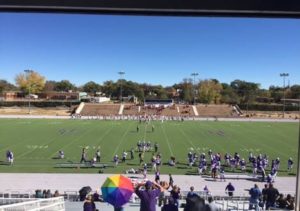
- Please join me in congratulating Dr. Denise Montoya, our new HR Director, upon her election to the Advisory Council of the Society for Human Resource Management (SHRM). Founded in 1948, SHRM is the world’s largest HR membership organization devoted to human resources management. The organization serves more than 275,000 members in over 160 countries. Well done Dr. Montoya!
- The Search Committee for the new Provost/VPAA is making good progress and is on schedule. I hope to receive their recommendations next week. We’ll attempt to interview the finalists in November and make an offer by the end of the term. The applicant pool was very large and the advertisement attracted a great deal of talent. We attracted internal, national, and international applicants. Things are on track. Many thanks to Professor Loewen and members of the Search Committee. Things are also moving forward on the Social Work Dean’s search.
- On Monday and Tuesday, AD Bob Clifford, Ms. Karin Gadberry, and I attended the RMAC meeting in Golden, CO. The focus of the meeting was on student athlete mental health. According to the Chief Medical Officer of the NCAA, this is the #1 problem facing student athletes. Not money. Not wins and losses. But, overall mental health, particularly depression. The sport psychologist we heard asserted that depression was increasing among student athletes for many reasons, but was at least partly due to sport specialization. Kids start in a sport at younger and younger ages and often define themselves more and more that way…I am a football player, I am soccer player, I am a softball player, etc. Then, when there is some problem—they do not make the team, they do not advance to the college level, they do not perform well, they do not start, etc.—they sometimes crash and for some, the crash can be quite devastating. It was a good discussion and mostly new information for me. The RMAC Commissioner praised AD Clifford for the “all Nike” designation (first in the RMAC) and praised our student athletes who also attended the meeting and participated in the mental health discussion as well as a meaningful service learning project. In a notable action, the President and the AD at Dixie State University (St. George, Utah) made a presentation to come into the RMAC and their application was unanimously approved. Their new football stadium (thanks to a $10mil private gift) will be a thing of beauty and will also serve various academic and co-curricular functions. Just as an aside, during the long drive from Golden to Las Vegas, NM, I passed an eighteen wheeler and happened to glance into the cab. No driver. I looked at the signage on the truck and it was a driverless experimental vehicle. A brave new world, no doubt.
- I have received a request from the Faculty, the Staff, and the Student Senates to screen the film Starving The Beast and I have asked Ms. Donna Martinez to order the film for screening in Ilfeld. Here’s a link about that film: https://www.insidehighered.com/news/2016/03/22/starving-beast-examines-ideological-shifts-funding-higher-education. The film will be screened on November 29 from 5-7.
- Please remember to vote on November 8. General Obligation Bond C appears toward the end of the ballot and that is the measure which, if approved, allows us to do another important historical renovation on campus. An affirmative vote of the people will bring new jobs to San Miguel County and will not result in any new taxes.

- On Wednesday I welcomed an enthusiastic group of high school students to campus. These students were all members of New Mexico Mathematics, Engineering, and Science Achievement (NM MESA) and all interested in STEM disciplines. MESA supports student programs in middle and high schools throughout the state. Each program is administered by a math or science teacher from the school who receives a stipend for this work. Students participate in enriched math and science activities including field trips, speakers, workshops, academic competitions, community service and leadership projects. Those students all participated in our College Night on Wednesday evening. That event was jointly sponsored by HU and LCC and was well attended by students from throughout the region including a significant number of students from the two high schools in town. Students were able to chat with faculty and staff from both institutions and enjoyed a nice meal afterward. A photo from the MESA event:
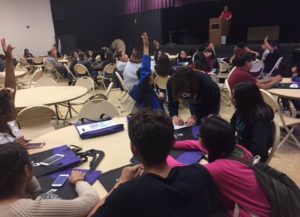
- Many thanks to Professor Donna Woodford-Gormley who saw me walking the halls of Sininger on Thursday and kindly invited me into her class to say hello to her HU class as well as a parallel class meeting in Puerto Rico. I shared my many pleasant experiences in Puerto Rico and one less than great memory—a fender bender in Ponce. The potential impact of connecting our classes and our students with others around the world is incredible.
- I hope to see some of you at the next Vatos game. The game is on October 29 at 6:00 p.m. in Perkins. Show up and cheer for our national champion Vatos. A few days ago, my seven year old granddaughter asked me how the Vatos were doing this year. She is a true fan. Go Vatos!
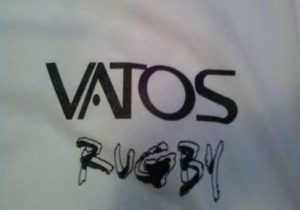
- A board meeting is scheduled for Friday. I’ll provide an update of the actions taken by the board next week. I’ll be attending the football game on Saturday and the Mana del Norte banquet in Santa Fe on Saturday evening. Several HU students will be recognized at that banquet.
Weekly HLC Update: Last Friday, I met with Secretary Barbara Damron and her associates to brief her on the actions we are taking here to respond to the concerns of our accreditor. I assured her that everyone here—the administration, the faculty, the staff, and the Board—were working together to get this done and that everyone understood the seriousness of the issue. She thanked me for the briefing and offered her help in assisting us. In my view, she is a wonderful friend of NM higher education and we are fortunate that she is in that position. Here’s a brief summary of the actions we’ve taken thus far to inform the campus and others of the actions of our accreditor. I should note that we received formal notice on September 8 so all of these activities have taken place over the last seven weeks. If anyone has additional thoughts about what else could be/should be done to get the word out more powerfully, just let me know.- numerous written campus communications to all faculty and staff
- targeted written communication to students
- multiple presentations to the Student Senate
- presentation to New Mexico HED
- interview in the Las Vegas Optic (HU initiated that interview)
- numerous campus fora
- updates in every weekly message from the president
- notice on our website
- HLC Q&A site
- Facebook live Q&A session
Here is Dr. Kempner’s weekly update on this topic:
10/28/16: This Week in HLC Accreditation. We held a number of forums and meetings this week to make sure the entire campus community was up-to-date on our progress with the HLC probation: a campus-wide forum on Monday (10/24), an HLC update at the General Faculty meeting on Wednesday (10/26), a Facebook Live event with students on Thursday (10/27), and an update to the Board of Regents on Friday (10/28). If you weren’t able to attend any of these, you can access a Zoom recording of the Monday forum at http://www.nmhu.edu/accreditation-information/forums/.
Have a good weekend,
Sam Minner,
President
Greetings colleagues. A brief update for the week of October 17-21:
- Joan and I participated in the Homecoming parade for Robertson last Friday. It was a nice event with large crowds along the way. Many thanks to our Student Ambassadors who also participated.
- On Sunday, I had lunch at the Rio Mora Refuge with representatives from the Forest Service and the Denver Zoo. HU has had a long collaboration with these partners and many of our students and faculty have completed some nice projects on the Refuge. Fiscal challenges abound, but we are all working together to continue and possibly deepen the partnership. At left, a photo of the bison herd on the Refuge. If you look very closely, you can see a new calf born about a month ago. On the right, a photo of the Refuge on a beautiful Fall day. Below, a nice picnic lunch with partners from the Refuge and the Denver Zoo.

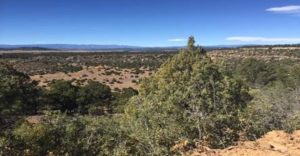
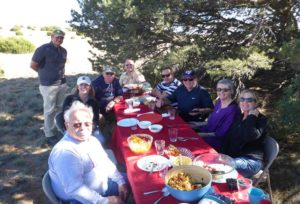
- We continue to produce some new and more attractive recruitment materials for the Fall, 2017 class. Here’s a trifold we recently produced. Notice the use of our new theme (“family”) and also touching on an outdoors theme connecting the campus to the region. We are also nearly done producing our disciplinary brochures. Open the attachment above to see them.
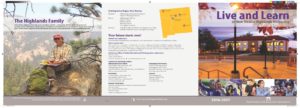
- On Tuesday morning, I drove to Santa Fe to participate in the Los Alamos National Lab Community breakfast. I was accompanied by Mr. Mariano Ulibarri, the new Highlands University LANL Liaison. This position was funded by a generous gift from LANL. Mariano will be working at ARMAS on a variety of projects including some significant K-12 outreach.
- Several weeks ago I asked Mr. Ron Garcia to reengineer our processes and website related to student employment. He has done a good job with that and he is nearly done. One site is for students looking for jobs and the other provides a detailed and complete process for hiring students. The goal here is to make it as easy as possible for students to find jobs and to make it as easy as possible for HU faculty and staff to complete the hiring process. Here’s where we are at this point:
- Student Jobs webpage, http://www.nmhu.edu/career-services/jobs/ This webpage provides links for all student employment including On-campus Jobs, Off-campus Part-time Jobs, Internships and Summer jobs, and Professional Jobs. Click on the On-campus Jobs link to view job announcements for departmental, work-study, and graduate assistant (GA) positions. The On-campus Jobs webpage also provides a link to the Application Process, which includes the basic steps and the required forms such as the applications forms for student employment and graduate assistantships.
- Hiring Students webpage for Faculty and Staff, https://www.nmhu.edu/career-services/jobs/ The Hiring Students webpage can also be accessed by clicking on Faculty or Staff on the NMHU website. This webpage provides required forms and basic instructions to process your student hiring.
My overall idea is to do what we can to bolster our Career Services operation. I am certainly not suggesting that our operation is deficient in any way. On the contrary, I think the folks have done and are doing a good job, particularly given the resources we have devoted to it. But, I think in the 2016 economy and the needs and interests of our students at HU, building a very high performing career operation is extremely important. Finding the resources to do it will be challenging, no doubt, but I think it is important to try. My ideas about what such an operation might look like are very much influenced by Andy Chan at Wake Forest University. He served as a consultant to a redo of Career Services when I was at Radford. Here’s a YouTube of Mr. Chan that will provide deeper insight to the overall approach: https://www.youtube.com/watch?v=6Tc6GHWPdMU. Please forgive the commercial for Grammarly—I couldn’t figure out how to take it out. Ron will soon be taking on a related project connecting our students with volunteer alums.
- On Wednesday, the College Navigator Database named HU as the #3 most affordable college for online international education MBA programs. Over 500 schools were ranked. The most affordable online MBA is the University of North Dakota. Other highly ranked schools include Liberty University (#9), Tennessee Tech (#15), the University of Wisconsin (#17), and the University of Nebraska-Lincoln (#18).
- There was a state-wide Maine Street meeting in Las Vegas on Wednesday and I was on panel discussing how HU was working with Main Street to promote economic development along the Maine Street Corridor. An enthusiastic group heard my talk and had many questions about how things were working and what we might do in the future.
- On Thursday, Joan and I hosted the October Power Of Excellence celebration. At this get-together, we celebrated HU authors. It was a very nice event. I thank Interim Provost Carol Linder for conceptualizing this initiative. We face so many challenges each and every day and it is important that we also devote some time and energy in celebration of the incredible things happening at HU. The work of these authors is but one example.
- Planning for Homecoming 2017 is already underway and on Friday, I met with the committee leading this effort. We discussed each 2016 Homecoming event, what we wanted to change for next year, and new ideas to keep Homecoming exciting for all participants. Ms. Juli Salman and Ms. Margaret Gonzales are the co-chairs. If you have ideas, please connect with one or both of them.
- HLC Update: Things are moving forward very nicely on the initiatives to address the various HLC concerns. Here’s the update from Dr. Kempner:
This Week in HLC Accreditation. We have our next HLC Update Forum on Monday, October 24th, 3-4 PM, in the SUB Ballroom. Our Zoom link is https://nmhu.zoom.us/j/910223218. This will include updates on the Mission, Action Plans, and our HLC website. This week, I held meetings with the Co-Curricular Group (10/21) to finalize Co-Curricular Assessment, with Deans and Chairs (10/21) to discuss Contingent Faculty Orientation and Evaluation, and with the HLC Steering Committee (10/20) to discuss our progress and action plans. Our student trifold handouts are completed and will be printed soon; you can see a copy here: https://its.nmhu.edu/IntranetUploads/003894-HLC_web-10172016111047.pdf. We’ll also be arranging for either the President or me to visit classes to answer any probation related questions.
Have a nice weekend.
Sam Minner,
President
Greetings colleagues. A brief update for the week of October 10-14:
- I thank all who attended any of the Homecoming events last week. There were simply too many of them for me to attend everything, but I particularly enjoyed the Homecoming parade, the H-Club Banquet, the Alumni Banquet, the football game, and the silent auction event in the Trolley Barn. Well done to Ms. Juli Salman and Ms. Margaret Gonzales for chairing this year’s Homecoming Committee. The planning for next year’s event is already underway. Two photos of the parade—the Homecoming Horse (thanks Professor Mariah Fox Hausman and students) and the Mighty Vatos showing off their national trophy from last year’s competition. My affection for the Might Vatos is great and I will not punish them for hitting my car with the rugby ball they were throwing around. I should also note that the HU Office of Advancement recently accepted a nice check from an anonymous donor to support our Vatos in their quest for another national title.

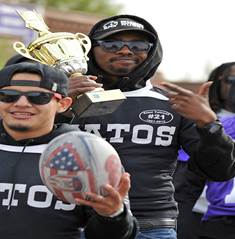
- Annual college rankings continue to roll out this fall and HU appears on several lists. Best Colleges ranks us #7 in the nation for lowest out-of-state tuition (http://www.bestcolleges.com/features/lowest-out-of-state-tuition/). U.S. News rates HU as #8 in out-of-state affordability (http://www.usnews.com/education/best-colleges/the-short-list-college/articles/2016-09-15/10-universities-with-the-cheapest-out-of-state-tuition). We are on several other lists as well. In general, we score very high on measures of affordability, which is good for our students. No one wants to add to student debt. However, as noted in the Branding Meeting held a few days ago, cost of attendance was not a strong favorable or unfavorable with our students or prospective students. For most respondents, it was a non-issue. Being inexpensive is simply not enough these days to draw students to an institution. To make that happen, I think an institution must either have name cachet (which is very hard to acquire…nearly impossible these days) or truly distinguish/differentiate itself in some interesting and compelling way. I ask you, my colleagues—how does or should HU differentiate from the many other choices students have today? Affordability is certainly a good thing, but clearly not enough to attract students—and I think our enrollment trend supports that assertion. I welcome your thoughts on this.
- I just received a report from the National Clearinghouse for English Language Acquisition (NCELA). In that report, various English Acquisition projects and programs are rated in regard to quality and impact. Our 2+2 Career Ladder Teacher Licensure Program (a partnership involving HU, Espanola Public Schools, and Santa Fe Public Schools) is rated #3 in the nation ahead of programs at UT-Boulder, Brown University, Oregon State, Georgia State, Penn State, GW, and many more. Well done to all who made this happen! A photo of Rodolfo Chavez, the Director of this wonderful project:
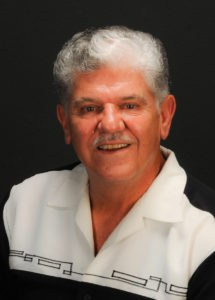
Rodolfo Chávez
- Dr. Brooks Maki, Professor David Sanchez Burr, Ryan Rudolph, and Dr. Joe McCaffrey recently collaborated on a very interesting video project. Brooks was kind enough to send it to me. Beautiful….. https://www.facebook.com/100008013465578/videos/1791712274439204/.
- HU faculty and staff have recently been doing an incredible job on grants. On Thursday we submitted a major proposal to the Howard Hughes Medical Institute (HHMI). These grants are very prestigious and difficult to win, but I think we have a real shot at this. I’ll let everyone know when we hear something. The team putting the proposal together consisted of Carol Linder, Diana Marrs, Edward Martinez, Casey Applegate Aguilar, Gregg Turner, Cecily Peterson, Elizabeth Ratzlaff, Maxine Salas, Ivy Romero, and Benito Pacheco. Of course, our grants office personnel, Jim Alarid and Angela Vigil-Juarez, must also be thanked for going above and beyond. Sorry if I missed anyone—this was a true group effort and a great example how good things can and do happen when smart people work together.
- The next major act we’ll present on campus (supported by the new Campus Life fee) will be the Yjastros Vivo Flamenco!. The troupe will appear on November 18 at 7:00 p.m. in Ilfeld. A nice YouTube demonstrating the prowess of the group (https://www.youtube.com/watch?v=VRc0QOCrae4). Here’s some information on the dance troupe: (https://www.abqjournal.com/564929/yjastros-flamenco-troupe-debuts-new-choreography.html). As always, students will not be charged at the door. If any tickets remain, they will be available to staff, faculty, and a members of the community for a modest charge. A photo of the troupe:

The Campus Life initiative continues to find success. More and more students are checking out equipment and engaging in healthy on and near campus recreational pursuits. A photo (left) of one of our student athletes, John Pine from Olympia Washington, who checked out some fishing equipment, biked a few yards to the Gallinas, and well…caught a fish. I think that is one of our bikes in the background. Another group of students rented our paddle boards and did a Rio Grande River trip over the weekend. A nice photo of that adventure (on right). Yoga on the water….to be young. I could try that move, I suppose, but it would result in me flailing around in the water in a very undignified manner, no doubt.
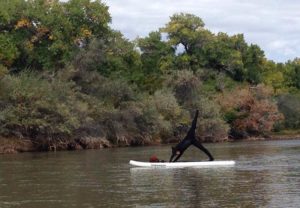
- Seven HU students recently attended the HACU Conference. I believe this was the largest student delegation from New Mexico. Dr. Edward Martinez also attended the meeting. The HACU is an important organization for HSIs and it is important we have a strong presence at that meeting. The students conducted several fundraisers to help pay for their trip. A photo of Dr. Martinez and our students at HACU:
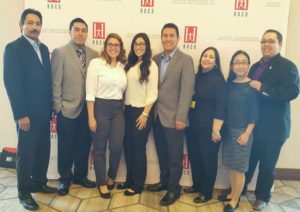
- On Monday evening, Joan and I hosted the Viles scholarship recipients and some members of the Viles Board at the University Residence. This program is one of the best things we do at HU and it was a pleasure to meet the students and hear their dreams and aspirations. Regent LouElla Marr-Montoya serves as the President of the Board. The Viles Foundation was established by Mrs. Matie R. Viles to assist New Mexican students to attend university. The Foundation was chartered in 1959 and has awarded more than two million dollars to students from our region. Many of those have attended HU.
- At this week’s leadership meeting we began with a discussion pertaining to how “bad news” is shared/handled (or not) in organizations. We read this brief article from Forbes(http://www.forbes.com/sites/erikaandersen/2013/03/06/how-great-leaders-deliver-bad-news/#7779883f2b47). I liked a few quotes from that article:
“When a leader is straightforward in saying the toughest stuff, people assume (rightly) that he or she will be courageous in all kinds of ways: making difficult decisions; taking responsibility for them; apologizing for mistakes.”
I also liked what the author had to say about how bad news is handled in too many organizations. He said, “…there are far too many examples of this being done poorly; bad news being downplayed, blamed on someone else, or simply lied about.” He went on to give some advice about how bad news is handled by top leaders. He asserted that those leaders (1) speak up (don’t try to hide things), (2) be accurate (don’t spin or divert), (3) take responsibility even if they directly had little or nothing to do with it (…this happened on my watch and I take responsibility for it….), (4) listen to the concerns of others, (5) say what will happen next, and then, (6) do what is said and repeat as many times as necessary. This passage also reminded me of a discussion I had several years ago with one of my mentors. He asserted that when something bad or negative occurs in an organization (and I defy anyone to find a complex organization where such a thing does not occur from time to time), you can often group people into two camps—those who reflect on what they did or did not do to make the bad thing happen and those who immediately play the blame game and lay everything at the feet of someone else or some group of people. His advice to me was that those inthe first group were good leaders or could be grown into good leaders and those in the latter group were not and probably had low potential to become good leaders. I am not one to be guided by generalizations, but in this case, I have to say that over the years his advice to me has been very helpful…and true. The meeting concluded with a demonstration and discussion of a new system to assess co-curricular activities at HU (one of the HLC concerns) and a discussion of some proposed initiatives to recognize extraordinary efforts of staff members.
- About 54 staff and faculty members attended the Open Forum on Tuesday afternoon and the budget presentation by Dr. James Peach. Jim is a true expert on the NM economy. His PowerPoint is attached (above). It provides a great deal of information and keen insight into the state’s financial situation. I encourage those unable to attend his talk to take a look.
- Strategic Enrollment Management (SEM) has been diligently working with University Relations and other HU offices to prepare additional, more attractive, and more up to date recruitment materials. One initiative has been to get each discipline to provide basic programmatic information and then to prepare tri-fold brochures our recruiters can use. That process is nearly done. Here’s a preview of what the brochures will look like:
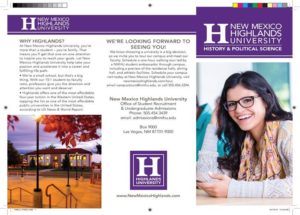
- On Wednesday, HU hosted the Economic and Rural Development Committee on our campus. Mayor Tonita Gurule-Giron and Provost Carol Linder welcomed the committee to our campus. I provided a welcome as well. A variety of economic development initiatives were discussed and time was allotted for public comment. Dr. Linder did a very nice job welcoming the committee to our campus and providing an overview of some of our more recent initiatives. Members of the panel had many very positive things to say about HU.
- Joan and I will participate in the Robertson Homecoming Parade on Friday. Moving forward, we hope to routinely have some HU presence in the Homecomings of each school in town. Unfortunately, I was out of town during this year’s homecoming at West. On Sunday, we’ll drive to the Rio Mora Refuge to meet with representatives of the Denver Zoo. The Refuge, HU, and the zoo have collaborated on numerous activities over the years and I hope to continue and possibly deepen that partnership.
- The weekly HLC Update—I had a nice discussion with some individuals from the Association of Governing Board (AGB) this week and things are shaping up for the board training in December. That training plus more extensive discussions about accreditation at board meetings should go a long way in addressing that particular HLC concern. I am also working with AGB on a board self-assessment—another HLC issue. On Friday, Brandon and I will have a phone conversation with Dr. Doug Davenport, Associate Provost at Western Missouri University and a veteran HLC examiner. Western Missouri is a regional comprehensive institution (like HU) and HLC is their regional accreditor. I worked with Doug many years ago on a successful HLC report we did for Truman State University. We may ask Dr. Davenport to examine some of our HLC draft documents and provide other assistance as we move forward. Here’s a new poster depicting our Vision statement. We really did not have something like this in evidence when our accreditors made their last visit. That was a problem. Now we do have these posters and they will be placed around campus, in offices, etc. We now also have a large vinyl version of the Vision 2020 document. We’ll use it at meetings, recruitment events, etc. We also have business cards with this information.
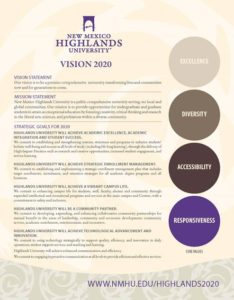
This week’s HLC update from Dr. Kempner:
We’ve scheduled our next HLC Update Forum for Monday October 24th, 3-4 PM, in the SUB Ballroom. All faculty, staff, and students are welcome. We’ll be going over the progress we’ve made, what we have left to do, our accreditation website, and then focusing in on Probation Area 1A: Mission. We had two meetings this week about Probation Area 3C: Assessment of Co-Curricular Activities (non-academic programs that help contribute to student learning, such as internships, ARMAS, tutoring, etc.). On Tuesday 10/11, the Executive Management Team heard a presentation about the SkyFactor Student Assessment suite, which would help us to collect data to show these programs are successful. On Thursday 10/13, the Co-Curricular Committee met to discuss procedures and guidelines for these assessments. Lastly, we had a good discussion on 10/12 at the Faculty Senate about how to better communicate with our students regarding probation. We’re working on creating probation handouts to distribute in classes and at the dorms and scheduling social media events on Facebook to answer student questions. If you have any other ideas on how to best reach students, e-mail me at bkempner@nmhu.edu.
All the best, my colleagues,
Sam Minner,
President
Greetings colleagues. A brief update for the week of October 3-7.
- A busy weekend with the Meadow City Music Festival activities, a soccer game, and a visit with the Student Senate, I saw several good HU colleagues at different Music City events. Thank you for your support of Las Vegas and HU. A very poor picture of the event with one of our own killing it with a classic jazz number.
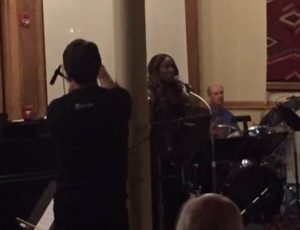
- Max and I visited with legislators on Monday morning who are struggling mightily with daunting budget problems (last year’s budget as well as this year’s). My sense is that we’ll probably land on or very near a 5% reduction in this year’s budget—maybe 5.5%. It could be more. For HU, a 5% reduction means an additional cut of approximately $1.5mil. We returned to Santa Fe on Tuesday morning. Most university presidents met with elected officials and made our case as best we could. I think this will end soon and we’ll know where we stand this year. A recent article regarding this matter: https://www.abqjournal.com/860148/nm-universities-fear-higher-cuts-to-state-funding.html. I will keep the campus community informed as things develop.
- Many thanks to all who attended the Branding Forum on Monday afternoon. There was lots of good feedback on the visual identity of the university and the organizing theme to push out our message. I must also thank Sean Weaver and the strong committee for getting this done on time and in such a professional manner.
- On Tuesday, we held a wonderful naming ceremony for the Facundo Valdez School of Social Work. Approximately 50 members of Facundo’s family attended the event, including his wife, son, and other close family members and friends. It was a moving event with many testimonials about Facundo’s life and his influence on so many people. I am so proud that NMHU now supports the Facundo Valdez School. Well done to all who made this happen. A photo of the event—Facundo’s wife is in the center and his son is to the right:
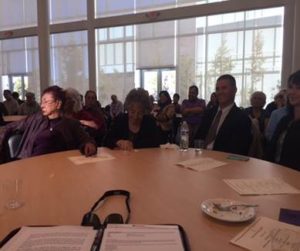
Unveiling the Valdez plaque: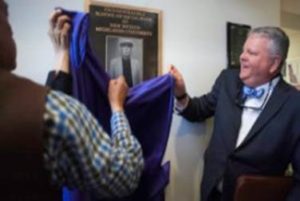
- I have been doing all I can to promote the Bond C election on November 8. I met the Las Vegas Rotary Club on Monday and the Kiwanis on Tuesday. Please encourage all of your friends and associates to vote on this measure. Polling projections are favorable at this time, but getting people to the polls is critical. As a reminder, an affirmative vote will allow us to renovate Rodgers.
- Kudos to Provost Carol Linder for winning the New Mexico Network for Women in Science and Engineering Award . This award is given to women who encourage others to pursue a career in science and related disciplines. Well done Carol!
- We are in final negotiations with a nonprofit agency to establish the Chicago Scholar Awards program. This generous gift will support several students from Chicago. They’ll all enroll at HU. These students are high school athletes and are looking to HU for a great academic and possibly a great athletic experience. Many thanks to all who helped make this happen.
- Many changes and hopefully improvements in Strategic Enrollment Management. Sean Weaver has collected information from most disciplines and will soon send the information off to the printer. At that point, we’ll have a recruitment brochure for every discipline on our campus. We recently concluded the filming for the Virtual Campus Tour and we’ll also get that back soon. We will offer jobs to several campus recruiters this week and then we’ll be staffed up for the new recruiting season.
- Lots of good things continue to occur in the Campus Life Initiative. We are very close to booking a flamenco dance troupe in Ilfeld (will probably be scheduled in November) and we continue to negotiate with the Sipapu Ski Resort for some skiing/snowboarding trips this winter. Last weekend, several students rented kayaks and camping equipment and camped out at Storrie Lake. Our intramural program has begun—we have kickball and volleyball teams at this point. Due to heavy demand, we’ll be purchasing more bicycles.
- I hope to see you at some of the Homecoming events this weekend. Fall has arrived in Northern New Mexico and the weather for all events looks promising.
- This Week in Accreditation (from Dr. Brandon Kempner): On Tuesday 10/4, President Minner and I had our first phone call with our HLC Liaison, Dr. Anthea Sweeney. She confirmed that our Action Letter, linked on our Accreditation FAQs webpage, should operate as our road map to remove Highlands from HLC probation. I’ll be developing that letter into a series of action plans that will be hosted on our upcoming Accreditation website, where the entire campus will be able to track our progress. In addition to that, it was a busy week of meetings as we continue to organize our efforts. The HLC Steering Committee met for the first time on Tuesday 10/4. That group initially consists of President Minner, VPFA Baca, Provost-VPAA Linder, VP-SEM Martinez, Dean of Students Blea, and me. We’ll also be putting together small subcommittees to deal with each of the criteria composed of faculty and staff. One such committee, the Co-Curricular group, met on Friday 9/30 to further develop our Co-Curricular Assessment plan. On Monday 10/3, we had a student forum in the SUB to answer student probation questions. It was well attended and we had a good discussion. On Wednesday 10/5, VPFA Baca and I had our final listening on the new Budget Process. On Friday 10/7, we’ll be screening a webinar titled “6 Dimensions of Implementing Strategic Plans” in Sininger 100. Finally, we have a direct e-mail for any HLC related questions:HLCinfo@nmhu.edu.
Have a nice weekend my colleagues,
Sam Minner,
President
Greetings colleagues. A brief update for the week September 26-30:
- Last Friday, I attended the Governor’s Higher Education Summit along with Chairman Sanchez and Regent Marr-Montoya. The governor spoke of our new state attainment goal—-66% of all New Mexicans with a two or four year degree or certificate by 2030. This is a stretch goal for us, but I think it is possible. There was also some discussions about how to attain that goal. The relevant variables included work in K-12 (e.g., greater collaboration between PED and HED), workforce and economic development (e.g., greater alignment between academic skills and workforce needs), higher education administration (e.g., increase FAFSA participation in the state), academic affairs (e.g., improve transfer agreements), and funding (e.g., work to stabilize higher education funding).
- On Sunday, Joan and I hosted a luncheon at the University Residence prior to the opening of the Northern New Mexico Painter’s Show in Kennedy. Several of the featured painters attended as did some patrons and friends of the show. After the lunch, Joan and I visited the show, which is still hanging in Kennedy. It is fabulous and I encourage everyone to see it.
- The Campus Life initiative continues to do well. Last week, 257 students attended a dance on campus and we held a Grand Opening of the Outdoor Recreation Center on Monday. More events are planned including the possibility of a flamenco dance troupe, other musical events, and student excursions. I have already seen some of our bikes zipping around campus and heard lots of talk about upcoming trips sponsored by this office. I recently read a paper by Tinto (the national guru when it comes to student persistence) and he asserted that persistence is mostly tied to two things—a curriculum and classes where students are highly engaged in learning and a campus supporting multiple opportunities for healthy social connections. In regard to engagement in learning, he specifically mentioned learning communities of various types as a good way to promote engagement. We are doing a pretty good job with that now, but we could do more. In terms of supporting opportunities for social connections, the various activities sponsored by Outdoor Recreation plus some of the other things we are doing to promote a more vibrant campus life fit into that category.
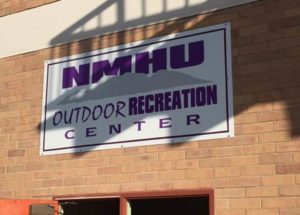
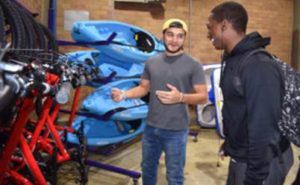
- The Executive Management Team met on Tuesday and we started the meeting with a discussion of mergers in higher education. We read a couple short articles. Go to:https://www.washingtonpost.com/news/grade-point/wp/2016/09/07/the-coming-era-of-consolidation-among-colleges-and-universities/ and http://www.huffingtonpost.com/dr-brian-c-mitchell/consolidation-in-higher-e_b_12051198.html. Institutional mergers have been studied pretty carefully and some general findings have emerged. Notably, (1) most people directly impacted by them do not like them, (2) they are typically driven by elected officials and or boards in the hopes of saving money and or increasing efficiency, (3) some people lose their jobs when mergers occur, most often faculty members, and (4) they sometimes do reduce costs and improve efficiency…sometimes not. We discussed the fact that some mergers are less than full…that is, some schools merge back office operations and sometimes boards merge without a full and complete merger of institutions. It was a good discussion and once again, I left the discussion feeling pretty fortunate to work with so many smart people. The remainder of the meeting was devoted to the HLC and updates from the various divisions and units on campus.
- On Tuesday, I attended the MOU ceremony with multiple Governors of Pueblos throughout the region. It was a very nice event complete with a moving Buffalo Dance by the Laguna Dance Group. I thank Dr. Edward Martinez, Mr. Robert Romero, and other members of the Strategic Enrollment Management team for organizing this wonderful event. I also thank the faculty, staff, and members of the administration who attended the ceremony.
- HU faculty have performed at a very high level recently in the area of grants. Rodolfo Chavez was recently awarded a $2,204,482 grant to support the 2+2 Career Ladder Professional and Teaching Training project. Dr. Edward Martinez recently won a grant from the United States Department of Education, MSEIP competition, to support a program to increase the number of minority students studying math and science. That grant is valued at $248,472. And just this week, Drs. Lora Bailey and Gil Gallegos were informed that their STEMfast proposal has been funded for $3mil. In sum, thanks to the hard work and extra efforts of HU faculty, approximately $5.5mil has been recently awarded. My colleagues, that is in the last two weeks alone. I simply cannot emphasize enough how important it is these days to cultivate alternative stream of revenue. I addition to these grant dollars, HU recently purchased two new trucks with special funds earmarked for equipment, the entire Campus Life initiative is supported from a fee, several professional development activities are now being supported by an endowment we created last year, which included $250,000 in private funds, and our Office of Advancement continues to perform well. A gift of $25,000 was pledged a few days ago. I recently read an interesting quote that resonated with me, “Public universities must become more entrepreneurial or suffer continued reductions in funding from their historical source of revenue…state government. Those who do not adapt will suffer.” I do not like it at all, but I believe that.
- I devoted the entire day on Wednesday to a meeting in Ohkay Owingeh. The meeting was the State of the Region Summit sponsored by the Regional Economic Development Initiative (REDI). Numerous topics were discussed including the teacher shortage in Northern New Mexico, workforce development issues, healthcare, and others. For me, the highlight was a talk by Alan Webber, entrepreneur and co-founder of the magazine Fast Company. I’ve enjoyed reading that magazine over the years which is a mash up of a traditional business magazine (think Forbes) and pop culture (think Rolling Stone). Webber’s basic premise was that regions seeking greater prosperity and economic growth should be very clear about their existing assets and then push hard on them. He stated that most communities “chase smokestacks”—-that is, work to get new factories there, but few have really been successful with that. He used the example of Portland, Oregon to illustrate his point. I think he was the mayor there at one time or held some office. Years ago, Portland was struggling. Shuttered businesses on Main Street. Decreasing population. Lots of in-fighting. Sounds a bit familiar, no? But, the community came together and did a thorough inventory of their assets. As one example, the city had numerous fountains in the downtown area. Some were in disrepair, but still…the city was known for them. At any rate, they decided to push hard on their assets and they did. The built bike lanes. They promoted the development of apartments and condos above downtown shops. They fixed those fountains. Today, Portland is considered one of the coolest towns around. He made another point—-he said to forget about chasing those smokestacks and instead, focus on getting as many energetic, risk-taking, smart, and civic-minded people as possible to move there. His asserted that those folks would establish businesses and draw others. His said that worked in Portland too. I got to thinking…what are our existing assets in Las Vegas and what would one or more initiatives look like if we got behind them with a good strong push?
- The search for the new Provost-VPAA is coming along nicely. As of today’s date, we have 58 applicants in the pool.
- The date for the discussion of Welcome To Braggsville has been set: November 15 @ 5:30. We’ll convene at the University Residence for a good discussion. We’ve been trying to contact the author so he can skype-in, but so far…no luck.

- Please remember to vote on November 7. No new taxes. New dollars coming to San Miguel County, including HU. New jobs coming here. Please vote. I’ll be on the radio on Friday talking about Bond C.

- As everyone probably saw in the paper or heard on the news, the Special Session will be held on Friday. It appears that only last year’s budget deficit will be addressed during the session, but no one really knows. As we move into this legislative season, rumors continue to rumble around about the next cut higher education will receive. This week, the most common prediction is 5%. For HU, that would mean a $1.5mil reduction on top, of course, what we’ve already experienced. I assure the campus that I and others are actively working with our elected officials to minimize the cut to HU and higher education generally. These are daunting challenges and the fiscal challenges coupled with those associated with the HLC make for a nearly perfect HU storm. And yet…my personal observation is that we as a community have come together on all this in a very powerful and encouraging way. I have received countless emails, phone calls, and many words of encouragement and support, including from some who are or have been somewhat vocal critics of HU in the past. I have seen and continue to see many colleagues consistently go above and beyond the call of duty—taking on extra duties willingly and voluntarily—to address our challenges. For all this, I am very grateful and optimistic. Excellent faculty and staff citizenship is quite alive and well here. I thank my good colleagues for that. Here’s an interesting piece regarding the budget situation—read the column titled “Insufficient”— https://nmlegis.gov/Entity/LFC/Documents/NewsLetter/LFCSept16.pdf. And finally, this week’s HLC update from Dr. Kempner:
This week in Accreditation: Dr. Kempner visited the NMHU Albuquerque Center on Wednesday to speak with the faculty about Center issues, a major area of our HLC probation. A forum has been scheduled for students on Monday October 3rd to discuss the implication of our probation. The retention Advisory Council met on Thursday morning to discuss our retention initiatives; they continue to work with Ruffalo Noel-Levitz to improve our retention efforts, another prime area of HLC concern. Finally, the senior NMHU administration has committed to meeting every two weeks to address our accreditation concerns. This group will consist of President Minner, VPAA-Provost Carol Linder, VP-SEM Edward Martinez, VPFA Max Baca, Dean of Students Kimberly Blea, and Director of HLC Accreditation Brandon Kempner.
Have a nice weekend.
Sam Minner,
President
Greetings colleagues. A brief update for the week of September 19-23:
- I attended the Domenici Institute in Las Cruces last week. There were some excellent speakers and many topics discussed, but the high-point for me at least, was hearing from James Carville about the presidential race and its possible impact on higher education. It was really great. Other guest speakers included the mayor of Albuquerque and several economists, politicians, and pollsters speaking on the issue of public trust. A (poor) picture of Mr. Carville with Chancellor Garrey Carruthers.
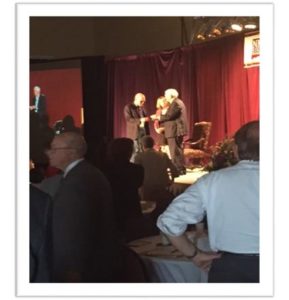
- Last Saturday the President of NAU, Dr. Rita Cheng, hosted Joan and I at the NAU-HU game. Our team had a rough afternoon, but showed much grit in the face of a Division I team picked to finish #1 in their conference. Flagstaff is a long drive from Las Vegas, but I was glad to make the trip and join several other HU supporters including some parents of HU football players.
- As you may recall, the Board approved a new campus alcohol policy last year. At the Homecoming game, we’ll have a special spot designated where the over 21 crowd can imbibe. There will also be some food choices (a BBQ Truck) and some other changes we’ll try in order to promote a good vibe and enhance the fan experience. I should note that we had very good attendance at the last home game and everyone is hopeful that the Homecoming game will bring out even more fans. I hope to see you there.
- As of today, still no date for the Special Session to address the budget shortfall from last year. I am sure you will see an announcement of the meeting once it is set. Given that last year’s budget is not yet fixed, there is obviously nothing definitive on this year’s deficit. When I hear something, I will definitely pass it on. More and more talk is occurring in regard to mergers of some of the state’s public schools. Take a look here: https://www.abqjournal.com/849573/secretary-outlines-challenges-for-states-colleges.html. I should note that other states have aggressively merged institutions in an effort to save money and increase efficiencies (go to: http://chronicle.augusta.com/latest-news/2015-01-06/georgia-looks-college-mergers). As you might guess, mergers are almost always controversial and in some cases, do not actually result in savings, and yet, mergers are on the minds of many legislators. This from an article in Inside Higher Education:
“An average of five colleges a year have closed the last four years, according to data from the National Center for Education Statistics. Yet if colleges don’t begin to explore options like mergers and affiliations…the absence of more mergers and affiliations may actually be ominous for higher education and indicate an uptick in closures. At some point the numbers are what the numbers are. If the choice is between survival or closure, any entity, even under a different governing structure, would chose survival.”There is some good news in New Mexico higher ed. Go to: https://www.abqjournal.com/849972/higher-ed-degrees-certificates-rise-21-percent-in-nm.html. - The Campus Life initiative continues to roll along. We accrued about $65,000 in ticket sales at the Gabriel Iglesias concert and another $1800 from ticket sales at the Mike Super event. This will be added to the Campus Life budget to bring even more activities to the HU campus and our Centers. Many HU students attended a major Hollywood screening at the Indigo Theater the other night and about 87 of our students attended the first “HU Night At J.C.s Pizza” event where participants bowled and had pizza and soft drinks. We’ll have a grand opening of the HU Outdoor Recreation Office next Monday. I’ve recently asked Dean Kim Blea to work with our recruitment office to make certain that prospective students hear about the vibrant campus life programming we are building for our students.
- On Thursday, we held the first HU Excellence event at the University Residence. This one focused on the accomplishments of HU folks who achieved degrees here or elsewhere. Many thanks to Provost Linder for organizing this event and more to come.
- Congratulations to Rodolfo Chavez for winning a new Department of Education grant titled 2+2 Career Ladder Paraprofessional and Teacher Training Project. This $2.2mil project will train 30 paraprofessionals from Espanola and Santa Fe to earn associate degrees and then transfer to HU to earn a degree in teacher education including an endorsement in ESL.
- On Friday, I will accompany Chairman Sanchez to a Governor’s Higher Education Summit in Albuquerque. I’ll provide an update from the meeting next week.
- This weekend promises to be a busy one. The Cowgirls volleyball team plays on Saturday and on Sunday, Joan and I will host a group from the Northern New Mexico Painter’s Exhibit, which opens this weekend in Kennedy. I strolled through the exhibit the other day and it is wonderful. I encourage you to see it.
- Dr. Kempner and I will be adding a brief update regarding the HLC to each weekly message. Here is this week’s update:
This week in HLC Accreditation: The focus this week has been on communicating with the campus community about the HLC probation. Dr. Brandon Kempner took the reigns as Director of HLC Accreditation on Monday and moved into his office in 104 Rogers. He will be the point-person on all HLC issues, coordinating, overseeing, and ensuring the quality of all our HLC efforts. In this capacity, he will be a direct report to the President. On Sunday, Dr. Kempner attended the Student Senate to talk with students about the probation and Highlands’ next steps. On Monday, Dr. Minner and Dr. Kempner held a campus forum with faculty, staff, and students about the accreditation issues. Another student forum has been scheduled for Monday October 3rd to further discuss these issues. An Accreditation FAQs was created on the main NMHU webpage and a global Student FAQs was sent to all students. All members of the campus community should familiarize themselves with our 9 probation areas; these can be found in the HLC’s Action Letter. We remain 100% committed to addressing each and every one of these concerns, and we will use this probation as a means of strengthening Highlands for the future.
Have a nice weekend my colleagues.
Sam Minner,
President
Greetings colleagues. An update for the week of September 12-16:
- No real new news in regard to cuts to HU or higher education generally. Rumors continue about the upcoming cuts and there have been numerous newspaper articles about what to cut and how much. Here’s an interesting report from the Rio Grande Foundation. This report is getting quite a bit of attention. http://riograndefoundation.org/downloads/rgf_what_to_cut.pdf. You can read the report yourself, of course, but here’s a bit in regard to higher education and a specific mention of HU:
“New Mexico’s government-run universities and colleges face severe accountability and efficiency issues. A 2015 report found that the state ranks 49th in the percentage of students who graduate on time. The result was hardly surprising, given that more than half of freshmen need to take at least one remedial course. Clearly, a major overhaul of higher education in the Land of Enchantment is in order. While sweeping reforms will take years, a reasonable place to start is with the problem of campus sprawl. Asked by a legislative committee, in 2010, “how many university branch campuses are in New Mexico, Higher Education Department Secretary Viola Florez did not have an immediate answer. In 2016, the University of New Mexico has five branch campuses: West, Gallup, Valencia, Los Alamos, and Taos. New Mexico State University has five as well: Alamogordo, Carlsbad, Albuquerque, Doña Ana, and Grants. New Mexico Highlands University has seven: Albuquerque, Española, Farmington, Raton, Rio Rancho, Roswell, and Santa Fe. Eastern New Mexico University has two: Roswell and Ruidoso. Western New Mexico University has four: Deming, Gallup, Lordsburg, and Truth or Consequences. Substantial savings can be obtained through the closure of branch campuses. For example, the fiscal 2017 appropriation for UNM Taos is $3.7 million. The university’s Valencia facility received $5.6 million. The budget for NMSU’s Carlsbad branch campus is $4.5 million. NMSU Alamogordo received $7.6 million.”Here’s a few more articles recently in the news: https://www.abqjournal.com/844545/nm-bond-rating-may-be-downgraded.html and https://www.abqjournal.com/844561/unm-to-freeze-staff-hiring-cut-budget-5-percent.html. - The campus community will meet at 2:00 p.m. next Monday. We’ll meet in the SUB. I’ll discuss the situation with the HLC and answer questions. A global message will be sent about this today.
- We opened the Trolley Building on Tuesday morning and what a great event it was. Many guests and dignitaries attended the wonderful ceremony. The giant purple ribbon was cut by some giant scissors by Chairman Sanchez who also made some memorable opening remarks. Professor Loewen did a great job tracing the history of the project. After the opening, I met with the President of Dine College for a formal signing of an MOU between Dine and HU. That too was a very nice event. Many thanks to all who attended one or both events. There are so many people to thank who contributed to the Trolley project, but I would be remiss to not single out Sylvia Baca who brought the project in on-time and on-budget.
- The gymnasium was nearly filled to capacity last Friday evening as hundreds and hundreds of students and community members saw a comedy concert by Gabriel Iglesias. It was a very nice campus and community event. This week, HU students were able to screen a first-run Hollywood film at the Indigo Theatre and pay no admission at the door (another Campus Life benefit to them) and the illusionist Mike Super will also perform this week (again, free at the door to all HU students). Many thanks to Ms. Kim Blea and her team for leading this effort. Soon, we’ll have the grand opening of the Office of Outdoor Recreation.
- The Executive Team met this week and we started the meeting with a discussion of how people handle or deal with adversity. We read this from Forbes magazine: http://www.forbes.com/sites/mikemaddock/2013/11/26/three-ways-great-leaders-handle-great-adversity/#71f4e9196a73. The author discussed how some top leaders dealt with adversity and mentioned things like finding humor in the challenge (if possible), seeing it as an opportunity to learn something, etc. Those around the table shared some of their approaches to adversity, how they coped with it, etc. It was a revealing discussion and helpful, I think. We finished the meeting talking about marketing materials, a budget update, and the HLC.
- On Wednesday, Provost Linder and I met with the Social Work faculty to discuss the search for the new dean there. We have permanent deans in place in all units with the exception of social work and in my view, it is highly desirable to get a permanent person there. More on this later.
- The Cowgirl luncheon was held on Wednesday. A nice crowd gathered for the event to honor our wonderful female athletes. Many thanks to all who attended and or sponsored that event.
- My message is a bit short this week due to the fact that I am leaving Wednesday to attend and participate in the Domenici Institute on Thursday. After the Institute, I’ll drive to Flagstaff on Friday in time to see the Cowboys take on the NAU Lumberjacks on Saturday. Joan and I will be hosted by the President of NAU who so kindly reached out to us.
Have a good weekend, my colleagues…
Sam Minner,
President
Greetings colleagues. A brief update for the week of September 5-September 9, 2016:
- Approximately 40 NMHU students attended the Santa Fe Zozobra event last week. Our students were transported to the event (and back) and were charged a reduced entrance fee at the door. This event was supported by the NMHU Campus Life initiative. A photo of some of our students at the event:
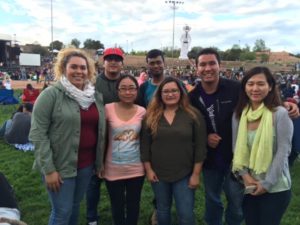
- NMHU will soon participate in an annual audit—both the university as well as the Foundation. I (and others) met with the auditors on Tuesday to get a preview of the process. They will be on campus next week. This is a routine audit…no special issues or concerns.
- Many thanks to all who attended the budget forum on Tuesday afternoon. I won’t go over everything here, but basically, the state overspent its budget last year and now must fill that gap. Most people say it will be filled by the Tobacco Settlement money the state has in the bank. The problem now pertains to this year’s budget. The deficit there will be considerable and virtually everyone I speak with believes that higher education will take yet another cut—this is on top of the $830K cut we’ve already had. As I mentioned at the meeting, every 1% cut at HU translates to about $330K. A 2% cut is about $660K, a five percent cut is about $1.6mil, etc. Things can change quickly and I’ll keep in touch with the campus community as things develop. Here’s the latest I’ve read: https://www.abqjournal.com/841161/gov-martinez-blasts-senate-democrats-as-budget-tension-mounts.html. As promised at the forum, I instructed the VPs, the presidents of the faculty and staff senates, and others to begin the process of soliciting ideas to meet the cut we’ll soon face. As noted at the forum, from my perspective, the reserves are off limits, dollars devoted to our accreditation should not be used to meet the cut, and resources devoted to our other source of revenue (recruitment and retention) should not be tapped, at least at this time.
- Many thanks to all who attended the first “Coffee With Prez” event on Wednesday morning. As I did last year, I’ll have at least one of these per month. If you have other thoughts about ways we could more effectively communicate, I certainly welcome them.
- The Big Ideas reading group is being formed again this year. We will be reading a novel this time—T. Geronimo Johnson’s Welcome to Braggsville, a satirical novel about campus unrest, racial politics, and the challenges of negotiating the modern college experience. When a Berkeley student decides to chronicle a Civil War reenactment in his hometown as a class assignment, all hell breaks loose. Campus politics have been very much in the news lately, ranging from things like The Atlantic’s “The Coddling of the American Mind,” to the student protests at Missouri and elsewhere, to the competing calls for “free speech” and “safe spaces” on campus. Our group will use Welcome to Braggsville as a springboard to open up these big conversations: what is the role of the academy concerning political justice? To social change? To identity politics? What role do professors and administrators have in controlling campus and classroom climate? Lastly—and most often overlooked—how do students negotiate the perilous emotional terrain around charged issues of race, gender, and politics? Welcome to Braggsville was one of the most celebrated and controversial novels published last year. Ron Charles of the Washington Post writes, “The most dazzling, most unsettling, most oh-my-God-listen-up novel you’ll read this year is called ‘Welcome to Braggsville.’ The 44-year-old author, T. Geronimo Johnson, plays cultural criticism like it’s acid jazz. His shockingly funny story pricks every nerve of the American body politic. Arriving smack dab in the middle of Black History Month — our shortest month, naturally — ‘Braggsville’ lashes self-satisfied liberals in the academy and self-deluded Confederates in the attic.” The New York Times hailed it as “Organic, plucky and smart, ‘Welcome to Braggsville’ is the funniest sendup of identity politics, the academy and white racial anxiety to hit the scene in years. If you’d like to join, please go the President’s Office in Roger’s building to pick up your copy of the book and sign up with Carolina Martinez. We’re limited to fifteen participants this semester; spots last year went quickly! Once everyone has signed up, we’ll organize a meeting at the University Residence in October to discuss the book. As of the writing of this week’s message, we still have a few books left. Come by and pick one up.

- The search for the new and permanent Provost and VPAA is well underway. As of today, we have 29 applications. Some of the applicants have great academic pedigrees (e.g., UC-Santa Cruz, Indiana, Harvard, Brandeis, etc.). I know that pedigree isn’t everything, but still…I am encouraged. Ideally, I’d like the applicant pool to get up near 50.
- I recently represented HU at a statewide meeting focusing on establishing a state goal on college attainment (two or four year). Many states already have such a goal. New Mexico does not. College attainment is more critical than ever. The Georgetown Center on Education and the Workforce projects that by 2020, 65% of all jobs in the U.S. will require some postsecondary education (a two or four year degree). After much discussion, most participants felt that a reasonable attainment goal for New Mexico should be 66% of all students by 2030. There was also some discussion about how such a goal might be attained. More on all this later.
- On Thursday I gave another GO Bond talk to the board of the Economic Development Council. As most of you know, a positive vote by the people on this measure will bring $4.5mil to our campus to renovate the historic Rodgers Building. Rodgers has some notable WPA murals. You can view them as you go to the second floor and those will be preserved, of course. A positive vote will bring jobs to the area and since some other state bonds are retiring, taxes will not go up if the measure passes. I urge everyone to vote on November 8.

- This promises to be a busy weekend. The concert by the comedian Gabriel Iglesias is tonight and we also have several athletic events this weekend. I hope to see you at some of these events.
- On Friday, I visited with the Media Arts faculty and the students in the AmeriCorps program. Students were showcasing their projects. Wow…just wow. Many good things are going on here at HU, but that program is one the VERY BEST things we do. Great faculty who are highly engaged, great students doing incredibly interesting work, and now…a great facility. Well done to all who make this happen.
Have a good weekend my colleagues.
Sam Minner,
President
Greetings colleagues. A brief update for the week of August 29-September 2:
- Last Saturday, more than 130 students, faculty, staff members, and alums made the hike to hermit’s Peak. Aviand’s provided a nice meal at the end of the hike. The event was planned and sponsored by the HU Alumni Office. A photo of my niece and her HU friend before the hike:
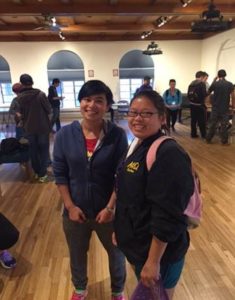
- The HU Executive Leadership Team met on Tuesday, as usual. We welcomed the President of the Student Senate to the meeting. He will join the group from time to time. We began the meeting with a brief discussion of so-called “shared governance” by reading an article by the president of Macalester College. To read the essay, go to: https://www.insidehighered.com/views/2014/07/29/essay-new-approach-shared-governance-higher-education. This essay has only been out a short time, but I have gone to it several times over the last few months. A quote from the essay:
“I am inclined to believe that many of these concerns are overblown. Bad actors and bad decisions are unavoidable in any large and diverse system, but these still seem to me the exception and not the rule. Most faculty members and most administrators appear to me to want what they have always wanted: to create vibrant and supportive environments within which the work of teaching and learning can be carried out at a high level. Achieving this goal has become increasingly difficult as the economic model of higher education has come under more intense stress, and this has cast the long-present messiness of the shared governance model into sharper relief. It has never been easy to maintain equilibrium within such a complex system of institutional decision-making, but today the stakes seem higher and the cost of missteps or inaction much greater.”
One of the President’s critical points is that we probably do not (maybe never had) true “shared governance” anyway. He asserts that our current system is closer to a “divided governance” system with one group (faculty) basically leading things like curriculum and another (administration) deciding most everything else. His point—it is really not shared governance at all—it is divided decision making. He writes:
“The interesting question is not whether the shared governance model is irrevocably broken, but whether it can be improved. I believe that it can and that improvement must begin with a better understanding of where the fault lines in the current system lie. Imagine that two people are charged with the completion of two tasks. They can choose to “share” this responsibility in a couple of different ways: each can be assigned to the completion of one task, or both can work on both tasks together. Depending on the nature of the tasks — and the people — one or another of these approaches may be the more effective. Shared governance at most colleges has evolved into a model that more closely resembles the first than the second of these approaches. It is common to find the faculty charged with the design, oversight, and teaching of the curriculum, with some minimal level of input from administrators. Virtually all other matters — co-curricular programming, student life, and, above all else, decisions about the spending of institutional dollars — are chiefly the purview of administrators, with some minimal level of input from faculty. We have, that is, a system of sharing through division more than a system of sharing through deep collaboration.”
We had a good discussion about all of this. At HU, do we have something closer to shared governance or divided governance? How much real decision making is made by the faculty or do they mostly just make recommendations? How much do administrators have to say about the curriculum? Or, do they basically wait around to see what the faculty want to do with that? Wherever we are on all this, does anyone really want to change? Should we? The discussion evoked a vivid memory of an effort I made at another institution. In an attempt to move from divided decision making, I restructured the sabbatical program in such a way that the faculty made the decisions. I told them what was in the budget and they met and made the final decisions regarding who was and was not funded. I’d be glad to talk with anyone about this in more detail, but wow…it did not turn out the way I thought it would. It was a really nice discussion with many points of view. It led into a related discussion about the pace of decision making. It is very common for faculty to express concerns that administrators tend to decide things much too quickly and without full vetting. Administrators commonly bemoan the fact that problems, challenges, and the like fly into their offices and in some but certainly not all cases, must be acted on very quickly. This “pace of decision making” tension is hardly new in the academy and in my experience (such as it is), it is ubiquitous across the sector. I know I’ve certainly heard it every place I’ve worked. But, still…what to do about it? Can anything be done? Should we even try? If yes, how on earth would that work? I guess I can’t imagine how I’d engineer a process that allows for more decision making time when, in some cases at least, I won’t know what needs deciding and the timeline associated with the decision until it happens. Plus, in many cases, I spend lots of time thinking of a possible response to solve a challenge that in the end, fades away and ultimately requires no solution at all. I welcome your thoughts on all this. As I wrote…an interesting discussion. The meeting concluded with a discussion of promotional materials available to recruiters, an update on ticket sales for the upcoming concert by Gabriel Iglesias, and updates from the VPs.
- Wednesday was filled with meetings with legislators. Max and I met with Representative Tomas Salazar in the morning and Congressmen Ben Ray Lujan in the afternoon. Mr. Lujan also toured the Trolley Building and the EDC. Clearly, HU has good friends in both the state and the federal government. Max and I will visiting our elected officials in Washington sometime this term. The trip may also include an alumni event.
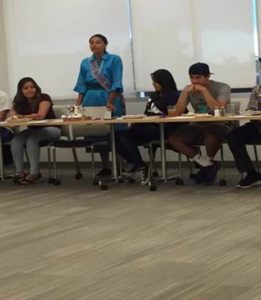
- On Wednesday evening, Joan and I attended a very nice banquet and program put on by the Native American Club. Well done to Mr. Robert Romero who organized the dinner and the program. A photo of the event:
- Kudos to Ms. Tamlyn Crain for being selected as HU’s representative to the Domenici Public Policy Conference on September 14-15. Tamlyn will join other students from universities around the state and sit on various panels at this year’s event. Speakers include former U.S. Secretary of Defense Chuck Hagel, political strategist James Carville, and author Kristen Soltis Anderson. I will also be attending this event.
- The HU Outdoor Recreation Center had a soft opening this week. We are still receiving some equipment, but at this point I think we have some mountain bikes, some paddleboards, camping equipment, fishing equipment, pedal boats, kayaks, backpacks, and much more. Some really great excursions are now being planned for our students. The Center is located in the Industrial Arts Building. The goals—-(1) make the HU student experience more interesting, healthy, and fun, (2) keep more students on or near campus over weekends, and (3) perhaps even draw some additional students to us. We’ll have a grand opening later in September. I don’t know how many studies I’ve read suggesting that what happens outside of class is just as meaningful to students (or more so) than anything else they do at university. Hopefully, this initiative will enrich the student experience at HU.

- The Council of University Presidents (CUP) will meet soon to attempt to devise a unified position on the high potential of additional cuts to higher education. The various campuses around the state are now or will be holding meetings to discuss the budget situation and to prepare for the rescission. An interesting article about what’s happening: http://www.santafenewmexican.com/news/education/state-colleges-universities-could-be-prime-targets-in-budget-talks/article_610aa774-663a-586c-a36e-775a7c4acb08.html. Here’s a headline that caught my eye—Higher Ed Tops Chopping Block…for more, go to: http://www.sfreporter.com/santafe/article-12431-morning-word-higher-ed-tops-chopping-block.html. Every campus is different, of course, but at the core, all of the Presidents in New Mexico (really, throughout the nation) first want to protect the core mission to educate students and offer classes required for them to graduate on time and to protect the people who make each institution work. Some schools have deep reserves and in some cases, they are tapping them to weather the current storm, but that is a dangerous strategy if the storm continues too long or even worse, just rages forever. Most schools—particularly the regional universities like HU—lack the reserves to pursue that strategy. Next week we’ll have our campus forum about the budget situation, its potential impact on HU, initial thoughts on how to address the cuts, and other suggestions from the HU community. It is really no consolation, but at least we are not located in Illinois where 300 employees were recently let go at Chicago State, 131 were laid off at Western Illinois, massive furloughs at numerous schools, and some presidents securing lines of credit from private lenders to meet their payrolls. My colleagues, we are in the midst of major and perhaps permanent changes in how public higher education works in the United States and how we pay for it. The proverb May You Live In Interesting Times comes to mind and these are interesting times, no doubt. The trend lines of reduced public support for public higher education and increased tuition to fill the gap simply cannot be sustained. Everyone agrees on that. But, what to do? Lots of conversations on that and many ideas—I have my own thoughts about it, of course—-but at this point there is certainly no clear path forward we’ve decided as a nation. Many more online options with most American students going that way? Bulking up community colleges with most students starting there and drastically reducing the number of four-year schools? The German model—free college? Reducing high school by one year and adding college classes (online or face to face) at each school, thus eliminating most colleges? All of these options and many more are discussed these days and I assume that one or more of them will ultimately prevail. The immediate concern is the pain we all feel as the current trend lines continue to move in opposite directions. This is more distressing to me than you can imagine. Yet, I can and do take some solace in temporarily letting this go, to the degree possible, and reflecting on our time-honored and broader goals—teaching truth as we know it, making new knowledge in the disciplines we love, and applying knowledge and hopefully wisdom to serve humankind and make the world a better place. I see the embodiment of these goals every day at HU and even given the intense pressures of the opposing trend lines, that makes me very happy.
Have a nice long weekend, my colleagues.
Sam
Greetings colleagues. An update for the week of August 22-26:
- Many good colleagues gave up their Saturday (and Friday) to attend a training session put on by Mr. David Martinez. The group learned many new skills and gained in both knowledge and wisdom in regard to resolving conflicts and moving organizations forward. I also must compliment the outstanding work of our facilitator, David Martinez. David was a contemporary of Cesar Chavez and was his right-hand man for a long time. David did an outstanding job and not only shed new light on more modern and proven ways to settle disputes, he also shared many memories of his time with Cesar and their travels around the world. David is a federal employee of the Federal Mediation & Conciliation Service, one of the smallest federal agencies in our government. Frankly, I had never heard of the FMCS until the meeting last week.

- Last Friday, I toured the Trolley Building (incredible) and also dropped the HU Office of Outdoor Recreation. The campus is looking very nice and we have several new spaces for our students, faculty, and staff this fall. I thank my good colleagues in facilities for making the campus look nice and feel so welcoming. We’ll soon have a grand opening at the Trolley Building, but if you have the time to just stroll around a bit, please do so. It is absolutely fabulous.
- On Monday, I welcomed about 50 people to the grand opening of the EDC and the Business Hub. The EDC is a nonprofit supporting new economic development in our community. The EDC is located in Hewett Hall. I am very pleased we were able to work everything out to bring the EDC to our campus. HU should and does play a major role in the economic development of the region and this new partnership we have with the EDC is simply the most recent manifestation of that partnership. I should also note that this would not have happened without the tireless efforts of Max Baca. I won’t go into the details about why this was so challenging, but it was and it would have been very easy to quit on it. But, the EDC did not…we (really, Max) did not…and today, the EDC is on our campus and open for business.
- The Leadership Team met this Tuesday, as usual, and we spent a few minutes talking about the ongoing debates about academic assessment. We began with a discussion of Cary Nelson’s essay, Keep Your Hands Off the Fierce Humanities. Go to: http://chronicle.com/article/Keep-Your-Hands-Off-the/128804/ . Dr. Nelson’s basic thesis is captured in this quote from the essay:
“For what I teach and what I seek to do—and for the fierce humanities in general—the assessment, accountability, and quantifiable-outcomes movement is nothing less than a benighted Enlightenment fantasy of mastering the unmasterable, of quantifying what cannot be measured. If you as a teacher want to adopt its protocols, that’s fine. That’s academic freedom. Just don’t try to impose them on me. That is academic freedom as well.”As is always the case with Nelson, the essay is very well done and provocative. There was some group discussion about the piece and at least to me, there seemed to be some agreement that it was very hard—maybe impossible—to measure some of the most important things we are trying to accomplish with our students. Let’s say you are teaching a course in philosophy with perhaps a focus on what it means to lead a good life. You study and discuss some of the time-honored authors on this subject and yes…of course…you could devise some kind of “test” to see if students could recall who wrote which text or when something was written or something like that. But, really, that’s not really the purpose of the class, is it? How on earth would you go about testing if your students used what they learned to truly live a better life? No end of class test can measure that. At the other end of the continuum, we discussed one of the “Corner Office” interviews which appear in the Sunday New York Times. In that interview, Lisa Borders, president of the W.N.B.A. talked about how she used data and focused on results in her career. She stated, “…people tend to confuse activity and results. At the end of the day, results are what really matter, not activities. And so I’m very focused on tangible outcomes.” We had a brief discussion about that. Many of us end each day pretty well rung out, but….are we tired because we were engaged in so many activities and if so, what were the real results of that effort? Is HU better than it was? Here’s the interview if you care to peruse: http://nyti.ms/2aeODS4. It was a good discussion. We concluded the meeting with some discussion regarding Homecoming, a greater focus on acknowledging the efforts of high performers at HU, the cost of textbooks and what we might do about it, and updates from the various VPs. - Earlier Tuesday morning (much much earlier…yikes!), I met with the Sunrise Kiwanis Club and provided an update about campus happenings and some details regarding the Bond C election (sometimes referred to as a GO bond election). If approved by a vote of the people on November 8, Bond C will provide approximately $4.5mil to allow HU to renovate Rodgers. It will bring dozens of jobs to Las Vegas and since the state is retiring some bonds, it will not add to anyone’s taxes. I urge everyone to vote on November 8. The renovation of our beautiful new Trolley Building was supported by a previous GO Bond and everyone can see how that worked out (great). For more details about Bond C, please go to www.nmbondc.com. Numerous additional talks, radio interviews, and other efforts to get the word out about Bond C are also scheduled.
- On Wednesday, Max and I drove to Red River to attend the LFC meeting. Max and I will schedule a campus meeting as soon as possible to discuss the state budget and the implications for Highlands, but in a nutshell…last year’s budget is not balanced and the state spent more than was brought in; thus a deficit. The state requires a balanced budget..right now, we do not have one. State reserves are basically at zero. Virtually everyone at the meeting believes there will be more cuts (in addition to those we have already made) including more cuts to higher education along with other agencies. There was much discussion about other ways to address the deficit the state is carrying from last year and the likely deficit in this year’s budget such as closing some tax loopholes, sweeping surpluses, raising taxes, transferring some funds from the tobacco settlement fund, and others. Some of these solutions are much more likely than others, but at least everything was on the table in Red River. But, again…additional cuts are likely and for higher education they could possibly be anywhere from 2.5% to 5%. A 1% reduction in state budget at HU is approximately $300K, so you can do the simple arithmetic problem. We will not know exactly where we stand until after the special session, but obviously, we must start preparing now. This will all be discussed at a campus-wide meeting….my goals…be as open and transparent as possible, first protect the core mission to the max degree (offering classes to our students to move them toward graduation), protect our people to the max degree, and budget in ways consistent with our mission and to the degree possible, support efforts to strategically plan for the future. Merely waiting for the state government to get more healthy and return to previous funding levels is very unwise, in my view. We must be more proactive than that. Max returned to Red River on Thursday to attend the ongoing meeting, speak with elected officials, and gather as much information as possible. I assure you that I, others here who work in Government Relations, and all the university presidents who are members of the Council of University Presidents (CUP) are working as hard as possible to avoid further cuts and make certain that decision makers clearly understand the importance of higher education to the state and to the individuals who transform their lives by virtue of a higher education. However and as you might expect, individuals from other agencies/programs are doing the same. Some articles if you’d like more information:http://www.governing.com/topics/finance/tns-new-mexico-budget-reserves-hit-zero.html,http://www.abqjournal.com/832391/the-latest-new-mexico-state-budget-revenues-plunge.html.
- I continue to serve on the board of Main Street Las Vegas and we had a board meeting Wednesday evening. There are many positive and hopeful things happening in Las Vegas and I am very happy that HU is at or near the center of so many of them. Joan and went downtown the other night to grab a bite and literally could not find a place to park. That’s really a good thing. I should also note that Dean Bill Taylor also serves on the Main Street board and is a great strength on the board.
- The tickets for the performance of Gabriel Iglesias continue to be snapped up. I was particularly pleased to hear that dozens of students from our Centers have requested and been issued a ticket. Center students coming to the campus for an event? That’s a nice change, no? Tickets to the general public will go on sale soon. A photo of the performer:
 Please think about participating in this weekend’s Hermit’s Peak Wilderness Experience. I think we have 300+ participants lined up. Buses will depart Kennedy Hall at 7:00 a.m. You can take the bus to the Peak or drive yourself. Many of you know this hike already—it is about 8 miles round trip. The peak is about 10,212 feet. There will be a free BBQ at the termination of the hike. This event is sponsored by the HU Foundation.
Please think about participating in this weekend’s Hermit’s Peak Wilderness Experience. I think we have 300+ participants lined up. Buses will depart Kennedy Hall at 7:00 a.m. You can take the bus to the Peak or drive yourself. Many of you know this hike already—it is about 8 miles round trip. The peak is about 10,212 feet. There will be a free BBQ at the termination of the hike. This event is sponsored by the HU Foundation.
- The vacancy announcement for the Provost/VPAA position is now out. Many thanks to the search committee for moving on this so quickly. Here’s a link: https://www.higheredjobs.com/executive/details.cfm?JobCode=176332890&Title=Vice%20President%20for%20Academic%20Affairs%20and%20Provost. We are trying to improve performance in our HR area and it appears to me that we have already made major inroads. Our HR consultant was very helpful is shaping the ad, getting it out, etc. The consultant was also very complimentary toward the chair of the committee, Dr. Brandon Kempner.
- Take a look at some very nice drone footage of the HU campus. We may use this on our website and or other ways. Many thanks to Sean Weaver for getting this done. Go to our Facebook page to see the fly-over:https://www.facebook.com/HighlandsUniversity. This was shot over the summer so there aren’t many people around, but still….very nicely done and something we can use a variety of ways.
- Many thanks to AD Bob Clifford for working with Nike to make HU an “All Nike” school—the only All Nike school in the Rocky Mountain Athletic Conference. For more, go to: https://www.abqjournal.com/832016/new-mexico-highlands-announces-nike-deal.html. I was on the phone with the other RMAC presidents the other day and they also congratulated Bob on this significant accomplishment.
- I asked Ron Garcia to take the lead in connecting our students to on-campus jobs. At present, jobs are advertised a couple places, procedures for students connecting with jobs are not perhaps as clear and straightforward as they could be, and the overall process (according to many students) is just too cumbersome. This is certainly not a criticism of anyone…but all processes need to be examined from time to time, updated, etc. When I arrived last July, I heard many concerns expressed about our business practices generally and this new way of handling student employment is part of the effort to make improvements. We’re also working in the HR domain to improve outcomes, processes, efficiencies, etc. If Ron asks you for something or solicits your help, please do so. Ron is doing a great job on this project.
I hope everyone is off to a good fall term. It is so nice to see the students back on campus and good colleagues who were away for the summer. Campuses are pretty lonely places without students, staff, and faculty around. I am optimistic about things on campus, but troubled about the state budget and the implications of the budget for HU. We will need to work closely together and in the most highly collaborative manner to address the budget situation. If you see me behave in such a way that does not promote collegiality or something I could improve on, I’d appreciate knowing that and any suggestions you may have.
Sam Minner,
President
Greetings colleagues. A brief update for the week of August 15:
- On Monday I met with Ms. Carol Rutten who is our liaison to the Los Alamos. We talked about the LANL position they are supporting here (still not filled, but close, I hope), their continuing support of our ARMAS program, and the possibility of a new partnership with a local K-12 school (HU, LANL, and a local school district) to build a more robust pipeline for kids in STEM disciplines. LANL has been and continues to be a great partner to HU and I am committed to deepening our partnership with them in the future. I should also note that on Tuesday I signed an MOU with LANL for a $50,000 award to support ARMAS. Many thanks to Elizabeth Ratzlaff, Carol Linder, and Edward Martinez for their work on this grant.
- I am nearly done with the annual reviews of everyone on the executive team. These reviews consist of a self-analysis by each person followed by my review of their performance in the domains of management (getting things done) and leadership (improving things). Each member of the team will ultimately be provided with a written summary of the review, which will be placed in each individual’s personnel file. I am also speaking with each person about her of his continued professional development and each person has a plan in that regard ranging from additional professional certifications, advanced degrees, giving papers at relevant professional meetings, etc. Next year, each member of the executive team will undergo a 360 review. I will provide a review of each team member, the executive peers will provide a review, a random selection of direct reports will provide reviews, and I may ask someone from another campus who holds a similar job to provide some input. All of this will come together in one document, which will be provided to each team member. Each member will then have the option to share the 360 with me and place it in her or his personnel file—or not. This process is intended to be developmental—not evaluative. However, each person will have a true evaluation (similar to what I did this year) next year as well.
- I mentioned this at the Freshmen Convocation, but congratulations to Dr. Mike Petronis for recently winning a very nice grant from the National Science Foundation. This $523,844 grant will allow us to purchase new equipment for our geology program. Well done Mike!
- On Monday, we were informed that Dr. Edward Martinez has been awarded a $248,472 grant from the United States Department of Education. This grant is from the Minority Science and Engineering Improvement Program (MSEIP). The MSEIP is designed to increase the numbers of underrepresented students into science and engineering programs. This grant will provide additional support to ARMAS. Well done Edward! A number of other large grants will soon be submitted including a grant to the USDoe to support a project in the America’s Promise Act competition. More on that later.
- Bob Clifford, Lora Bailey, Edward Martinez, and others met several times over the summer to discuss the possibility of a pipeline type program bringing student-athletes from Chicago to HU. The goals—-students from Chicago get a great HU education, perhaps play on one of our teams, and then return to Chicago to teach and or coach. Funding for that program has now been secured and we are preparing the necessary paperwork to get this done. A generous benefactor helped make this happen and everyone is looking forward to getting started. Each of the students participating in this program will also receive a $2500 stipend from the Golden Apple Foundation to support their attendance and participation in the Golden Apple Summer Teacher’s Institute. Well done to everyone who made this happen. A photo from one of the events where this project was discussed:
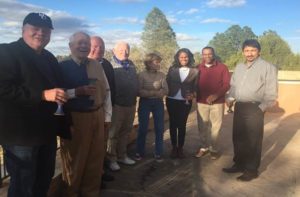
- The Leadership Team met on Tuesday and the first thing we discussed focused on the VPAA/Provost search. Dr. Kempner, Chair of the Search Committee, updated everyone on the status of the job description and the timeline associated with the search. We then discussed a common problem in faculty and administrative searches—focusing too much or exclusively on the sorting and selecting dimensions of the search and not focusing enough on the recruitment of good applicants. I reviewed several searches I had been involved in—as an applicant or as someone making a hiring decision—and briefly described how I had too often seen or heard about efforts to seemingly not recruit someone (e.g., let me tell how terrible this program or this person is) and in a few cases, actively push someone away (e.g., why on earth would you want to come here?). We had a brief discussion about why someone would do that (probably because they are unhappy) and how that might be perceived by an applicant (not really good, but seasoned veterans would probably not be unduly influenced by that kind of thing). We then turned to what each of us would say to actively recruit—encourage—someone to come to HU. There were many ideas, but the reasons that most powerfully resonated with me included (1) a chance to come to a place where many good things are going on, but also high potential for improving things and starting new things—in other words, you’ll have a good opportunity to put your own stamp on things, (2) a place at the very center of public higher education action these days (that is, a place dedicated to serving all students and helping them go as far as possible compared to the old higher education model where schools worked as hard as possible to sort and select the best students on the front end in order to improve their institutional reputation), (3) a chance to become a key member in a relatively new executive team and hopefully help shape that team into a high performing unit, and (4) more on the personal front—a chance to live, work, and play in a beautiful spot with incredible opportunities for outdoor recreation, incredible history, and relatively easy access to spots some people travel around the world to visit. Our rich cultural heritage was also mentioned several times as a plus. It was a good discussion and could, I suppose, lead to a small set of talking points used to encourage our top Provost/VPAA applicants to join us.
- I think everyone is aware that the comedian, Gabriel Iglesias, is coming to the HU campus September 9. His performance is supported by the Arts@HU program, which is student funded. Students pay nothing at the door and if there are any other seats available, they will be available to the community.
- I spent all day Thursday in Albuquerque at the invitation of Secretary Damron. About 50 people attended the meeting and the sole focus was on the possibility of establishing a state goal for completion of a certificate or degree. We are one of the few states that does not have a state-wide goal. It was a worthwhile meeting and I am optimistic that something will come of this. Many options were put forward, but the consensus seemed to be 60% of New Mexicans having a certificate or degree by 2025. That will be a stretch, but is doable, I think. There was also some discussion about tactics to achieve that goal. One that was particularly compelling, to me at least, was designing a statewide system for non-completers. People with some college could log onto a website, fill out a few questions, and then receive information about the university/program that best meet their needs. This would require a great deal of cooperation, but some states are already doing this kind of thing.
- On Friday, I was joined by several faculty members and administrators at a workshop put on by the Federal Mediation and Conciliation Service. My goal in all this—let’s employ modern techniques to solve internal problems in order to have more time and energy to move HU forward.
Have a good weekend, my colleagues.
Sam Minner,
President
Greetings colleagues.
June 28, 2016
A brief update for your perusal. My first year will come to a close in just a few days and as you probably know, I had several goals stipulated by the board. In addition to doing the best I could on those, I also focused on campus life (via the Division of Student Affairs), Strategic Enrollment Management (a new division here at HU), and a reengineer of Advancement. These three area were not chosen randomly nor were they chosen because I thought they would be easy to improve. Quite the contrary, really. I chose them because, in my view, they held the most promise to address what I considered (and still consider) our most daunting challenge—moving from a historical reliance on state funding to a situation where we rely more on our own efforts to accrue revenue and remain vibrant and strong. That means— getting more students recruited and retained and improving our performance in private giving. New Mexico remains one of the states where state funding continues to support a large percentage of higher education funding, but the national trend is quite clear. For example, several states now receive less than 20% of their higher education funding from state government. Even though New Mexico devotes more than that (percentage-wise), the state trend is also clear—state funding is going down over time. Hence, my concerns.
I am rarely satisfied with performance (at least my own), but I am generally pleased with progress in the three areas of campus life, enrollment management, and advancement. All are trending in the right direction. We will have a more vibrant campus life this fall thanks to student and board support of the new Campus Life fee. At this point, our recruitment is looking good with more admitted students and more students enrolled and more housing deposits made. Advancement had a great year with a successful campaign to get the 2:1 match from the state resulting in a permanent endowment of $750,00 to support high-impact practices. Advancement has also secured other major gifts in addition to the HIPs campaign. A few details about all this (and other updates) appear below:
Student Affairs
- Things are progressing nicely in regard to the new and enhanced campus life activities we’ll kick off this fall. Kim Blea and Donna Martinez are attempting to finalize contracts for some of our Arts@HU acts. There will be an announcement when those contracts are done. Kim and others are also working on bringing more social activities to and near the campus and we are making good progress on the office of HU Outdoor Recreation. We are advertising for the coordinator of that office and beginning to select the outdoor equipment we’ll provide to our students.
Strategic Enrollment Management
- After a national search, we have hired a new Director of Recruitment, Ms. Jessica Jaramillo. Jessica brings new energy and ideas to this important position and I have been so impressed with her enthusiasm and commitment to improving our enrollment outcomes. Please join me in welcoming her.
- The number of admitted students continues to look good…1863 this time last year and this year, 2956. Edward and his team continue to work very hard to convert those admitted students to enrolled students. At this point, the conversion is everything. At this time of the year, we do track the number of admitted students and we are up approximately 5% with most of the increases at the Centers. The Centers are located in the more populated areas of the state and it is my view that increased enrollment will likely be led by increases at the Center locations. What will it take to increase the number of students on the home campus? In my view, this is likely to occur under two circumstances. First, our programs on the home campus would need to be reengineered so that they are demonstrably better than programs on other campuses. The best shot we have at this, in my view, is probably the focus on high-impact practices. If we could make the case that programs at HU get students more actively engaged in learning than programs at other places, we might attract more students. That will be a hard sell, but it is possible. Another hope pertains to unique programs we have or could build here. What might those “unique” programs be? I ask that you think about that and we’ll have a discussion—and hopefully more than a discussion—about that this fall. Finally, it is my hope that the new emphasis on campus life might attract some new students. That is a hard sell too. Some campuses are in or adjacent to metropolitan areas complete with dozens—maybe hundreds—of interesting and potentially fun social options. We can’t compete with that, but we can do more to sell the numerous assets of this region coupled with a much more vibrant campus life.
- Sean Weaver and his team are having a final discussion about the new HU branding concept. There will be a campus forum about this early in the fall. Those brands and messages will be folded into the 2016-2017 recruitment strategy at HU. I won’t spoil anything, but Sean believes that the driving message for us is very apparent after carefully examining input from many constituent groups.
- VP Martinez recently returned from California where he secured a new MOU with the Torres-Martinez Desert Cahuilla Indian Tribe. Dr. Eric Romero and others joined Edward on this trip.
Advancement
- We now have an annual fund officer in the Advancement Office. After a national search, we hired Ms. Anita Ramsey. She is on the job now. Everyone knows that the very heart of any advancement operation is a robust annual campaign. I am confident that VP Law and Ms. Ramsey will engineer a good annual fund operation and continue to improve our advancement outcomes.
- VP Law has proposed a nice slate of fundraising campaigns and alumni events for the 2016-2017 academic year. The plan is in place, the personnel are now in place, and it is time to implement. I am confident she and her team will do so and will do so at a high level.
- Ms. Juli Salmon has agreed to coordinate the annual HU graduation ceremony. Please join me in thanking Juli for taking on this task.
- Later this week, HED will release details about the process institutions can follow to access additional funds that were left over after the last endowment campaign. Basically, some of the schools trying to win the 2:1 match from HED were unable to do so and those funds will be rolled over into a new competition beginning July 1. We’ll take a look at the new RFP and if it makes sense for us to go after some of the funds, we’ll do so. The chance of getting two dollars for every private dollar raised is a great deal and one we must pursue.
Facilities
- Things are progressing nicely on the Trolley Building. I walked through the building the other day and it looked great.
- The NMHU General Obligation Bond team has been established—at this point, me, Max, and Sean. There will be a multi-dimensional effort on the GO Bond including billboards, op-ed pieces, presentations to civic groups, and other activities. If the fall election result is positive, we’ll renovate the Rodgers Building.
- We’ll be installing the new HU Outdoor Recreation Center in the Industrial Arts Building and we should be up and running in time for the start of school this fall.
- The campus looks very nice this summer even though we have not had much moisture. Thanks so much to the individuals who work so hard to make that happen.
Athletics
- We continue to negotiate with private donors to bring some students to HU to earn a solid degree and potentially play on one of our teams. This has been a long process, but I think we are close to finalizing the arrangement.
- HU Advancement will be making an effort to charter a bus to Flagstaff to see the Cowboys play the NAU Lumberjacks. If you are interested, let our Advancement office know.
- Other good things are also happening in Athletics including a possible renovation of the Hall Of Fame area. That space needs some attention and we now have a plan to solicit donations to get that done.
Academic Affairs
- Too many faculty members have engaged in interesting and important summer research activities for me to mention, but I thank them for their high dedication to their scholarship. So many of our colleagues use the summer term to push hard on their scholarly work.
- We continue to make progress on our various HLC goals. Several items will go to the board next month and that will help address some of their concerns.
- VP Linder will soon call together the strategic planning group and we’ll move forward on that important task. My opinion is that the complete strategic plan need not be all that long or complicated. We have a mission statement now. What measureable objectives should be subsumed beneath each element of the mission? We must figure that out, come to some agreement on them, and then budget to improve outcomes in those areas.
- As you may have heard or read, Bill Taylor was recently named the Dean of the School of Business, Media, and Technology. And, of course, Carol Linder was recently named the Interim Provost and Vice President of Academic Affairs. I ask that you join me in thanking Bill and Carol for their dedication to HU and our students. Servant leaders take tough jobs to serve the organization knowing full well that the great responsibilities they have far outweigh the modest benefits they personally accrue. This is certainly true in the case of both Bill and Carol. .
- Great news for Dean Lora Bailey. She just had a book prospectus accepted by Taylor and Francis, one of the top publishers in higher education. Well done Lora! Lora also recently won a nice grant from HED and is working on some early childhood initiatives with the new superintendent at Robertson.
- The search for the endowed position from LANL continues (this position is referred to as the LANL Coordinator of Student Support). This individual will be housed in ARMAS and will do some teaching, student recruitment for STEM disciplines, and some outreach efforts with local K-12 students. We hope to fill this position (which is totally funded by a generous gift from Los Alamos) in the next month or so. If you know someone who might be interested (must have a graduate degree in a STEM area and some practical experience), please direct them to our HR website.
- Dr. Brandon Kempner who is the chair of the search committee to hire our permanent provost has been making good progress on getting the committee together. The goal is to have a permanent person in place by January 1, 2017.
- A three-day retreat has been scheduled with the Center Directors and other campus leaders to address two major issues: (1) how the Centers will address the various HLC issues and (2) the role the Centers will play in increasing our enrollment. My goal is to have an understandable, measureable, and hopefully effective plan to achieve both of those objectives. The retreat will be in July.
Business Affairs
- We are working with some HR consultants to improve our outcomes in that domain. The goals: streamlined HR processes, shorter turnaround times on HR decisions, and overall improved performance.
- Max and I routinely receive updates regarding the state government budget. The last one we received (just this week) showed receipts about 9% less than this time last year. Much of this weakness is due to reduced demand for gas and oil. Tourism and health continued to show some gains. This projection only highlights the importance of pushing as hard as we can in the recruitment area.
Other
- HU will co-sponsor, along with LCC, an evening at this year’s Fiestas. I hope to see you at some of those events.
- Recently, the contemporary Western TV show Longmire filmed some footage in the HU President’s Office. I believe the footage will be aired sometime during the last segment of this season. I think the office was staged as a mayor’s office. It was a bit of an inconvenience, but HU did accrue several thousand dollars and we have already been paid for our inconvenice.
- The summer has been a busy one for me with a number of advancement activities, social obligations of various types , and talks to various civic groups. I have had two op-ed pieces in theOptic and maybe one more to come. I’ve been on the radio a couple times and I think a few more of those are also scheduled. I remain active on the board of Main Street de Las Vegas and so many wonderful things are happening there. Just last week I attended the ribbon-cutting of the newly opened Las Vegas Musician’s Breezeway project. It was very well attended and a real community asset.
Some summer remains my colleagues. I hope you take some time for some well-deserved R&R.
Sam Minner,
President
May 26
Greetings Colleagues:
Our Provost, Dr. Teresita Aguilar, will be leaving HU effective July 1, 2016. The plan is to name an Interim Provost to begin July 1 or some negotiated date near July 1. The Interim Provost will focus on two main tasks—(1) the effective and efficient management of Academic Affairs and (2) making progress relative to the various issues noted in our HLC report. If you have any interest in serving in this role, please let me know by 5:00 p.m. on June 3. An email is fine. Also please attach a CV. I may also name an external person to serve in this capacity. I will make a decision by 5:00 p.m. on June 10 and make an announcement shortly thereafter. Ideally, the Interim Provost will serve until January 1, 2017, but depending on the outcome of the search for a new Provost, the interim may serve a bit longer. However, the ideal start date is January 1. It is my plan to keep the current Academic Affairs administrative structure intact during this interim period. I or my designee will manage Academic Affairs from now until the Interim Provost is in place.
We will immediately commence a national search for a new provost. Assuming the individuals in the roles noted below agree to serve, the search committee will consist of:
President of the Faculty Senate, Chair of the Committee
1 faculty member from each College/School (to be selected by the respective units) O Arts and Sciences
O Education O Social Work O Business
1 individual representing HU Administration (to be selected by President) President of the Staff Senate
President of the Student Senate
1 contingent faculty member (to be selected by the Faculty Senate) 1 Center Director (to be determined by the Center Directors)
other members may be added after the membership (above) is selected; I think it is important to make certain there are many voices on the committee (e.g., gender diversity, ethnic diversity, recent hires/seasoned veterans, etc.); should other members be added, the names of the additional members will be discussed with the chair of the committee prior to adding them to the group
all members will carry one vote, including the student representative
I want this process to move along and I have established a tight, but I think reasonable timeline:
August 1, 2016 JD* completed; reviewed by President
August‐October, 2016 advertising
October 15, 2016 short list established
October 30, 2016 finalists selected
November, 2016 finalists on campus
December 1, 2016 selection made; start date announced, ideally, January 1, 2017
In regard to process, I offer the following:
Initially, the search committee will devise a matrix consisting of all required and preferred attributes of the new provost. Each applicant will be reviewed in relation to the attributes on the matrix. Those not meeting the minimum qualifications will not advance. Those meeting the minimum qualifications will advance and be rated in relation to the preferred qualifications. Ultimately, the search committee will rank the applicants and a subset of the applicants will advance. Members of the committee will check references and a smaller list of 2‐4 finalists will be invited for on‐campus interviews. It is my expectation that a representative from HR will work closely with the committee to make certain the selection process moves along smoothly and adheres to best practices in personnel selection.
For on‐campus interviews, the Search Committee will collect input from all constituencies, summarize that information, and provide the President with the following recommendations:
list of acceptable and unacceptable finalists
for unacceptable finalists, provide information as to why they are deemed unacceptable for acceptable finalists, provide strengths and weaknesses
provide all information to the President who will make the final selection; President will make off‐list reference checks with knowledge and approval of finalists
should this process result in a failed search, the President will immediately seek approval from the Board to secure the services of a professional search firm through a competitive bid process
*I will require that the JD include among the preferred characteristics (1) experience with institutional accreditation and
(2) experience with strategic planning.
Great leadership in the higher education sector has never been more important. The challenges we face are daunting and in some cases, unlike any we have seen in the past. Public higher education is facing a major shift in our resource base. We are forced to behave more and more like private institutions as our reliance on state support
diminishes. Simply hoping that state governments will recover from the Great Recession and fund public higher education as it was funded in decades past is very unwise, in my view, and doing so puts institutions at great risk. Our other major sources of revenue, modern enrollment management and private giving, are more important than ever. The professoriate is changing rapidly. More and more of our colleagues are part‐time or on some type of contingent contract resulting in major changes in how we conduct our affairs. I am not particularly happy with this trend, but again, the fiscal realities we face suggest to me that the trend is likely to continue for some time. Calls for greater scrutiny and accountability increase every year. There has been a major shift from a position that college attendance benefits society and is perhaps even a necessity in a free nation, to a view that university attendance is mostly a personal benefit leading to increased personal opportunities and financial gain. New providers who can deliver world‐class instruction are growing at an exponential rate. Today, anyone with an inexpensive computer and a strong signal can learn from the best minds in the world. No longer do people have to travel to a few places where learning is available and knowledge is collected‐‐‐otherwise known as universities. Both learning and access to knowledge are now ubiquitous. Student demography is changing. The nation has always done well educating students who come to the academy well‐prepared and ready to learn. Others have been less successful and in some cases, even unwelcomed. That is changing and I along with many colleagues welcome those changes, but it does require some new thinking. Shifting from a mindset that the learner is not ready to benefit or perhaps even capable of benefitting from university to a new mindset where we seriously examine our own behaviors in relation to student success can be challenging (i.e., what did we do or not do that contributed to student failure?, could we have done something more?, etc.) The focus on modern instrumentalism often requires us to justify our programs in relation to outcomes such as first destination job or graduate school placement and or lifetime earnings. How do the traditional liberal arts and sciences fit into that scheme, if at all? Issues of governance have always been debated in the academy, but today, due to the many factors previously noted, the debate has become even more vigorous and important. At one end of the continuum is a reaffirmation of the historical faculty’s role in governance (the AAUP position) and at the other end is the position that, in this new era, the authority of boards and executives should be enhanced (the Association of Governing Board’s position). Many other positions fall along this continuum and at this point, the best path forward is not at all clear. Sorting this out will take very good leadership. All of these issues, and more, require bold thinking, creativity, and leadership courage in the face of rapid change. An individual embodying those characteristics is highly prized in the higher education job market and of course, that is precisely the kind of person we seek. Finally, I believe that the job here will present an interesting opportunity for many applicants. The combination of mission, campus size, student focus, and location was certainly attractive to me and I bet it will be to others as well. As we debate the merits of each applicant, let us also remember that we are recruiting‐‐‐not just selecting someone. We want top applicants to apply and we want our #1 choice to join us. We must strive to convince the top applicants that HU is a good place to work. We have many assets here and that argument is not a tough one to make, but we should be mindful of it as we move forward in the search process.
In sum, we must select a great provost and I am confident we will do so. Sam
Greetings Colleagues,
May 18,
I informed everyone that I would not be sending weekly messages over the summer, but that I would send the occasional message. I recently received updates from our Advancement Office as well as some enrollment data and wanted to share that information. In regard to Advancement, our year-to-date performance is $1,034,991, which is a $591,700 improvement over our performance last year. The best data we have at this point regarding enrollment remains the number of new students admitted to HU. As of today’s date, 2,749 new students are admitted to HU, a one-year improvement of 1,092. We still have about six weeks before the fiscal year ends. I’ll provide an update of our final Advancement performance afterward. I’ll also continue to update everyone as we are able to predict more precisely what our Fall, 2016 class looks like. I should note that Vice President Law and her new team have only been working together for about four months and the new team in Strategic Enrollment Management has been at it about the same time period. It is my hope that the performance in these two domains, limited as it is over only a few months, portends even more performance improvements to come. Let us hope. I recently received information from the Legislative Finance Committee (LFC) noting very weak performance in state tax receipts and overall revenue. It is very early, but if that trend continues we may be looking at no new funds or worse, another cut next year. That only highlights the importance of doing all we can to generate resources from our other sources of revenue—private giving and enrollment improvements.
All the best,
Sam Minner
Greetings Colleagues:
A brief update for the week May 9-May 13.
- Last Friday evening Joan and I hosted a graduating student, Mr. Marcus Garcia, and his wife Stephanie. I met Marcus last year. He was one of the very first HU students I encountered here. He is not only graduating this week…he is also celebrating acceptance into Pharm School. Marcus is a textbook example of how HU changes lives. His association with top-notch professors, particularly in high-impact activities such as research, helped him to a path of high achievement and a life of meaning and purpose. Of course, he did the heavy lifting, but so many great HU folks were there to assist him. Well done to him and well done to all who helped him so much.
- We recently received the report from HLC. Essentially, in all cases, the IAC accepted and affirmed the findings of the visiting team. The IAC Hearing Committee agreed with the visitors that we are fulfilling standards 1B, 1C, 2B, 2C, 2D, 2E, 3A, 3B, 3E, 4A, and 5D and noted that we are in compliance with all federal regulations. The committee affirmed a campus commitment to academic freedom and active engagement in research activities. The committee noted that existing governance and leadership structures support and promote the priorities of the institution. Turning to the issues noted in the HLC Report submitted by the examiners on our campus last fall, the committee noted that we had recently approved a new mission statement, but that the statement had not yet been used to guide planning and budgeting. That is true, but of course. We were only recently informed by the HLC that we could move forward with the statement. The committee noted that we now have a handbook for adjunct and visiting faculty and that policies regarding those individuals are in the handbook, but also noted that we have not implemented those policies yet. Again, I’d say that is true. The Handbook was finished and approved late this spring term. The committee noted that additional support services need to be provided at the Centers and or that we should do more to familiarize students with the existing services available to them. There is much work to do in regard to learning outcomes. Quoting from the report, “The University has yet to demonstrate full implementation of assessment of student learning processes.” The situation is even more acute in regard to co-curricular experiences, which also must be assessed. They commented that we need to design and implement an assessment program for those experiences and thus far, we have done very little with this. The committee commended us for our recent initiative to recruit and retain more students, but again, noted that we have limited performance data at this time. Again, quoting from the report, “Student retention, persistence, and completion is another example of the institution’s past inaction and lack of attentiveness to vital elements of its future success since the 2009 Comprehensive Team Report…Recent appointments of the new President (July 2015) and the new Provost (January 2014) have refocused attention to these concerns. Their comments indicated a commitment to improving student retention, persistence and completion. These improvements in enrollment management are among the President’s major goals for the university. However, the institution’s history of attention to student retention, persistence, and completion efforts is consistent with the ‘starting and stopping’ pattern evidenced for other Core Components. Additionally, enrollment management/student recruitment and retention processes is a recurrent issue of HLC review and monitoring, having been identified as a challenge in the 2000 Comprehensive Report.” Overall, the committee acknowledged that much progress has been made since the visiting team was on our campus, but now, they need to see evidence of bonafide implementation and performance. The committee correctly noted that in previous reports and or visits (e.g., 2000, 2004, 2009, 2013), we had asserted that progress had been made in certain areas and or, in some cases, asserted that issues had been completely addressed. However, from the perspective of the HLC, in too many cases, there was insufficient or no evidence that we had actually achieved those things. The bottom line is that we continue to be fully accredited, the focused visits will take place as scheduled (as I previously noted in a prior message, I asked them to do so), and much work must be done to get back on track. We simply must implement the programs and initiatives we have started (e.g., recruitment and retention efforts) and engineer other initiatives to address shortcomings we have not yet taken on (e.g., assessment of co-curricular experiences). So…overall…this is a good outcome, but the significant work is ahead of us. I thank everyone who helped us make progress, particularly this spring term, and the members of the team who made the presentation in Chicago (Jean, Teresita, and Max). Of course, we will continue to work on the various issues over the summer and beyond.
- Our Student Comparative Admissions Report continues to look good. This time last year, 1626 new students had been admitted to HU. Today, that number is 2688, an increase of 1,062 or a 64% improvement. Most of this gain is coming from new freshmen (as opposed to transfer students). Ruffalo Noel Levitz (RNL) has now assigned a technical consultant to us. Mr. David Trites will soon be on our campus to do what is referred to as a retention opportunity analysis and to familiarize himself with the several activities already underway. Mr. Trites is a Senior Associate at RNL. The entire HU community will meet him this fall.
- The HU Bookstore will be open this Saturday from 9-1. Anyone interested in HU gear should be directed there.
- Joan and I attended the weekly free film at Ilfeld this Wednesday. Once again, it was a nice mixture of university colleagues and members of the community. As always, the screening was free to all. What a deal.
- I recently received “dashboard” data from our Office of Advancement. As I have mentioned a few times, the Leadership Team has been crafting an NMHU Dashboard to provide a quick overview of our performance in several areas. I’ll share the complete dashboard at a meeting early this fall. At any rate, in 2014 our Advancement team accrued $487,332 in total gifts. In 2015, we received $443,192. This year (year to date—we still have a month or so), we brought in $1,034,991. That is more than double than the previous year, mostly due to the HIPs campaign. Well done to VP Law and her team.
- I attended the HU Rio Rancho graduation ceremony yesterday and what a wonderful ceremony it was. There were hundreds of people in the audience and more graduates showed up than we had anticipated. People had to bring out more chairs at the last minute—a challenge I welcome. I sincerely thank the Rio Rancho administration, the staff, and the faculty for their hard work to engineer a great graduation ceremony. So many graduates at this ceremony were from our MSW program in Albuquerque. The respect and I would say affection those students have for their professors was evident to me and I would say to all.
- I will be suspending my weekly messages for the summer term, but I will be sending out messages to the campus community from time to time over the summer. I will begin the weekly messages again this fall. It takes a bit of time for me to compose them, but I have received quite a bit of feedback about them—mostly positive—so I will continue with them. It is gratifying to know that people read them and in many cases, people provide me with some feedback. I agree with some…disagree with other feedback…but I read all and reflect on all. So, I know people are reading them. I appreciate that very much. It is common for university presidents to send out an end-of-year message recounting the highlights of the positive things over the last year and setting the stage for the things, including the challenges, to come. I decided to forego that and instead focus on my personal experience nearly one year in this job and in this community. It is this latter word…community…that has been on my mind lately. I am hardly the first person to note that many people seem less connected to each other than they perhaps have been in the past. Maybe technology is contributing to that. Maybe other societal dynamics are driving that. I really don’t know, but it does feel like that is happening in the world. But, my personal experience on our campus and in this community has not been consistent with that trend. From the very beginning of my time here, I have felt welcomed. Invitations to attend all types of activities—some work related, some not and purely social—are too many to count and unfortunately, too many to always accept. I wish I could accept more, but I appreciate each and every one of them. Many staff members, faculty, and students greet me as I walk the campus. What is so special about all that, from my perspective, is that some of them seem to think I am doing a good job (I think) and some have concerns about my decisions, but still…the feeling I get is something like…we’re all part of a complex and very challenging undertaking here and not everyone will agree with everyone else, but we’re all pushing for the same basic objectives. Student success. Making the world a better place—one student at a time. Teaching truth as we know it and adding to the corpus of truth in the disciplines we love. And leading a life and having a job that is interesting and fulfilling. In other words, we’re all part of a vibrant community. Members of a community who behave that way and share those objectives are lucky, I’d say. And that is what I have felt here. For me, this feeling of community extends beyond the campus and into the town and beyond. This week alone, an individual paid for my lunch at Charlie’s. While standing in line at the grocery, an individual informed me that a small item I was purchasing was available in a much larger size and on sale—less than what I would pay for a smaller size. He even offered to get the larger item since “he knew exactly where it was.” Incredible. Someone saw me at the gas station and took about ten minutes showing me his new Mustang. I have no earthly idea who this person was, but he apparently knew me (unless he thought I was someone else, which is possible I guess) and wanted to share his new purchase with me. He even asked me if I wanted to take a spin with him. I declined…as I wrote…I had no clue who this person was…but still, it was a kind gesture. In short, I have experienced a warm and welcoming community here. Have there been exceptions? Yes, but they have truly been exceptions. Outliers. On campus and off, the community has welcomed me and welcomed Joan. And, I am very grateful for that. As some of you probably know, I am really never satisfied with the status quo. Even if things are going well, my mind goes to how things might improve and what I might do to help make that happen. When it comes to building community, I have always tried to model the kind of deportment the very best of my colleagues embody. And, I have been lucky to know so many colleagues who also understand the importance of community. They respect others at all times. They carefully listen to others—even when they initially disagree with them. They change their mind if they are convinced that the argument is a good one. They are fierce intellects, but are also kind and gentle with others not to merely “get along”, but to promote the kind of environment they desire. So, my end of year message is simply this—I commit to doing what I can to improve what I think is already a great community at HU and beyond.
I hope everyone has a nice summer and takes some time for well-deserved R&R. I too will try to take a day or two. My son will be doing an internship in Santa Fe and I hope to do a fishing trip or two with him. Joan and I hope to get to Maine at some point to spend time with our daughter, granddaughter, and son-in-law. Summer in Maine is not bad. Our granddaughter, Mabel, is playing T-Ball for the first time and that should be interesting. I try to see the St. Louis Cardinals play at least once each summer. I’d like to read a book or two…something purely for pleasure. I really wouldn’t mind an afternoon with nothing to do. We’ll see how these plans work out.
All the best my colleagues.
Sam Minner,
President
Greetings colleagues. A brief update for the week of May 2-6.
- I want to thank the individuals who planned, participated in, and attended the wonderful celebration in Santa Fe last Friday evening. It was truly a moving event with several soon-to-be graduates sharing their life stories and the role that HU played in making their dreams a reality. Chairman Sanchez served as our keynote speaker and his remarks also touched many in the audience. Well done to Director Thomasina Ortiz Gallegos and all our good Santa Fe colleagues for making the event a success.
- Also last Friday, we received notification from the HLC that our change in mission statement was recommended for approval and will now be sent to the International Action Council (the ultimate decision making body of HLC) for their consideration and hopefully, their approval. We should receive formal notification from the IAC in about two weeks. Afterward, we can share the new statement with our constituencies, place it on promotional materials, etc. Many thanks to all who made this happen and within a fairly short timeline. Well done. As was previously noted, we will hear something formally from the HLC in June and I will communicate with the campus afterward. While our team was in Chicago, I requested that the HLC make the planned focus visits to our campus even if they were pleased with our initial responses to their concerns. My take on all this—we need to work in partnership with the HLC to improve our outcomes. Having them on our campus with fresh eyes and perspectives will shed light on some of our challenges and has potential to move things forward. For that and other reasons, I encouraged them to make the focused visits, as planned, and I hope they do. Of course, that decision is quite up to them.
- There was a nice crowd to see the Sunday matinee performance of Into the Woods. Dr. Garcia-Nuthmann did a wonderful job with the HU singers. Overall, a wonderful production and clearly appreciated by the audience. Ilfeld was nearly full with a nice mixture of HU folk and individuals from the community.
- The AARP Foundation once again assisted students, staff, faculty members, and many members of the community with the preparation of their tax documents. The volunteers set up shop in our Student Union and assisted 896 local families with their taxes…no fee whatsoever. This is a great service to local residents and I certainly plan to continue the partnership into the future.
- The Leadership Team met on Tuesday, as usual, and we began the meeting with a direct and open discussion regarding retention. We read this: http://www.nytimes.com/2016/05/01/opinion/sunday/what-can-stop-kids-from-dropping-out.html?_r=1. We began with an overview of our (HU’s) performance in retention, which is very poor. I only recently received a report from Institutional Research and quoting from that report, “The most significant fact to take away from this report is that 80% of students who begin as first time freshmen at NMHU will not earn a degree from this university in six years.” We discussed why we thought our performance was so low. I really appreciated how open people were. I heard many of the same arguments I have heard at other institutions—high schools send us students with poor skills, the students we specifically serve (e.g., many low SES students, first generation students, etc.) Come to us with so many challenges, etc. One member of the team rather bravely asserted that at least some of the retention issues we have here pertained to the low expectations some people (including the speaker, in the past) have for our students…the theory—low expectations on the front end yields low performance of students on the back end. Kind of a self-fulfilling prophecy idea. We also discussed the belief, real or imagined, that some colleagues seem to hold that there is “pressure” to lower standards in order to improve retention and graduation rates. There was a good discussion around the table about that—who thought it was or might be true, who did not, etc. This pivoted into a discussion of why students leave us. Was it money issues? Was it that some of them were just overwhelmed and gave up? Was it lack of ability? Or—was it, perhaps, something we did or did not do? We briefly reviewed what was accomplished this year to attempt to improve our retention performance. These included: (1) the establishment of the Division of Strategic Enrollment Management (SEM) where the bulk of retention efforts were brought together in one office, (2) the establishment of an HU Retention Plan, which was ultimately approved by several governance groups including the faculty, (3) securing technical assistance from Ruffalo Noel Levitz to assist with retention initiatives, (4) engaging Net Tutor to provide (nearly) 24/7 tutoring assistance to all HU students including those at the Centers, and (5) securing additional support for ARMAS to institutionalize that program and not rely so much on soft money. From my perspective, most of these actions did not and indeed, could not really have much impact on our retention rate this year. It took too long to get these things done for us to see any impact this year—the Division of SEM has only been established for a few months, the retention plan was only recently approved, Ruffalo Noel Levitz (RNL) will be our technical consultants on retention, but that was just approved by the board and RNL has not even visited the campus yet, etc. So, from my perspective, some groundwork has been established this year. But, just groundwork…little more. Now, we must vigorously implement and afterward courageously examine our performance. We simply must do this. For me, retention is not merely an issue of revenue. It is a moral issue and I know many of you agree. If we accept students to HU and then we do not do all we can—without lowering standards, which I have never done and will never do—to get them across the stage at graduation—then that is on us and shame on us if that is the case. I know we will sometimes fail even if we are bold, creative, and unrelenting in our retention efforts. Life happens to everyone including our students and sometimes, there is nothing we can do to retain them. But then again…there is our performance and the pesky facts that reflect our performance—we retain students at a lower rate than many of our peer institutions serving very similar students. How do you explain that? I’d welcome input on that. The groundwork we established to improve our retention efforts is more or less set now. Now, it is time to push. The meeting ended with a discussion of issues related to the HLC, the new Campus Life initiative, and some additional planning for next year.
- On Wednesday, I had lunch with the new mayor of Las Vegas, the Honorable Tonita Gurule Giron. I was joined by several other board members of Main Street de Las Vegas as well as some local business owners. It was a pretty free-wheeling discussion including conversations about economic development, the local K-12 schools, and the interactions the city has had (and perhaps should have) with HU. I asserted that my overall strategy to improve the economy of the town and the region focused on two initiatives—increased enrollment and the development of the golf course. More students on and near campus will add to the economy, no doubt. They will spend money in local restaurants, retail establishments, and other businesses. Improvements at the golf course have some potential to draw more visitors to town and depending on what happens there, could potentially add housing options and perhaps even retail options to the community. It was a positive and upbeat meeting and I look forward to working with the new mayor in the future. I also assured the mayor that we stand ready to more aggressively work with local schools to improve performance and assist them in any way we can.
- Fall freshmen admits continue to look strong. This time last year, 1562 students were admitted to HU. Today, 2632 have been admitted—an increase of 64% or 1070 students. Recruitment season, for all intents and purposes, is now over. Now, it is time to push as hard as we can on yield. If we perform at a yield rate of 20% in regard to those 1070 additional admitted students (a strong, but attainable yield rate for HU), we would have an increase of about 200 students on our campus (compared to last year). That would be significant at HU. It would add to the vibrancy of campus and community life. It would undoubtedly add to our resources and would at least start our movement toward our ultimate enrollment goal. I was recently asked…what if our initial enrollment strategies do not work? Guarantees in this domain are really not possible. We are dealing with human beings and there are dozens of moving pieces in the calculus, many of which are extremely difficult or impossible to predict. My response to that question was that…should we not be successful…we must examine why and do all we can to make changes. It is too important to give up on it. Anyone who suggests we should perhaps give up or allocate the limited resources we have to other things and…hope that our other source of revenue (state government) will provide us with the resources to sustain and even thrive into the future is, in my view, unrealistic. I’d like nothing more than to be wrong on that, but I just don’t believe it.
- Plans related to the defense of the national title by our beloved Vatos continue to move along. The mighty Vatos advanced to the national championship by winning five straight games in the Midwest Qualifier Tournament. The Vatos beat their opponents by a collective margin of 175-12. Incredible! We will sponsor a watch party in the SUB—free and open to all. We looked into renting a coach to get interested folks to Philadelphia to see the game and it appears that it would actually be no more costly to charter a plane to Philadelphia. More on that later, but we’d need commitments from quite a few people to make that happen. The mini-fundraising campaign to defray costs associated with the trip is also moving along. We have raised more than $1,000 in a few days. Want to help? You can donate now at http://nmhufoundation.org/news-media. Make sure you designate your contribution to the Vatos campaign. Alternatively, you can mail a donation to NMHU Foundation, ATT: Vatos, Kennedy Alumni Hall, Box 9000, Las Vegas, NM 87701. I appreciate the energy people have expressed in their support of the Vatos. Well done to all fans, the team, and Coach Greene.
- On Thursday, I had lunch with our new Student Senate President, Mr. Julian Padilla. Mr. Padilla has lots of interesting ideas and a great deal of energy to get them in play. He wants to connect more powerfully with the administration, faculty, and staff and work more aggressively to promote HU in the state legislature and perhaps even the federal level. I look forward to working with him and wish him and his administration all the best.
Have a nice weekend colleagues.
Sam Minner,
President
Greetings colleagues. A brief update for the week of April 25-29.
- I was so pleased to see a number of faculty and staff at the football scrimmage last Saturday. I also met several parents who drove some pretty long distances to see their sons participate in the scrimmage. Many of them were well appointed in HU attire. Later that same day, I welcomed a large group of faculty and staff plus many community members to a wonderful concert by the United States Air Force Academy Band. Ilfeld was nearly full to hear these young men and women who tour the world giving free concerts to small and large communities alike. It was a really wonderful performance. Great musicianship. Great vibe at the event.
- On Sunday, I left for Chicago joined by the other members of the HLC team—VP Baca, Provost Aguilar, and Dr. Hill. I previously released a campus communication regarding the HLC meeting and won’t replow old ground except to say that much work is ahead of us to address the various issues noted in the HLC’s report—student retention, assessment, co-curricular issues, fiscal issues, etc. It is absolutely true that the HLC personnel we met said many positive things about NMHU, but I have never been one to gloss over issues in whatever organization I have been with and I am not about to start now. This is a serious matter and although we certainly are doing some things well, others require attention and we’ll simply have to devote some resources to them. I know that many good NMHU faculty and staff feel as I do that we will satisfactorily address each and every concern noted in the HLC report. We will do this not merely to convince our regional accreditor of our efforts, but to make certain we are meeting the high professional standards our students and other constituencies expect. In addition, of course, we expect no less of ourselves.
- The mighty Vatos prevailed at the National Small College Rugby Organization’s regional completion and will move on to defend their national title. They will play June 4-5 in Philadelphia. I have asked Interim Dean of Students Blea to organize a watch party in the SUB theatre and also determine the level of interest in securing transportation to get interested students, staff, faculty, and community members to the game. We have also mounted a modest fundraising initiative to help defray expenses. Congratulations to Coach Green and our beloved Vatos. A photo after their recent victory:
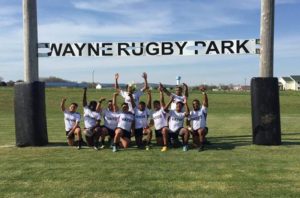
- We continue to look strong in regard to admitted students. As of today’s date, a total of 2498 new students are admitted to HU. That compares to 1526 this same date last year—an increase of 63%. This week, our Registrar, Mike Raine, characterized our performance as “on fire”—let us hope that no alarms go off. I have said before and I say again—there are no guarantees who among that 2498 will show up in the fall, but the number of admitted students is the best predictor we have at this point. Well done to Dr, Martinez. Well done to the staff in Strategic Enrollment Management. Well done to all who are working hard to improve our performance in this domain.
- On Wednesday evening I attended the Student Government banquet and gala. The new officers were installed and everyone said farewell to the graduating members of the senate. I have to say that this was one of the best events I’ve attended at Highlands. It was well organized, A ’viands did a great job with the food and service, and the incoming student government officers made many substantive comments and took some bold positions. A photo from the event:
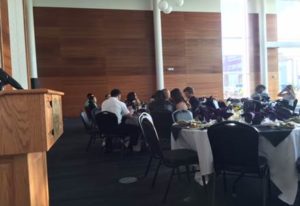
- This week, Interim Dean of Students Blea called first meeting of the advisory committee working on the lineup for the inaugural Lyceum Series (I think the group wants to call this something else, which is fine with me). As I imagine most everyone knows, this series is one component of a new initiative to revitalize campus life at HU. We’ll bring in three-four top acts over the 2016-2017 academic year. The lineup will be supported by the new student fee, which was recently endorsed by our Student Senate and approved by the Board of Regents. I am not a member of the advisory group, but Ms. Blea reported that the discussion was lively and vibrant. Participants expressed high enthusiasm for this initiative and looked forward to getting the project off the ground. The students on the committee are joined by a couple faculty and staff members, but the students are in the majority and thus, this program will be student led. As the group finalizes the roster of performers coming to campus, I will be back in touch.
- As I mentioned to a few groups on campus over the last several weeks, I will now be devoting more of my time and energy to the HU golf course. I am generally pleased with the significant initiatives taken on during the fall term and into the spring term. Advancement is doing well. That unit is nearly staffed in full and performing at a good level as noted in a recent announcement (acquiring the $500,000 match from state government for the HIPs campaign resulting in a total corpus of $750,000…and in about a six-month period). Strategic Enrollment Management is doing well right now (see item #4 above) and the campus life initiative is moving along as well (see item #6 above). Next—the golf course. It has potential to be a very strong university and community asset, but also presents some challenges. I’ll be reporting on the plans for the course as they are devised over the next few months.
- On Thursday evening, the Big Ideas Reading Group met at the University Residence. We had all read College Unbound by Jeffrey Selingo and he joined the conversation via Skype. It was a very nice evening—-good conversation all the way around. I do plan on continuing this program next fall. If you have an idea for a book, please let Brandon or me know.
Have a nice weekend my colleagues.
Sam Minner,
President
Greetings colleagues. A brief update for the week of April 18-22.
- Last week (after I sent out the week’s message), Joan and I hosted the HU Student Ambassadors at a cookout at the University Residence. This is a great group of students who do so much to help us achieve our enrollment goals. Thanks to Dr. Edward Martinez for also attending the event. I should note that I engaged the students in a conversation about the performers we should try to get to campus next fall (as part of the new campus life initiative). I mentioned maybe six or seven of my favorites—blank stares from the students. They had not heard of a single one of my recommendations. I am officially over the hill. A photo from the BBQ:
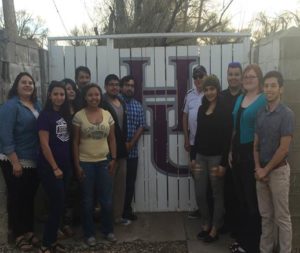
- Joan and I watched the might Vatos play last Saturday and Sunday (Stretch Internet). We prevailed on Saturday, but came up a bit short on Sunday. A plus in all this—on this trip, four of our student athletes saw the ocean for the first time. Well done to our Vatos and to Coach Greene for his high dedication to these young men. However, the season is not over. The team will leave this Friday as one of 8 national qualifiers to play in the 7’s regional tournament. If we prevail there, we go to Philadelphia to play for the national title (which we won last year). Good thoughts to our might Vatos as they bring great distinction to themselves and to HU.
- Many thanks to those attending the “value equation” roundtable discussion on Monday. I was also pleased to see a number of individuals from the community at the event. It does seem to me that we all devote great efforts to solve the immediate problems and challenges before us and too rarely engage each other in conversation about the larger issues in academe. Quite simply, time has to be made for these discussions…they do not happen all that often on their own. It was a good discussion and I appreciated the insights and ideas from the colleagues in attendance. A photo from the Roundtable:
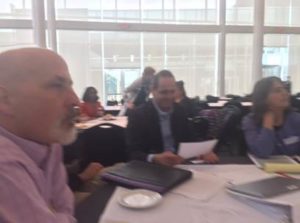
- Joan and I hosted a very nice group at the University Residence on Monday evening. The discussion focused on Women’s History Month and included very initial planning for next year’s events. I’ll provide a summary of the notes from the meeting as soon as I can get them organized. A photo from that event:
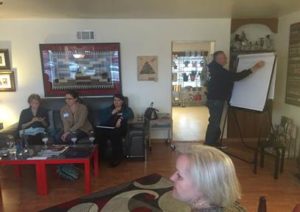
- The leadership Team met on Tuesday, as usual, and we discussed one of the Corner Office articles from Sunday’s New York Times (go to: http://www.nytimes.com/2016/04/10/business/mike-tuchen-of-talend-watch-the-road-not-the-wipers.html). We particularly keyed in on one quote from the paper, “…there are three things that matter in building a company. The first, and by far the most important, is getting the right team together and having it really be a team, who have shared cultural values and who work together and support each other. It’s not just about having the right people. The second one is have a strategy of how you’re going to win. This is the chess match part of being a CEO. And the third one is execution. That’s about having a clear set of goals, with everyone aligned around them. And we have a scorecard that we share with the board and the whole company each quarter and it shows red, green and yellow for our progress on each of the goals.” Maybe all this is true and maybe not—it is just the author’s opinion, but I ask you…let’s start at the departmental level…is there a good team in place, is there a strategy in place to achieve excellence in the discipline/major, and are there metrics to assess how things are going? Same for the institution as a whole…is there a good team in place, are there goals, and is there a system in place for keeping track of progress? The author also asserted that people looking for jobs should focus more on the specific person they’ll be working for than the reputation of the organization as a whole. We had a robust discussion on that point. We later worked on the HU Dashboard (a simple tool depicting how we are doing in regard to enrollment, retention, advancement, etc.) and we also had a discussion regarding the new campus life initiative. All in all—a good meeting, from my perspective.
- I was pleased with last year’s Homecoming Celebration and I hope to have an even bigger and better celebration this year. We now have a full-time Coordinator of Alumni Affairs and we are getting a good early start this time around. Several expanded and some new events are planned including a project where some students paint or otherwise decorate a large fiberglass horse…maybe it will be in the parade….maybe we’ll move it around town and it will just show up somewhere under the cover of night…maybe we’ll park it in front of the University Residence. Who knows? Whatever happens, it will play some role in the Homecoming celebration. The large object has arrived:
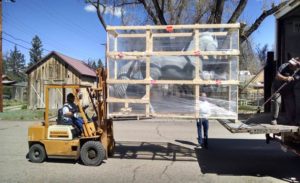
- On Tuesday evening, Joan and I hosted the last student dinner of the semester. This time we hosted some social work graduate students from Albuquerque. In addition, Dr. Diana Marrs and our visiting Ballen Scholar joined the group. It was a great evening filled with good conversation and interesting intellectual exchange. As usual, I queried the students about their HU experience and as usual, they were more than willing to share great stories about their time here and some good recommendations for improvements. The good—they love the faculty in Albuquerque. They think their program powerfully prepared them for great careers. BOTH HAVE JOBS WAITING FOR THEM. They were proud to be HU graduates. Their recommendations—improved and or a different space in Albuquerque. More services there. Stronger connections between ABQ and the home campus. It was really a great evening and I’ll give serious thought to their recommendations. A photo from that evening:
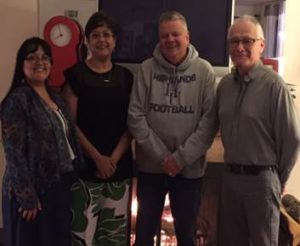
- Wednesday was a busy day. I attended the San Miguel Economic Development Collaborative (I am a board member). HU hosted the meeting in Kennedy and about 30 people attended. The focus of the discussion was on K-12 schools and the impact of their performance and reputation in drawing (or not) new people and businesses to Las Vegas. A number of local superintendents attended. It was a good discussion and I think everyone at the meeting left with a better understanding of the challenges local K-12 schools face. In my view, the superintendents of these local and regional schools are heroes. Our new Dean of Education, Dr. Lora Bailey, agreed to establish a sub-committee to investigate possible solutions to improving performance. Later that evening, I attended the board meeting of Main Street de Las Vegas (again, I am a board member). Many good things are happening in Las Vegas…some new businesses, some new investments, etc. As always, I remain hopeful about the future.
- Early Thursday morning I met the new student government executives and later that day I attended the Career Fair and luncheon. We had a tremendous level of participation at that event. Well done to Ron and his team. Then foolishly, I spent a few minutes in the dunk tank. The Rez Fest was also a great event this year. Yvette and her team deserve high praise. The day concluded with a few remarks at the HU Scholars dinner. The HU Scholars event was wonderful with good attendance and high enthusiasm. Well done to VP Martinez and his team. A photo from the Rez Fest:
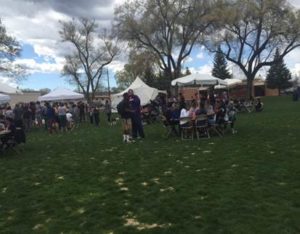
- We have a pretty vibrant community of runners here at HU including a member of the HU Foundation Board—Mr. Antonio Lopez. Mr. Lopez recently completed the Boston Marathon. Well done Antonio! One mile to go—looks like he will make it.
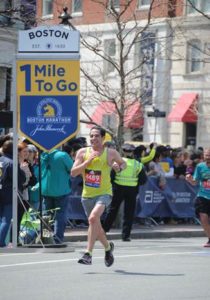
- The HLC team leaves this Sunday. We’ll provide a report once we hear something.
Have a nice weekend my colleagues.
Sam Minner,
President
Greetings colleagues. A brief update for the week of April 11-15.
- The HLC Team continues to prepare for the meeting in Chicago. We met on Monday and had a conference call with an HLC executive. It was a helpful call and he provided some good advice for our presentation. I appreciated those who attended the HLC meetings this week. One meeting was held Wednesday and another on Thursday. Many thanks to the team who prepared our HLC response—Provost Aguilar, Mr. Max Baca, Ms. Kim Blea, Dr. Jean Hill, Dr. Kathy Jenkins, Dr. Brandon Kempner, Dr. Carol Linder, and Dr. Edward Martinez.
- I attended the HU Reads reception on Monday. The posters were very well done, in my view, and it was interesting to see what people were reading. Adult reading has been in decline for some time and it is important for the staff and faculty to emphasize the value of reading in everyone’s life. Books and other written materials are more available now than ever before (e.g., Project Gutenberg, go to: http://www.gutenberg.org/) and yet, fewer adults are reading. That is not a good trend. What to do? Our modest HU Reads Campaign is but one effort to change that trend. One of the posters from the HU Reads campaign:

HU READS poster
- The Leadership Team met on Tuesday, as usual. We met Mr. John Byrne who is working with a friend of HU to bring new students to Highlands from Chicago, Illinois and we talked about how the initiative might work. This week, some members of the executive team were hosted by those planning the program at a wonderful dinner at the Charles R Ranch. A photo from that event. More on this possible program later.

- Participation in this year’s “Best Campus To Work For” survey ends this week. The Campus Climate Committee voted to administer this survey as a kind of baseline to help us understand the areas most people think we should work on to make HU the best it can be. When I last checked, HU had a 27% response rate, which is fairly high and according to ModernThink (the company that actually administers the instrument for The Chronicle of Higher Ed). This response rate should allow us to make some good judgments about what to focus on to improve campus life. I thank Dr. Ed Harrington and the members of the Campus Climate Committee for taking this action. The committee will be in touch with the campus community once we receive our results.
- The mighty Vatos play in California this weekend and if they prevail, they will move on to the championship round. The Vatos will play the Keelhaulers on Saturday, April 16 at 12 noon. Send good thoughts to our wonderful Vatos student athletes as they compete at the highest level and bring honor and distinction to themselves and HU. If we play for the championship, I will try to organize a watch party where folks from campus and the community can view the game on a large screen. A photo of our mighty Vatos:
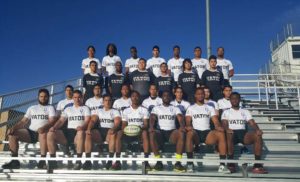
- As of today’s date, 2384 students have been admitted to HU compared to 1467 this same time period last year. That is 917 more or about a 63% increase. Our Registrar, Mike Raine, recently referred to this increase as a “blistering” pace. This is good news….now, we need to close the deal and get those students here.
- Joan and I attended the Employee Recognition Breakfast on Wednesday morning. We and everyone in attendance enjoyed the nice breakfast provided by A ’Viands and, of course, we also enjoyed honoring so many great HU colleagues. It was a special treat to award the first President’s Service Award to Ms. Darlene Chavez who I think was truly surprised when she received her check. To serve others—in any way, really—is a beautiful thing and Darlene certainly embodied that while she was here with us. My favorite quote about service to others—this by Rabindranath Tagore, the Bengali poet and the first non-European to win the Nobel Prize in Literature— “I slept and dreamt that life was joy. I awoke and saw that life was service. I acted and behold, service was joy.” A photo from the event and I think the image supports my assertion that Darlene was truly surprised:
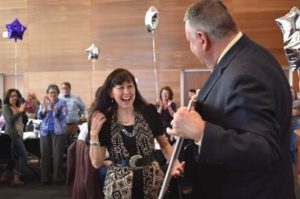
- Also on Wednesday, I met with about 15 students from Tierra Encantada, a dual language and project-based charter school in Santa Fe. These students, all graduating seniors, were looking at colleges and universities and I did my best to convince them that HU was a good choice. Their hopes and dreams were inspiring to me and
- Things are nearly set to strike a deal with Nike. If finalized, our HU student athletes will wear Nike apparel and we will be officially designated as an “all Nike” school—the only such school in the RMAC. Well done to AD Clifford and his staff for making this happen. Also in HU athletics, we recently hired an interim women’s basketball coach—Joseph Anders. Coach Anders coms to us from UNM where he served as an assistant coach and helped the Lobos recently make two postseason tournaments. He has also worked at Arizona State, Eastern Carolina, Mississippi State, and Northern Arizona. Please welcome Coach Anders to HU.
- I just received an interesting analysis examining the productivity of public institutions in the state. Basically, the graph below depicts productivity as a relationship between costs and the production of degrees. As you can see in this analysis, HU is the most productive institution in New Mexico. The data are indexed to associate degrees so two-year schools can be included in the overall analysis.
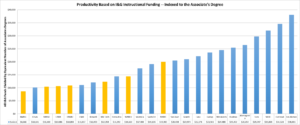
- On Thursday evening, Joan and I will host the HU Student Ambassadors at the University Residence. Our ambassadors do a great job and convince many students to give HU a hard look. In many cases, they seal the deal and bring students to our campus.
- I am sponsoring a planning meeting/social at the University Residence on Monday, April 18 from 5:00 p.m. to 6:30 (or thereabouts) to begin the planning process for next year’s Women’s History Month. I was not really pleased with what we did this year. I have a few preliminary ideas—using the poster stands we recently acquired for the HU Reads Campaign to highlight the “Great Women of Highlands” (posters of HU women and a bit of their personal story, which would be prominently displayed around campus), maybe a daily email blast titled something like HU Her Story…brief essays from and or about HU women past and present and or women who made a difference in our lives, a guest speaker (maybe Linda Hallman, CEO of the national AAUW), a modest film series (maybe LUNAFEST, go to: http://www.lunafest.org/), etc. I am sure others have more and better ideas. At any rate, let’s get together and get this planned. Light refreshments will be served at the event. At some point, I’d like to bring our students into the discussion. I am also inviting members of our chapter of the AAUW to this planning event. All are welcome to join the discussion…no RSVP necessary. The address: 1325 5th Street.
- A board meeting will be held Friday and I’ll send out a summary of the actions taken by the board shortly thereafter. Joan and I will also attend an Isotopes game on Friday evening where we’ll be hosted by some good friends and benefactors of HU.
- HU and the United World College are co-sponsoring a number of dance classes and performances this weekend. There will be a free master dance class on Friday. It is open to HU and United World College students. The class will be held at 4:00 p.m. in Ilfeld. Another free master class—this one for members of the community—will be held on Saturday, April 16 at 2:00 p.m. That class will be in Kennedy. Call 505.454.3238 to register. The UWC will stage a dance concert in Ilfeld at 7:30 p.m. on the 16th. And finally, on Sunday the 17th, there will be a Las Vegas Youth Dance Showcase at 3:00 p.m. in Ilfeld featuring Lori Bovia’s Los Zapateados Follorico dancers and Sarah Flores ballet and jazz students. Again, those performances are free to the public. I also urge you to attend the roundtable discussion on Monday, April 18 at 2:00 p.m. in the Student Union where we’ll focus on the value of a college degree in contemporary America. This event is open to anyone on campus and in the community. For more information, contact Diana Marrs at the Center for Teaching Excellence. Her email is dmarrs@nmhu.edu.
Have a nice weekend my colleagues.
Dr. Sam Minner,
President
Greetings colleagues. An update for the week of April 4-April 8.
- I appreciated the fact that I saw so many good colleagues at the Mozart Fest last Sunday. It was a wonderful performance with great attendance and a prime example of how HU has and continues to bring the community together to celebrate one of the most inspiring and uplifting elements of life—great music. It truly lifts the human spirit, does it not? That was evident to me on Sunday afternoon. Well done to Andre and all who helped make this happen.
- Later that same Sunday, I met with the Student Senate to discuss the Campus Life Proposal. As you may recall, I introduced this initiative to our students last fall. In an effort to improve the quality and the number of intellectually stimulating, fun, and healthy activities on campus, I proposed a new student fee to support three campus life activities. First, the fee would support a new office tentatively called HU Outdoor Recreation. Students could check out equipment from this office (e.g., camping equipment, windsurfing equipment, etc.). The new office would also sponsor various clinics (e.g., fly fishing, bouldering, windsurfing, etc.) and organize various excursions (e.g., great hikes in the region, skiing trips, etc.). The basic idea here is to take advantage of the incredible place we live and get students out in that environment to learn new things and have fun. Second, the fee would support many additional on and near campus social activities such as concerts, dances, comedians, films, etc. Some of these will be on campus and some may be off. I want the campus to be much more vibrant and I want many more things going on for students to do. I would love to have a live band or a DJ in the quad every weekend, weather permitting. I think it is also highly desirable to have more events in the community, which would be fun for our students and help foster some additional economic development. Finally, the fee will cover what I am referring to as the HU Lyceum. This will be an annual performance series—probably three to four performances per year—bringing top acts to our campus. I want to bring symphonies, dance recitals, maybe an opera or a ballet every other year, perhaps an annual Christmas performance of Nutcracker with live orchestra and local kids as the mice, etc. These would be top level acts…things like national touring orchestras, the Vienna Boys Choir, touring companies doing Carmen, etc. Admission to these performances would likely cost quite a bit in large metropolitan areas. There would be no cost at the door to our students (really, supported by the new student fee). Members of the community would be required to pay an admission fee, but as always, we’d try to make it as affordable as possible for everyone. I very much appreciated the student support of this initiative. Next, I’ll present the concept to the board. Since it is a new fee, the board will have to approve it. I’ve also had a number of good conversations with colleagues who are potentially interested in getting involved in this project, particularly the outdoor recreation dimension of the initiative. I know we have many faculty and staff members who are avid outdoor folks. Indeed, I think some of our colleagues came here initially because of the scenic wonders of Northern New Mexico and the many incredible opportunities to get out into the region and experience it firsthand. Some of these faculty and staff members want to get involved in this new venture. I think that would be a great thing and I hope it comes to pass.
- Wonderful things are happening in HU athletics. Mr. Alvaro Gonzalez, one of our top baseball players, was recently named the Subway Athlete of the Week for his incredible performance in last weekend’s games. Alvaro batted .714 with 10 hits, nine runs, three doubles, and three homers. He was also perfect in the field. Wow. Congrats to him, our great baseball coaches, and the entire Cowboy team. I briefly visited with the team on Wednesday afternoon—a really great group of guys and wonderful representatives of HU. Ms. Karin Gadberry, her staff, and her team also had a great weekend and have a lot of momentum going forward into the final phase of the season. One of our top student athletes, Ms. Jacquelyn Solis, was recently named the RMAC Softball Player of the Week. Ms. Solis led the Cowgirls to a sweep over Eastern and Black Hills. She batted .500 and was perfect in the field. Well done! Ms. Shanice McPherson took home first place in the long jump at a recent meet at UNM. Her performance makes her the D2 national leader. We are having some serious conversations with a benefactor to bring students from Chicago to HU to get a good education and possibly play a sport at the D2 level. More on this later. The mighty Vatos beat Angelo State last Saturday and will now advance to the National Small College playoffs in California. The Vatos will play California Maritime Academy, the #1 team in the NorCal Conference. Well done to all of these wonderful HU student athletes and good luck to them as they finish up their seasons. Finally, I will be throwing out the opening pitch at an upcoming Isotopes game and have been practicing for some time now. In my current physical condition and given that the last time I picked up a baseball was in a prior century, I find the distance between the mound and home plate to be…daunting…and I am faced with a professional and personal dilemma. I could wimp out and move half the distance to the plate (or more) and maybe get the ball across. Maybe. I could throw from the mound, but do the rainbow kind of throw and hope that the combined (low) velocity and (considerable) height of the throw might make it to the plate. Again, maybe it would make it. Or, I could just take the mound and toss as best I can, which is likely to result in a ground ball to home plate. Yet another option is to feign some type of injury and not throw at all. Utter and complete humiliation is a real option irrespective of my choice. I welcome your thoughts, my colleagues.
- At this week’s Leadership Team meeting, we discussed the concept of “grit” or resilience. Go to: http://www.nytimes.com/2016/03/13/business/anthony-foxx-grit-goes-further-than-genius.html?_r=1. Lots of people think that grit is really more important than anything else—more important than intellectual ability, more important than academic pedigree, more important than experience…more important than anything. I’m not sure that I would go that far, but I do think it is very important. When I hire someone, I look at their CV, their accomplishments, where they went to school, etc. but I also really concentrate on resilience issues. Are they truly committed to getting important things done…no matter how hard it is? I have to obviously make judgments about that and I am sometimes wrong, but I’ve hired enough people to get a pretty good sense of that in most cases. A few people have even suggested that there is an inverse relationship (or at best, an orthogonal relationship) between grit and intellectual ability. I don’t know about that either, but I have certainly known a few people who seemed to function that way…they were super-smart, but really did not get all that much done because they quit on things too soon or too easily. It was a good discussion and one I will reflect on. Most of the remainder of the meeting was spent discussing and planning for the upcoming board meeting.
- I have selected the first HU Leadership Fellow. It is Dr. Jennifer Lindline. Jennifer will start her experience this fall although she may join meetings of the Executive Leadership Team this spring and summer, as her schedule permits. Please join me in congratulating Jennifer and thanking her for taking on this new responsibility. We need great, smart, and courageous leaders in higher education. Jennifer clearly meets those criteria and it is my hope that this leadership experience will benefit her and encourage her to pursue those roles.
- I met an incredible HU student on Tuesday—Mr. Melecio Perea. Mr. Perea will soon graduate from HU and attend a top Ph.D. program in chemistry supported by a prestigious fellowship from the NSF. Perea earned a 4.0 GPA at HU and was accepted into seven Ph.D. programs including Yale, UC-Berkeley, Northwestern, and others. Wow. Just wow. Congratulations to this incredible student and many thanks to Dr. Brooks Maki and other professors and staff members who helped Melecio achieve at such a high level. I should also note that Melecio is a local student—from right here in Las Vegas. He graduated from West. HU changes lives—one student at a time. This is but one example—but a really great one. A photo of Mr. Perea:
Photo by Margaret McKinney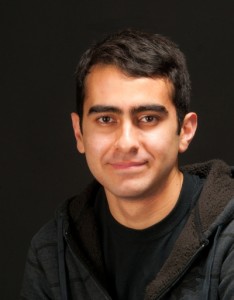
Another photo of Mr. Perea, Dr. Maki, and me:
Photo by Margaret McKinney
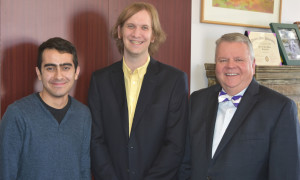
- Also on Tuesday, I met with some adjunct and contingent faculty and we had a very nice conversation. I thanked them for everything they do at HU and discussed the reality that the majority of undergraduates in America are now taught by part-time, adjunct, and or contingent faculty. Some faculty asserted they had never had an opportunity to get together as a group and I promised to continue to make that happen. There were some issues they brought to my attention and I do plan on addressing them as I can. My colleagues—the part-time, adjunct, and contingent faculty here at Highlands are great assets who devote their considerable expertise, passion, and skills to this place and the students we serve. Please go out of your way to thank them for their high efforts. We could not do what we do without them.
- Joan and I drove to Albuquerque Tuesday evening to hear Justice Sonia Sotomayor. There was a nice HU contingent at the talk, including several of our colleagues from the Centers. This was a ticketed event and as expected, it was a sellout. Many thanks to Provost Aguilar for making people aware of this event. The Justice is quite a wonderful person and her remarks were very inspirational to me and apparently, to everyone in attendance. It was really a great evening.
- Mr. Raines reports continued improvement in the number of admitted students compared to this time last year. We have more than 1100 fully admitted students in the pipeline compared to this time in 2015. Let us hope.
- On Wednesday evening, Joan and I hosted another student dinner at the University Residence. This time, we welcomed some students from our Centers—specifically, Santa Fe and Albuquerque. As has been the case in the past, the students were absolutely wonderful…full of high enthusiasm, positive attitudes about the future, and great representatives of HU. I also queried them about how HU could get better and heard a number of suggestions ranging from providing some food options at Santa Fe, engineering some options for tutoring assistance (again in Santa Fe), and thinking about some change in facilities in Albuquerque. Several students suggested that we should work on the quality of the transmission of classes from the home campus to the Centers (e.g., hard to see, hard to hear, etc.). I promised the students I would think about their input and do what I could to act on their recommendations. A photo from the event:
Photo by Joan Minner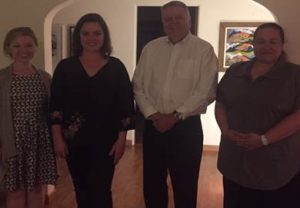
- On Thursday afternoon, Joan and I visited the renovated Automotive Technology Building at Luna. It is a very nice facility preparing students for good jobs and productive careers. Congratulations to all at LCC for making this happen. A photo of me and Mr. Abelino Montoya, a member of the Board of Trustees at LCC:
Photo by Joan Minner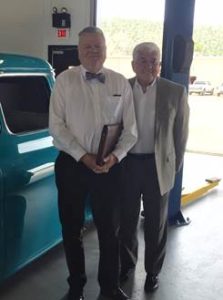
- I am sponsoring a planning meeting/social at the University Residence on Monday, April 18 from 5:00 p.m. to 6:30 (or thereabouts) to begin the planning process for next year’s Women’s History Month. I was not really pleased with what we did this year. I have a few preliminary ideas—using the poster stands we recently acquired for the HU Reads Campaign to highlight the “Great Women of Highlands” (posters of HU women and a bit of their personal story, which would be prominently displayed around campus), maybe a daily email blast titled something like HU Her Story…brief essays from and or about HU women past and present or women who made a difference in our lives, a guest speaker, a modest film series, etc. I am sure others have more and better ideas. At any rate, let’s get together and get this planned. Light refreshments will be served at the event. At some point, I’d like to bring our students into the discussion. I am also inviting members of our chapter of the AAUW to this planning event.
- The Board of Regents will meet this Friday. It is a full agenda, as usual. Among other items, there will be a presentation regarding tuition and fees and the board may take some action in that regard. Once we know what the tuition increase, if any, will be we can prepare a budget for the next academic year. There will be another board meeting to present the budget. Shortly after the meeting this Friday, there will be a general campus communication summarizing the actions taken by the board.
Have a nice weekend my colleagues.
Sam Minner,
President
Greetings colleagues. A brief update for the week of March 28-April 1.
- A number of prospective students from California were on our campus this week. I met with them, welcomed them to our campus, and answered some very good questions they posed. So many students in CA simply cannot enroll at state four-year schools or even community colleges due to crowded conditions and many of those students are interested in HU as an option. The visit was coordinated by Strategic Enrollment Management. I thank that team and all others who welcomed the students to our campus.
- Joan, my nephews (visiting from Missouri), and I attended the performance of They Call Me Q on Monday evening. This play is part of the NMHU Culture Fest. Starring Qurrat Ann Kadwani, the play traces the life of “Q” from India to the Bronx. It was a wonderful performance and I was pleased to see good attendance at one of the first events of Culture Fest. Those events continued throughout the week. We all also hand lunch at the Asian Fest on Thursday. A photo from the International Tasting event on Wednesday…my niece (now a student here) and my nephews (visiting):
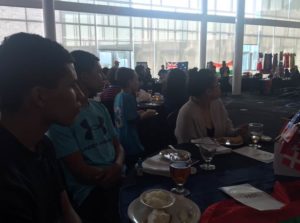
- The campaign to fund our application to the Higher Education Endowment Fund is now at an end. In brief, this began when I received a notice from HED Secretary Barbara Damron that public institutions could apply for funds to support specific projects in higher education. The arrangement was that schools could get two dollars from the state for every dollar raised from private sources. HU submitted an application to support an initiative titled HU-HIPs: A Comprehensive Faculty Development Program. If funded, the program would support the faculty development to promote more high-impact practices on our campus (e.g., undergraduate research, service learning, community based projects, study abroad, learning communities, etc.). We requested $500,000 from the state, which meant we had to raise $250,000 in private dollars. I should note our goal was much higher than any of the other comprehensive schools and even higher than most of the applications submitted by the research institutions. I knew it would be a stretch to achieve our goal, but I thought it was attainable. Twenty-eight institutions of higher education submitted applications and sixteen of them were approved to move on to the next round. Our application was approved and we immediately planned a campaign to raise the money and went to work. The campaign included a number of receptions/fundraisers in Las Vegas, Santa Fe, and Albuquerque, a staff and faculty appeal, several mailings to alums and friends, and direct appeals to selected prospective donors. We raised the $250K from many friends and supporters of HU and we will soon receive the $500,000 from state government. As previously noted, this is an endowment—the funds will be placed in safe investments and we will spend the returns from the endowment on various HIPs activities. This fund will exist in perpetuity. One final note—if schools in this competition could not get their private match, the funds would then be available for schools who did achieve their match and received donations in excess of their match goal. In other words, we said we intended to collect 250K of private dollars in order to get the 500K from the state. We did that, and we can do more if more matching funds are made available. There is a possibility, not a certainty but some possibility, that we will indeed take in another $100,000 in private donations for this endowment. If that comes to pass and $200,000 is available from the state (due to some schools not getting their required match) to fully match our $100,000, we could potentially have another $300,000 in the endowment resulting in a total endowment in excess of $1mil. This is a wonderful thing and a great achievement for HU. Many people played a large role in making this happen and I hesitate to name them for fear of leaving someone out, but…I must thank the entire Advancement Team including VP Law, Ms. Salmon, Ms. Weaver, Mr. Mandarino, Ms. Maestas, and Ms. Chavez. Mr. Sean Weaver was my go to person in Advancement while we searched for a permanent VP. Numerous faculty colleagues (Dr. Carol Linder, Dr. Brandon Kempner, others) participated in a campaign video to solicit private dollars. Provost Aguilar challenged her direct reports to make a matching contribution and many of them did so. Board members contributed in a meaningful way. Our University Relations office, especially Margaret McKinney, did a number of very nice stories on this initiative. Bottom line—HU is at least 3/4mil better off than it was a few short months ago. This is how institutions get stronger….by taking matters into their own hands to the maximum degree possible. Get more people to contribute. Get more students on campus. This is precisely why I have invested this year in advancement and enrollment management. Well done, well done, well done to all who made this campaign a success.
- The Leadership Team met this week, as usual, and we began the discussion after reading this: http://www.nytimes.com/2016/03/20/business/aaron-bell-of-adroll-the-truth-may-hurt-but-it-also-heals.html. Basically, the author likened organizations to living organisms (hardly the first time that has been done) and we posed the question: If an organization (say, HU) is “like a human body”, what toxins are built up in the system? What might be done to “flush the toxins out” of the system? It was an interesting discussion and several “toxins” were identified—basically, grievances from the past that are “stored up” and continue to be discussed and in some cases, serve to impede forward progress. The toxins were about what you would imagine and are commonly found in most organizations—someone treating someone else unfairly or disrespectfully, too little listening, someone being dismissive of another’s point of view, etc. These organizational toxins may be real or imagined—it makes little difference really. Either way, they can get in the way of progress and make for a less than ideal environment. Plus, living with some toxins in your system is frequently unpleasant. You just don’t feel very well. Identifying the toxins is easy enough. Deciding what to do about them, if anything, is more challenging. Merely acknowledging them can help sometimes. But usually not. Just moving forward and holding oneself to a high standard of professionalism and respectful interaction can help over time. But, sometimes it does not and even if it does, that can sometimes take a very long time to turn things around. No silver bullets were really identified as this is almost always a complex and idiosyncratic matter. Sticking with the toxins in the human body metaphor, there was some agreement that the complexity of those dynamics is mirrored in organizations. That is to say, one person can live for years on a junk food diet and really suffer minor ill effects. It is unusual, but it does happen from time to time. Another person can have the same diet and come down with many chronic health problems. Why? Because of other relevant variables. Likewise, someone in an organization can suffer in some way (e.g., not receive a promotion she or he thought was deserved, not appreciated, etc.) and that can be stored as a kind of toxin for years. Maybe forever. Another person can have the same experience with little or no toxic effects. Why? Again there must be many other variables at work to explain the difference. Even if that is all true, it really does nothing to point in the direction of what to do to expunge organizational toxins. It was a really interesting discussion and I will reflect on the conversation into the future. If anyone has thoughts about how to eliminate toxins, I am interested.
- We continue to press on yield and get as many students as possible on campus or at Centers for the Fall, 2016 term. The most recent data from Mr. Raines’ office notes that as of March 30, 2016, 2,299 undergraduates have been admitted to HU. This compares to 1385 on the same date last year. This is a healthy increase—904 more than last year. Assuming a 20% yield (typical performance for us historically), we could enroll almost 200 more undergraduates this fall. That would be a wonderful thing. Many thanks to Dr. Martinez, his staff, and everyone who is helping to bring more students to campus.
- The Board of Regents will soon be setting tuition and fee rates for 2016-2017. I have been very pleased with the many discussions I’ve heard around campus about this matter. From my perspective, it is a wonderful symbol of how engaged so many faculty and staff are in campus life and how everyone powerfully understands how the decisions we make truly impact our students. I should also note that the tone of these discussions has been respectful and at a high level. This is how educated women and men interact with each other—no ad hominem attacks, no flaming emails, as much listening as talking, and basing arguments (to the degree possible) on ideas, facts, and careful thought and not mere emotion (although a bit of that is perfectly OK as well). In other words, exactly how the people at any institution of higher learning should function and for that…I am very happy. We’ll see what our board does on all this, but I thank my colleagues for their high interest in this matter and the deportment we have collectively demonstrated to discuss, debate, and attempt to convince others of our positions. The potential impact of tuition increases has been studied. At my previous institution, I relied strongly on a study titled The Impact of Tuition Increases on Enrollment at Public Colleges and Universities by Steven Hemelt and Dave Marcotte. The study was published in the Journal Educational Evaluation and Policy Analysis (September 10, 2011, Vol 33, no 4). The study is a little dated, but I learned that this study is considered a “classic” when it comes to tuition elasticity. Data from the entire higher education sector were examined in this study. I am not intending to cherry-pick here, but a few of the major findings from this study:
a.) like most goods and services, an increase in cost results in some people not purchasing the goods or services, but the devil is in the details when it comes to that dynamic, especially in regard to higher education. On average across the higher ed sector (all types of institutions), a $100 increase in tuition resulted in about a .23% decrease in credit hour production (a decent proxy for enrollment),
b.) tuition elasticity (the amount enrollment falls with increased tuition) is greater at Research I institutions than comprehensive schools like HU,
c.) students at schools like HU were more sensitive to aid changes than tuition changes (in other words, although tuition increases at comprehensives may not necessarily decrease enrollment by much if any, they may increase student reliance on financial aid, work study, etc.),
d.) relatively large tuition increases (defined in this study as more than 15% in one year) did not have any additional impact on enrollment trends at any school included in the study, and
e.) on average, an increase in tuition brought in more revenue from enrolling students than the loss from students who would have enrolled at a lower cost. - Here’s a great HU success story—-Mr. Melecio Perea, a senior chemistry major, recently learned that he won a Graduate Fellowship from NSF. He will receive full support and a stipend for three years of graduate study. More than 17,000 students applied for one of these awards. Congratulations to Melecio, to his advisor Dr. Brooks Maki, and to everyone at HU who helped this student achieve at such a high level. HU changes lives…this is but one example.
- I will be out of town on Friday to attend a Council of University Presidents meeting and Joan and I will remain in Albuquerque for part of Saturday to see the mighty Vatos play. I will attend the musical performance on Sunday and also attend the Student Senate meeting where I will learn of their level of support for the Campus Life initiative.
Have a nice weekend my colleagues.
All the best,
Sam Minner,
President
Greetings colleagues. A brief update for the week of March 21-25.
- The NMHU Foundation Board met last Friday in Rio Rancho. It was a full day beginning with a wonderful breakfast in the home of Mr. Joe Montoya, one of our board members, various committee and board meetings throughout the day, and finally, a reception for alums at 5:00 p.m. Vice President Terri Law will be sending out a summary of the full-day meeting. The actions of the Foundation are very relevant—even important—to all faculty and staff and I encourage you to peruse her notes.
- The “HU Reads” poster campaign is up and the posters have been distributed around the campus. Virtually every study suggests that adult reading is on the decline these days and as the resident academics, we should do what we can to counter that unfortunate trend. Many thanks to the individuals who worked hard to get this organized.
- The deadline is past for applications to the HU President’s Leadership Development Program. As was noted in the call for applications, the President of the Faculty Senate, the Provost, and I will soon make the selection. The selected individual will be released from one class during the Fall, 2016 and the Spring, 2017 terms. The individual will have an office in Rodgers and will participate, as schedules allow, in a number of administrative/policy/budget meetings. Assuming funding is available, the individual will also have access to some top professional development. An announcement about the selection will be made soon.
- A few weeks ago, I met with the Full Professors on campus and we had a nice conversation about HU and our future. There was some interest in getting together in a less formal setting so Joan and I hosted the group at the University Residence. It was a very nice event and allowed for some good conversations. Full Professors have their own perspectives, of course, but other groups also have their own interests, ideas, and points of view. I recognize that and therefore, I’ll be meeting with other groups throughout the spring term and beyond. The next group I will meet will include part-time/adjunct/contingent faculty. I’ll be calling that meeting soon. If that group expresses an interest in some social activity, I’ll schedule that as well. Meetings with other faculty groups will be scheduled in the future.
- We have several weeks remaining in the spring term and I hope to come up for some air soon and do some reflecting on my first year here. I will schedule an open forum and I’ll share my thoughts there, but…for now, here’s my musings: I spent much of the fall term and some of the early spring term on personnel matters and I made several changes. I hired a VP in Advancement, a new Athletic Director, a Dean of Students, and a Vice President in Strategic Enrollment Management (VP SEM). All of these appointments were replacements with the exception of the VP SEM. As I have said many times, I believe that the strength of the team is more important than the strength of any individual member of the team. So, I pay close attention as teams are built and I will say that today, I am very pleased with the sitting leadership. I trust them. I know they are people of integrity. I know they will do their best to improve HU and contribute to the greater good. Plus, they are an intellectually stimulating group and fun to work with. These new folks who joined some leaders already in place when I arrived…the Provost, the VP Finance, and others…have come together as a strong team, in my view, and I am very pleased with what I see happening. We have also made a number of changes in our athletics program. The goals there—recruit student athletes of high integrity, hold them to high standards on and off the field, do everything possible to make certain they graduate, and expect them to play hard and with passion, which will yield many wins. AD Clifford and I share these ideals as do our coaches. I am very optimistic about our athletic program. Very soon, we will make an announcement regarding the HIPs initiative. That announcement will be positive and that $750K endowment will increase the corpus of our Foundation funds by about 15%. An increase of 15% in about a six-month period. That is very good performance. It may well be a record here at HU. Turning to enrollment, we continue to press on our Fall, 2016 yield. Again, I am making no promises about fall enrollment, but the best predictor we have right now is the number of admitted students. I am very pleased about how all that is going. As of today’s date and using historical yield rates, we could see about 423 additional students on our campus this fall. That would be a great accomplishment. A great deal of energy during the fall and first-half of the spring term has been devoted to our HLC response. That document is now done and has been sent to our accreditor. In my view, we have prepared the very best possible responses to the HLC concerns. We’ll see what happens when the team is in Chicago, but given the high and collaborative efforts made to get things done and prepare an excellent report, I am totally and fully confident of our ability to address the various issues in the HLC report. It is really only a question of how and when that is done. Obviously, I’d prefer that it is done sooner than later…but it shall be done, no doubt. In the Spring term, I focused on what I call the “campus life” initiative, which is an effort to add additional healthy, interesting, and fun activities to campus and near campus venues. I made a presentation to the Student Senate and I will soon hear from our students about their level of support for this project. If students support it and if the Regents approve, we will be adding several programs designed to enhance campus life. We’ll engineer a new office on campus—tentatively called the HU Office Of Outdoor Recreation—where students will be able to learn about the incredible outdoor opportunities in our region and check out a variety of outdoor equipment. Various clinics will be held there (e.g., bouldering, fly fishing, etc.) and the office will arrange excursions to different locations in the area (ski trips, hikes, etc.). A second dimension of the campus life initiative will be many more on and near campus activities—bands in the park on Friday evening, more social activities in local venues, etc. The third and final element of the initiative will be bringing major acts to campus including symphonies, plays, etc. I am initially referring to this as the HU Lyceum Series. Every year we will bring top-notch acts to campus. We’ll see what the students and the Regents want to do on all this soon. I’ll focus the remainder of the spring term on the possible development of the golf course. So…all this has been Year One for me in addition, of course, to the routine management functions required to keep things going. I have also devoted a great deal of effort to my other board goals…specifically, trying to be active on campus and in the community and promoting the professional development of the administrative team. Overall, I am pretty pleased with these various activities, but also recognize there is much more to do.
It is all too easy for people who have the kind of job I have to be consumed by personnel decisions, budget issues, legal matters, and the minutiae of logistics and operations. Highlands does not exist to do those things…those activities are only in service to our true and real goals. Those goals are to work as carefully, as creatively, and as powerfully as we can to take students where they are, to help them achieve at the highest possible levels, and to graduate them to go onto lives of high purpose and meaning. Good jobs. Engaged citizens. Leading lives of integrity. I never forget who are the key players in achieving those outcomes. That would be you, my colleagues. That would be the staff and faculty of HU. I don ‘t need to reflect at all in order to gain that understanding. I understand that now and for the work you do to achieve our noble goals…I thank you sincerely. It is a privilege for me to serve here and to call you my colleagues.I will be out of the office on Thursday and, of course, the campus is closed on Friday. Hence, my end-of-week note today. I hope everyone takes some well-deserved R&R during the extended time off.
All the best,
Sam Minner,
President
Greetings colleagues. A brief update for the week of March 14-March 18.
- This week we had a good discussion at the leadership team meeting about living near campus…or not. We all read this essay:http://news.yahoo.com/more-innovation-colleges-push-faculty-live-near-campus-153252715.html. I liked this quote from the essay, “Like coral reefs, universities function at their highest capacity when there are many organisms milling about and exchanging information in close proximity.” Since I arrived about eight months ago, I’ve heard many concerns about faculty and staff who work at HU but do not live here. So—I’ve wondered…is this a real problem? If so, how deep does it go? Should we try to do something about it? What? Does it really matter where someone lives if they try hard while they are on campus? At our meeting, we discussed reasons people do not live in town and I’ve now heard this laundry list many times. The problems/challenges—housing, K-12 schools, lack of healthcare providers, and lack of the kind of retail many people desire. We ended the discussion with some potential solutions for some of these challenges. More on all that later. The remainder of the meeting was spent discussing the HLC report, an update regarding the branding campaign, and the development of some type of dashboard we’ll devise to allow people to quickly see how we are performing as an institution. As usual, there were also updates from each division, the faculty senate, the staff senate, etc.
- Everyone knows how important I think it is to build a strong recruitment and retention program. Those programs predict our near and long-term health as much as more than anything else. To assist our students with tutoring, we have recently contract with NetTutor, a firm providing 24/7 assistance to HU students in a variety of disciplines. The “old” way to provide tutoring services—students made their way to a center or some office where they met with a “tutor”—often someone not trained in how to be a tutor at all. Sometimes good things happened. Sometimes not. But, the problems with this approach have been many and varied across the higher ed sector. What if a student could not go to the center during the times they were open? What if the tutor really knew very little about what the student needed? I can relate to that one when I “tutored” students needing help in Calculus and I had just passed the class the prior semester. To be frank, I often knew very little more than the individual seeking my advice. What if the tutor knows the discipline, but is ineffectual in teaching students? We’ve probably all known people like that—deep knowledge of the discipline and poor skill as a teacher. We have good tutoring services at HU, in my view, but it is my hope that our new arrangement with Net Tutor will provide even more and more powerful services to our students. Be looking for some announcements regarding this new tutoring program. It will be led and managed by the Division of Strategic Enrollment Management under the direction of Interim VP SEM Edward Martinez.
- Several HU athletes had great performances last weekend at the NCAA Division II Women’s Indoor Track and Field Championship. Ms. Salcia Slack won two national championships—taking first place in the pentathlon and the triple jump. Teammate Ms. Shanice McPherson finished 11th in the long jump. Notably, she still holds the DII record for long jump she set last year. Congratulations to these great Cowgirls! Also, five of our wrestlers received Academic Team Honorable Mentions by the NCAA II Wresting Coaches Association. Congrats go out to Mr. Jonathon Bechtloff, Mr. Jacob Espana, Mr. Dan Gaylor, and Mr. Jacob Hawthorne. Well done to Coach Moses and our athletes. Our mighty Vatos continue to do well and are hopefully on their way to another title.
- I encourage everyone to attend the April 23, 7:00 p.m. performance of the USAF Band. The performance will be in Ilfeld and is FREE to all. Pick up tickets at the box office. These are great musicians who travel the world as musical ambassadors of the United States Air Force. It promises to be a great performance.

- As of today, 2,173 students have been admitted to HU for the fall term, 2016. That is 869 more than this date last year.
- I am sending this message today instead of Friday since I will be at the HU Foundation Board meeting all day Friday. I’ll provide a summary of the actions taken at the meeting next week.
I hope everyone had..or took…some time this week for some well-deserved R&R. All the best, my colleagues,
Sam Minner,
President
Greetings colleagues. A brief update of activities for the week of Monday, March 7-Friday, March 11.
- Many thanks to the Full Professors and member of the Leadership Team who attended the social event at the University Residence last Friday afternoon. Good food and good conversation were both in abundant supply.
- On Sunday I drove to Farmington in order to attend some early Monday morning meetings at the Farmington Center. I visited the Center, met with the faculty and staff there, and had a very nice tour of the San Juan College campus. My tour guide was Dr. Toni Hopper Pendergrass, President of San Juan College. My impressions—our faculty and staff at Farmington are very dedicated to students and very interested in serving more of them. We must find a way to do that. Although several issues and challenges were discussed (e.g., more and better collaborative planning with the home campus, some facilities challenges, issues related to Student Services, etc.), I sensed high commitment to solve them and some good ideas to start that process. My initial impressions of San Juan College were also favorable. The campus is beautiful and much of the equipment is quite state of the art. The Student Health and Wellness Center (which is also available to members of the community at a very modest charge) was incredible. The faculty and administration there are committed to serving students well and ideally, more of them. Like us, they see their future and long-term viability directly related to enrollment growth. Overall, it was a very nice visit and one I will make again.
- As many of you know, eight New Deal murals were created by Brooks Willis for Ilfeld Auditorium. Over the years, these were painted over and one was even removed from the wall. The seven remaining murals were restored in 2014 thanks to a generous gift from the New Mexico Chapter of the National New Deal Preservation Association. A competition was held to replace the missing mural. A Highland’s student, Dyna Amaya Laniez, won the competition and her mural, “Reading Maketh a Full Man”, will be unveiled and installed this spring. I am very pleased we are doing this. More on all this later.
- Enrollment trends continue to look good. This same time last year, 1221 students were admitted to HU. This spring (and projected for Fall, 2016 attendance), 2037 students are admitted. That’s an increase of 816. As I have noted numerous times, this certainly does not mean we will have anything close to 816 additional students on our campus this fall, but it does predict some enrollment gain and that is a good and positive thing.
- As you undoubtedly heard and or read, the Governor has made her final decisions in regard to public works projects. Although the Governor elected to veto a number of projects, I am very pleased to report that HU is still in the mix for a GO Bond (election to be conducted this fall). If approved by the people, we will receive $4,500,000 to renovate the Rodgers Building. This historical building requires extensive renovation and is one of the landmark structures on our campus. Hundreds of people drive by it each day. The Governor also approved $111,000 for the NMHU Athletics Department. I want to publicly thank the Governor, our elected officials, and Senator Pete Campos and Representative Tomas Salazar for their strong support of these projects. I also want to thank VP Max Baca for his yeoman efforts to work so closely with legislators and bring these much needed funds to our campus.
- We did not hold a leadership meeting this week (I returned to town too late to organize it), but if we had met…I planned to have some discussion about this piece (https://www.insidehighered.com/blogs/confessions-community-college-dean/free-finish). I thought it was a very interesting idea….let’s do what we can to help students complete instead of spending all of whatever precious resources we have to help students begin university. You can read the paper yourself, but here’s the proposal…provide help to students who are within 15 hours of graduating from college. Tuition for up to 15 semester hours would be covered. In the New Mexico context what if we used some of the lottery money to help students finish and not just help them get started? Would there be a more positive return-on-investment? Would we wind up with more college graduates in the state? I need to think about this some more, but doing such a thing strikes me as a pretty good idea. I welcome your thoughts, my colleagues.
- I attended the San Miguel Economic Development Leadership Collaborative this week and we had a great discussion about what is needed to draw more people (and businesses) to Las Vegas. There seemed to be some degree of consensus that newcomers settle here (or not) based upon their perceptions of (1) the quality of the local schools, (2) the availability of affordable and quality housing, (3) access to services, particularly healthcare, and (4) access to the kind of retail they desire, especially high-quality and affordable food. Some other issues were also noted such as access to cultural events. There was also an extended discussion related to the interests of people already here around these issues. We agreed that we all needed to work on all this together and then entered into an even longer discussion about how (and why) that has sometimes not happened in the past. Clearly, HU has been and remains a major player in the community and has contributed (or, in some cases, not so much) to the resolution of these issues. I am less concerned about what we did about all this in the past than I am about what we could and should do now. I ask that you join me in thinking about this. What could (should) we (HU) do to make the Las Vegas public schools better? What could (should) we do to somehow develop more and better housing options? How about healthcare in the region? Should we seriously consider adding some health and or allied health options to try to get more programs and ultimately, more providers here? What are we doing to bring a broader range of retail here? Food options in Las Vegas are limited. What are we doing about that? Is it even our job to do something about it? I welcome your thoughts. My participation on the Leadership Collaborative and the Main Street de Las Vegas also keeps me in touch with local business development. For example, a new gallery will soon open in town and that bodes well for us all. See the attachment for some interesting details. A number of other new businesses are coming to town and again, that is a good thing for our community.
- The Big Ideas reading group will meet at the University Residence on April 28 at 5:00 p.m. We are reading College (Un)bound by Jeffrey Selingo who will join us via Skype for an informal discussion of the book and perhaps a preview of his next book, which will be out soon. Here’s a review of College (Un)bound book from Goodreads:
What is the value of a college degree if it leaves you with few job prospects in a tough economy and buried in debt? College (Un)bound asks the burning question on every prospective student, parent, and new grad’s mind. Student-loan debt in the United States crossed the $1 trillion mark in 2011. To say that the cost of a four-year college education is inflated on many campuses would be an understatement—and that education bubble is about to burst. Jeffrey J. Selingo, editor at large for The Chronicle for Higher Education and senior fellow at Education Sector, argues that America’s higher education system is broken and that the great credential race has transformed universities into big business. In the wake of the 2008 recession, colleges can no longer sell a degree at any price as the ticket to success in life. Brand-name universities like Harvard, Yale, Cornell, and Stanford will always find students and families willing to pay the sticker price because of their institution’s global prestige, influential alumni networks, and considerable endowments. But the campuses that the vast majority of Americans attend, where some students go into tens of thousands of dollars in debt for degrees with little payoff, will need to adapt fast to the changing job market and new technological breakthroughs. As an industry insider who has covered higher education for more than 15 years, Selingo offers a critical examination of the current state of affairs and the pressing issues faced by students and parents. He also seeks out institutions like Arizona State University and the University of Central Florida that are leading the way into the future. Selingo predicts that the class of 2020 will have a college experience that is radically different from the one their parents had, and the college of the future will be personalized, leaner, and better able to arm students with the hard skills they need to enter the workforce of tomorrow. College (Un)bound will be a great resource for prospective students, but more important, it will change the way you think about higher education.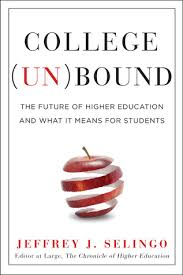
- Congratulations to Ms. Donna Martinez for winning the Women’s Day Award. Thank you, Donna, for showing other women the way to achieve at high levels and break barriers. Turning to issues impacting women generally, I am disappointed in the lack of activities we’ve planned for Women’s History Month. We should do more. It is my understanding that there really is no group or committee in charge of Women’s History Month celebrations on the HU campus and that probably explains our weak showing. Let’s get this organized. I am sponsoring a planning meeting/social at the University Residence on Monday, April 18 from 5:00 p.m. to 6:30 (or thereabouts). Anyone interested in planning activities for next year’s Women’s History Month is invited. Please RSVP to Caro. I have a few preliminary ideas—using the poster stands we recently acquired for the HU Reads Campaign to highlight the “Great Women of Highlands” (posters of HU women and a bit of their personal story, which would be prominently displayed around campus), maybe a daily email blast titled something like HU Her Story…brief essays from HU women past and present, a guest speaker, a modest film series, etc. I am sure others have more and better ideas. At any rate, let’s get together and get this planned. Light refreshments will be served at the event. At some point, I’d like to bring our students into the discussion. I am also inviting members of our chapter of the AAUW to this planning event.
Have a nice weekend, my colleagues.
Sam Minner,
President
Greetings colleagues. A brief update for the week of February 29-March 4.
- Congratulations to the HU Women’s Indoor Track and Field team for claiming a second consecutive RMAC Indoor Track and Field championship. HU edged out Chadron State at last Saturday’s meet. Ms. Salicia Slack took home Athlete of the Meet honors and Ms. Shanna Thomas was named RMAC Track Athlete of the Year. Coach Bob DeVries won RMAC Women’s Coach of the Year honors. The Cowboys baseball team had a very successful outing last weekend and our softball team split two games last Sunday. Also many good things happening in other spring sports. Two of our men basketball players, Mr. Marlon Johnson and Mr. Jonathon Mines, were named to the All-RMAC First Team. Well done to all of our student athletes. The Cowboys lost a close one in the first round of the RMAC shootout. The team had a great season with many exciting games. Well done to all. Our new AD, Mr. Bob Clifford, is also doing great things to boost revenue. Since February 18, we’ve sold $2,350 in ticket sales, $6,535 in concessions, and $1,900 in apparel for a total of $10,785. I am not sure if this is a record, but I do like the trend. Well done.
- Thanks to Sigma Xi for arranging a silent auction and a lecture by Ben Nelson focusing on his time backpacking in the Brooks Range in Alaska. Also, thanks to all who attended those events on Monday afternoon.
- Our Advancement Team sponsored another very nice reception and fundraiser on Tuesday evening. Joan and I were pleased to attend the event in Santa Fe where we met many friends and supporters of HU. Our total in the HIPs initiative continues to grow and I remain optimistic we will achieve our match. Another fundraiser was held on Thursday evening and once again, the event was well attended and upbeat. Our Advancement Office is on the move ant that bodes well for HU.
- We began the Tuesday leadership meeting with a discussion of one of the “Corner Office” pieces appearing each Sunday in the NYT. Here’s the link:http://www.nytimes.com/2016/02/07/business/walt-bettinger-of-charles-schwab-youve-got-to-open-up-to-move-up.html. It was a good discussion focusing mainly on what matters most in a given organization. The businessman interviewed in this article was talking about his college experience. He had earned all A’s…up to the class referenced below:
“And the professor said, “I’ve taught you everything I can teach you about business in the last 10 weeks, but the most important message, the most important question, is this: What’s the name of the lady who cleans this building? And that had a powerful impact. It was the only test I ever failed, and I got the B I deserved. Her name was Dottie, and I didn’t know Dottie. I’d seen her, but I’d never taken the time to ask her name. I’ve tried to know every Dottie I’ve worked with ever since. It was just a great reminder of what really matters in life, and that you should never lose sight of people who do the real work.”He also stated, “But one of the lessons I learned is that, in the transition from management to leadership, I had to open up. I had to be vulnerable. I had to share with people. In fact, it was more important than anything to share with people the great failures in my life as opposed to the successes. I draw a distinction between management and leadership. There’s a contractual relationship with your manager. And you can do your job and fulfill the terms of that contract and never really have your heart in it. But leadership is something completely different. With leadership, you make a decision every day about whether you choose to follow someone. And you make it in your heart, not your head. The ability to inspire followership is so different than management, and it requires transparency, authenticity, vulnerability and all things that are completely unnatural to you when you are trying to build and achieve and accomplish.”We talked about vulnerability, transparency, and other attributes that may (or may not) be “unnatural” when you are trying to get some hard and complex thing done. It was a good and sincere conversation, in my view. We went on to other matters including a policy regarding the use of our facilities. I and others get many requests from community groups to use our facilities and in many cases, these groups have few if any resources to pay the fees associated with the agreement. We had a good discussion about all this. My position—we are situated in a community with many economic challenges and in many cases, our facilities are the only viable option for some of these groups. We need to be good citizens and to the degree we can, we should work with community groups to help them as best we can. Now, of course, “helping” them means we sometimes incur real expenses…additional janitorial services, extra hours for the police, etc. So…what to do? A small group has been formed to look at all this and we’ll eventually wind up with some new policies. But, I do want the university community to know where I stand on this philosophically…let’s enter into these discussions with the goal to make things work, if possible, in some win-win way. If you care to provide me with some input about this, I welcome it. - On this date last year we yielded about 20% of all freshmen who completed applications. This year, our freshmen applications are up and if we achieve the same yield, we’ll increase our new first-time freshmen by 376. That would be a wonderful thing for HU. Let us hope.
- Joan and I will host the HU Full Professors at a social event at the University Residence today (5:00 p.m.). This is basically a follow-up to a meeting I had with the Fulls a few weeks ago. It was a productive meeting, from my perspective, and a follow-up session and perhaps a social function were discussed at the meeting. That social function will be this Friday. I recently had an opportunity to speak with several of my former colleagues (all Full Professors) at other schools and I briefly polled them on life as a Full Professor. Now I only spoke to three people, so keep that in mind. Three out of three of them said something to the effect that life as a Full Professor was wonderful—the best job in higher ed and the best job they had ever had. All three of them commented on the freedom they felt to pursue all kinds of interesting ideas and activities…freedom they did not necessarily feel when they were working on getting tenured and trying to establish their academic reputations. Like so many others, these three seemed to be so positive, in part, because they held such a forward-thinking perspective. They still were interested in what might be ahead and spent little or no time looking backward, particularly thinking about some problem they had encountered, some affront to their professional life, etc. We have all certainly experienced those and for whatever reasons, some cannot seem to move on. But others do and many of them work into their 60s or even 70s and embody an upbeat and positive attitude. One thing I have noticed is that so many senior professors (who seem happy, at least to me) tend to return to their early roots….teaching students, particularly students who face many challenges. There’s a lesson there, I’d say. I have to say, I left those conversations pretty optimistic.
Have a good weekend my colleagues.
Sam Minner,
President
Greetings colleagues. A brief update for the week Monday, February 22-Friday, February 26.
- The VPs and my other direct reports (plus a few more people) held a retreat on Monday and half of Tuesday. The goals of the retreat were to (1) further explore our various approaches to management and leadership in order to hopefully quickly establish a high functioning team, (2) to get to know each other a bit better in an environment away from the day-to-day pressures and decision making of work on campus, and (3) to devise some plans to move HU forward in the immediate future. Two consultants worked with our team. We explored a couple key questions: why do we do what we do? and why do we do it here…at HU? We agreed that the conversations at the retreat would be held in confidence so I cannot say all that much about the responses, but I will say that there was high congruence among the respondents in regard to both questions. We also completed an exercise that clarified the type of leader we embodied. We completed the FourSight instrument, which is a based on the work of Gerard Puccio. Dr. Puccio holds a Ph.D. in organizational psychology from the University of Manchester, England. We completed the FourSight instrument, which yielded scores for four domains—clarifier, ideator (which Brandon noted is not a real word), developer, and implementer. Basically, people who are clarifiers do not want to make any quick assumptions. They like to examine details and are methodical. The downside of clarifiers….they may talk things to death and never really get things done. Paralysis by analysis. Ideators have lots of ideas…some good and some bad. They think in more abstract terms. The downside for them—they sometimes miss important details and dive in too soon. Developers like devising workable solutions to problems and planning steps to get things done. For them the problem is sometimes getting stuck trying to develop the “perfect” solution, which is rarely possible in practice. Finally, implementers like to see things happen. They support the Nike slogan…Just Do It. However, they may act too quickly. I’ll let everyone guess where people fell. I should also note that we guessed which approach others embodied and those guesses were mostly correct. Our consultants also spent some confidential and individual time with several of the VPs and others. The idea there was to examine their leadership challenges, how they thought things were going in general, and anything else on their minds. I thought the time together was well spent. In my view, a great team almost always trumps a great individual leader, particularly in complex 2016 environments. So, what makes a great…a high-functioning…team? This has been carefully studied and the results might surprise you. Here’s a fascinating article about this topic: http://www.nytimes.com/2016/02/28/magazine/what-google-learned-from-its-quest-to-build-the-perfect-team.html?action=click&pgtype=Homepage&version=Moth-Visible&moduleDetail=inside-nyt-region-0&module=inside-nyt-region®ion=inside-nyt-region&WT.nav=inside-nyt-region&_r=0.
We also discussed the issue of promoting a friendlier and more efficient campus environment and what we might do to work on that. I have attended many of these types of meetings. Some I thought were a waste of time and some I thought were at least somewhat valuable. Personally, I thought this one was worthwhile. In my view, you are wither trying to improve yourself and function more effectively as a team or you are not. If you are not, things might improve over time as you get to know each other better and trust within the team improves, but again, in my experience, it mostly does not work that way. Things are too busy each work day and at the end of those days, people have little or no energy left for reflection or thinking deeply about how things are going on a macro level. My opinion only—reasonable people might disagree.
We arrived Monday morning, spent Monday evening, and half a day Tuesday at the facility at the Rio Mora Refuge. I built in enough time for people to tour the refuge and see the sites and most people did that. Many thanks to Dr. Joe Zebrowski for his kind assistance to make all this happen. Aviand’s should also be thanked for supplying meals to the group—the final approach to the facility at the Refuge is not for the weak of heart or, I should add, for any low ground clearance vehicle. The Aviand’s van got stuck several times, but they made it in the end. Many of you know the Refuge, but for those who do not, it is a fabulous local asset. It encompasses about 4,600 acres and was designated as a refuge in 2012. The U.S. Fish and Wildlife Service, NMHU, and the Denver Zoo are partners at the Refuge on a variety of activities. I should also note that the Pueblo Pojoaque owns and manages a herd of bison there.
A photo from the retreat and a second photo depicting a few examples of the resident herd of American bison: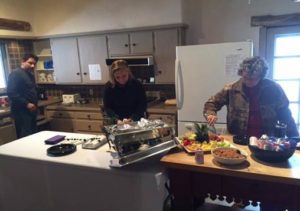
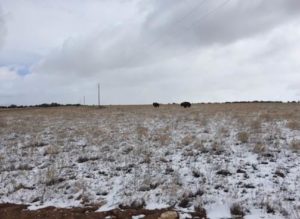
- On Wednesday, I toured our geology labs and other facilities. I appreciated the generous time my friendly guides, Dr. Jennifer Lindline and Dr. Mike Petronis, devoted to the tour. Clearly, these two colleagues, among other things, consistently go above and beyond to obtain equipment for their labs and I appreciate those efforts more than I can say. A nice story about their most recent victory: http://www.nmhu.edu/new-microscope-opens-research-opportunities-geology-students/. If other departments would like for me to tour their facilities, please contact Caro and she will set it up. I’d be pleased to do more of them.
- Last Friday and Saturday were the last home games for HU basketball. On Saturday, the women’s team notched a nice win and the men’s team also won against an excellent team. That win propelled the men’s team into the RMAC Shootout. Well done to the Cowboy team, Coach Snow, and his assistants. I should note that the men’s team was picked to finish toward the bottom of the heap this year and yet, Coach Snow and our team will compete in the shootout after a wonderful season with many exciting games. I am also pleased to note that our players conducted themselves well on and off the court and I am particularly happy with that. I also should note an important milestone for Coach Gadberry. She recently achieved her 100th win. Well done! I was also pleased to host East and West on Monday evening for their playoff game. The teams required a “neutral” site to play the game and our arena was the obvious choice. I welcomed the fans to HU and watched a bit of the game before driving back to the Mora Refuge for the remainder of the retreat. As was I leaving the complex, numerous local citizens thanked HU for allowing their teams and fans to use our facilities. HU is a big part of Vegas and Vegas plays a large role in HU’s success. I understand that. I respect that. And, I seek to build upon that special relationship in ways that are “win-win” for both parties.
- On Thursday we held a meeting focusing on branding and marketing. Many thanks to Sean Weaver who is leading this effort and did a nice job at the meeting. I am mindful of the pretty tight timeline I established to get this done, but I also feel it is imperative that we move as quickly as possible to move our enrollment forward. Thanks to all who took the time to attend this meeting.
- HU Day will be held this Saturday, February 27. This is an event for future HU students and their parents and is designed to be a true “one-stop shop” for prospective students. Students can get admitted, get answers to financial aid questions, and do everything necessary to start at HU in the fall term. Here’s one of Margaret McKinney’s articles about this event:http://www.nmhu.edu/hu-day-high-school-seniors-feb-27/. I should also note that our mighty Vatos play this Saturday—2:00 p.m.
- The Board of Regents meeting is today and I’ll provide a follow-up after the meeting noting what happened, what actions were taken, etc.
Have a nice weekend my colleagues.
Sam Minner, President
Greetings colleagues. A brief update for the week of February 14-20:
- The HU women’s basketball team lost a couple tough games last weekend and the men split an important series. Two important games will be played this weekend. The women’s track team had a great outing and took second at the NAU Invitational. Our team is now ranked #7 in the nation. Several of our individual track and field athletes did very well at Flagstaff. The baseball team lost over the weekend, but showed much grit and perseverance. I should also note that Secretary of Higher Education Barbara Damron will attend the basketball game on Saturday. Finally, the mighty HU Vatos beat Albuquerque last weekend. Final score = 38-22. Our Vatos are coached by our own Dick Greene who would give anyone the shirt—or sweatshirt—off his back to support these warriors. I can attest to that assertion since I am now the proud owner of a Vatos sweatshirt donated to me by Coach Greene. He quite literally took the sweatshirt off and gave it to me. I proudly wear it often—after a thorough washing of course.
- On Saturday, I met with the Student Senate and discussed the possibility of a new student fee to fund a major campus life initiative at HU. I assured the student senators that I would not take the proposal to the board unless there was clear and strong student support of the proposal. Even if that is the case, the board will have to approve this. If this moves forward, we’ll collect a new student fee to fund a major push to enhance campus life. The fee will support three things. First, we’ll establish a new space on campus—tentatively called the HU Office of Outdoor Recreation—where students can check out outdoor equipment and learn or improve outdoor skills (e.g., fly fishing, camping, etc.). The office will also organize a variety of excursions (skiing, hikes, etc.). The basic idea is to capitalize on our incredible location and engage existing students in healthy and fun outdoor activities. Second, we’d implement a major expansion of on and near campus social activities (e.g., dances, bands, etc.). Ideally, I’d like something of note happening every week. Maybe two or more activities per week. And finally, the fee will support what I am tentatively calling the HU Lyceum—an annual three or four part performance series, probably at the Ilfeld. It would be great to have more symphonies on campus, maybe some dance troupes, and other top-end performances. I’d love to have an opera every two-three years, maybe a ballet every two years or so, maybe an annual performance of Nutcracker every Christmas, more performances celebrating the cultural heritage of Northern New Mexico, etc. I indicated to the Student Senate that I (or someone) would provide an accounting of revenue and expenses each year and also told them that there would be more students deciding on the specific acts than HU personnel. That is to say, students would lead this initiative. We’ll see what the Student Senate and the board decide to do on this, but if the concept moves forward it will complete three major things I wanted to accomplish this year (i.e., a reengineering of advancement in hopes of adding new streams of revenue to HU, a reengineering of recruitment in hopes of achieving the 4500 headcount number by 2019, and a major enhancement of campus life (hopefully) leading to an even more positive campus experience for existing students and possibly driving new students to us.
- On Tuesday, I was briefed on our wonderful AmeriCorps program—clearly one of the best things we do here. I urge you to talk with Ms. Lauren Addario or any of our Media Arts faculty to learn more about this program and the incredible opportunities provided to our students. AmeriCorps students complete a meaningful internship, which in many cases, leads to a good job. This slide says it all:
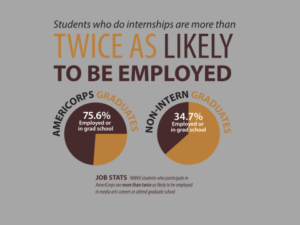
- Fall 16 admitted numbers continue to look good. This time last year, 1003 students were admitted to Highlands. Today, 1674 students are admitted—an increase of 671 students. This time last year, 2,363 students had been admitted or had at least started the admissions process. Today, that number is 3288—an increase of 925. These are healthy increases, but they do not matter one iota unless we can get those students here in the fall and registered for classes. At this point in the year, it is all about yield. Interim VPSEM Martinez is working hard to improve yield by designing new ways to more frequently and powerfully connect with admitted students and those who started an HU application, but did not finish it. If asked, I request that you assist him in any way you can. In my view, it is one of the most important things we do here.
- My board membership on the Main Street de Las Vegas organization continues to be a gratifying and, I think, important, thing to do. We had another board meeting on Wednesday evening. HU is well represented on the board…I am on it as is Bill Taylor. Clearly, the future of Las Vegas is very much dependent on what does or does not happen at HU. One key to growth in Las Vegas is simply—more students at HU. Students want a variety of places to dine, to socialize, and to shop. Let’s get them here for our sake and to benefit our city.
- On Thursday, I greeted a group of middle school and high school students to our campus. These students were all participants in the New Mexico Mathematics, Engineering, Science Achievement, Inc. (MESA) program. Kids from schools throughout the region built a prototype mechanical arm and the devices were brought to HU for a competition. It was a great event and so nice to see so many young women on the teams. A photo from the event as students were filing in:
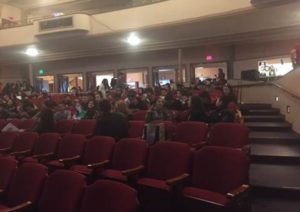
Have a nice weekend my colleagues.
Sam Minner, President
Greeting members of the board. An update for the week of February 8-12.
- The women’s basketball team lost some tough games this weekend and the men split their contests. The baseball team played well, but came up a little short. However, they got a nice win later in the week in a great game with lots of offense. Only a few weeks left in basketball and some tough teams on the schedule. Let’s get behind our teams and have a strong finish.
- The Leadership Team met on Tuesday, as usual, and we started with a discussion of “customer service” as it applied (or did not) to higher education. We read these two pieces:http://www.academicimpressions.com/news/diagnosing-barriers-improving-customer-service and https://www.insidehighered.com/views/2008/03/13/diacon . It was an interesting discussion. I think everyone agreed that there is or should be a distinction between treating students like customers in classes and other academic activities as opposed to treating them like customers in navigating the process of going to school. In the former case, students are not customers. That is, we as their teachers should not—and frankly I would say do not—modify our behavior in some way because the student might not like it or choose to be a “returning customer.” In the academic domain, we seek to maintain high standards and expectations. If a student doesn’t “like” what we do (e.g., assigning readings, making assignments that require high effort, etc.) …well, so be it. But, when it comes to help navigating the process of higher education—getting something signed, dealing with some form or process, etc.—the group generally suggested that students were like customers, at least to some degree, and should be treated well (e.g., greeted when they entered an office, decent response time when they call or email someone, not required to go to office after office after office to get some simple thing done, etc….what one of the responses to the reading referred to as a “humane bureaucracy”…a bureaucracy no doubt, but one as humane as possible). We then discussed how we thought things stood at HU. I said that I had personally seen no examples of “treating students like a customer” in the academic realm. That is, standards were not lowered because a student did not “like” the level of challenge. Maybe that happens, but I’ve not seen it. However, most people around the table could easily share at least some examples of not treating students like customers in the other domain. Students are sometimes asked to go to one office after another to get something done. Phones are sometimes not answered, even during normal business hours. Email queries sometimes take a long time to receive and sometimes go unanswered altogether. We talked a bit about why this might be and settled on at least four possibilities. First, in some cases, we might not have enough human resources taking care of the volume of student traffic. Second, the processes we use might be overly cumbersome (too many people required to unnecessarily touch some piece of paper a student is carrying around) and or a reliance on old—maybe even antiquated—processes that could be streamlined perhaps using technology. Third, a possible lack of feedback to people about their treatment of students. Someone asserted that this type of feedback is rarely if ever included in employee reviews and finally, not enough emphasis on service embodied throughout the culture. That is, too few people talk about this and too few (if anyone) really emphasizes it on campus. I said we’d revisit this and propose some actions to improve our service orientation. I think it is a serious issue. The remainder of the meeting was devoted to reports from the various divisions, a discussion about our possible participation in the “Best Campuses To Work For” survey, an update from the legislative session in Santa Fe, and a brief update on the branding and marketing campaign, which we will begin soon. By way of reminder, we’ll have a forum on the process we’ll use to brand and market HU and then we’ll commence the process. Mr. Sean Weaver will lead us in this effort guided by several faculty and staff members. I understand that the group is now reading a book focusing on the branding and marketing process. Here’s the cover:

Here’s a link to the book: http://threeandatree.com/. I should also note that Ms. Elizabeth Ratzlaff joined us at the meeting (and will be attending on a regular basis) as the new President of the Staff Senate. I know her participation at these meetings will be very valuable and provide important insights to all.
- On Wednesday, I attended the San Miguel County Economic Development Leadership Collaborative (SMCEDLC). I am a member of this group. Basically, the SMCEDLC is proposing that the citizens of San Miguel County speak, to the degree possible, with one voice when seeking funding from elected officials, foundations, etc. As it stands now, individuals from different agencies seek funding for their ideas and in most cases, those projects are not really vetted to determine their relative merit compared to other possible projects. Could we do better? Leaders in several areas (e.g., education, agriculture, tourism, etc.) were identified (I am the leader in the education domain) and each was asked to present some project. In the end, one or more critical projects will be identified for San Miguel County and then we’ll seek funding. I recently met with representatives from Luna and the two school districts in town. We are working on a project tentatively called The Las Vegas Career Pipeline Program (LV-CPP). Three career areas have been identified—technology, health, and entrepreneurial activities. If we receive funding, we’ll identify about 50 high school kids interested in each area. During the regular academic year these kids would be exposed to a variety of activities…lectures, hands-on activities, etc.—increasing their knowledge, skills, and motivation to pursue that career track in post-secondary education. For example, the students in the technology track might complete a weekend coding camp, get some hands-on experience with drones, hear from professionals working in the technology sector, etc. During the summer, the students might participate in longer-term programs…again, directly related to whatever career sector they are in. As the kids get closer to graduating from high school, we’d work closely with them and their parents to seamlessly get them enrolled at a program at Luna or here at Highlands. The students would receive continued support and mentoring while in college and hopefully, they would graduate…on time…with a certificate or a degree and get a good job—maybe even start a business—in the region. The concept is to engineer a “pipeline” of local students to get the skills and knowledge they need to get a good job and ideally, add to the local economy. At any rate, my presentation to the SMCEDLC went well. Presentations from other groups (e.g., healthcare, agriculture, etc.) will soon follow.
- Joan and I (and our granddaughter, Mabel) attended the HU Alumni “Love” event on Thursday evening. There was a silent auction and numerous other Valentine’s activities. The event was very nice—all tables were filled, excellent music and food, and an atmosphere consistent with a Valentine’s vibe. The personnel in Advancement are doing wonderful things in the alumni area…many new high-energy events designed to engage our many alums and friends. The event last night was also a fundraiser for the HIPs campaign and I understand we raised several thousand dollars toward that initiative. A photo of me, Joan, and Mabel—our granddaughter visiting from Maine—who probably had more fun at the event than anyone. She won three cakes and carefully monitored the silent auction items she desired. Her mom told her that she could not ask me or Joan to buy her anything, but as she put it…she bid on the items, which is not the same as asking. That is true. To be seven is to know joy.
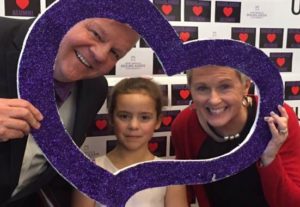
- A busy day Friday…meeting on-campus with the Viles Foundation, lunch with Senator Udall, a meeting to start the plan for commencement, and a reception for Bob Clifford, Theresa Law, and Edward Martinez in the afternoon.
Have a nice weekend. Thank you for your high commitment to HU.
Sam Minner, President
Greetings colleagues. A brief update for the week of February 1-5.
- Last Saturday, Joan and I attended a breakfast at Coach Mills’ home where we welcomed some new football recruits and worked hard to convince a few others to become Cowboys. Our new AD also attended as did the Director of Career Services who spoke of the value of an HU degree and the very positive career outcomes of our graduates. Recruits and their families came from New Mexico, Texas, Washington, California, and other states. It was a nice event. Coach Mills and his staff are doing great things in our football program. A photo from the event:
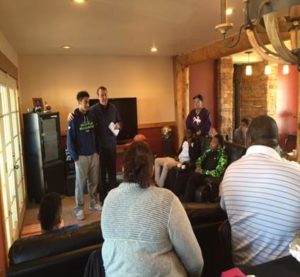
- This term, the Big Ideas Reading group will read College Unbound by Jeffrey Selingo. The book, published a few years ago in 2013, offers a critique of contemporary higher education and focuses mainly on the debt so many students acquire. Like the real-estate bubble a few years back, Selingo believes that the “higher education bubble” will also soon burst. According to Selingo, most families will simply be unable to bear the debt of a four year degree—even at relatively low-cost regional institutions like Highlands. The author is not pessimistic about the future, however. He feels that universities must change and mostly will. How? More personalized learning mainly utilizing technology to make learning more efficient. Even more online options. Tighter connections between the college experience and work requirements. I’ve ordered 18 copies of the book. Some faculty are on the waiting list from last semester’s reading group, so we’ll wind up with slots for about 7-8 people. Please look for a call for participants. Like last term, we’ll gather at the University Residence to discuss the book and share some refreshments. Date TBD. Here’s several reviews from Amazon: http://www.amazon.com/dp/0544027078/?tag=mh0b-20&hvadid=4164373587&hvqmt=e&hvbmt=be&hvdev=c&ref=pd_sl_8pxg9h6b3s_e.
- I took a brief tour of the Trolley Building on Monday. It looks great. We are on budget and things are progressing nicely. Truly, this will be a showpiece for Highlands and will be an incredible space for learning and teaching. A photo of the interior on February 1, 2016. Much work done…still more to do. I approved numerous purchase orders this week for the new furniture we’ll install in the Trolley Building.
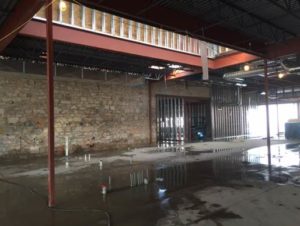
- We started this week’s Leadership Team with a discussion of The Value Equation: Measuring & Communicating the Return on Investment of a College Degree. This paper is from The Chronicle of Higher Education with sponsorship from Pearson. Here it is: http://images.results.chronicle.com/Web/TheChronicleofHigherEducation/%7B582dbe25-8c5a-4e12-a555-e4cda919df52%7D_Student_Outcomes_Report_v7_LOWRES.pdf. The report asserts that, among other things, most colleges and universities are opposed to publishing their career and salary outcomes, there is a “disconnect” between parents and employers who want students to graduate from college with very specific job skills and many who work in colleges more interested in broader outcomes such as critical thinking, and a variety of findings related to the most important skills necessary for graduates to succeed in a job. The conclusion of this report:
“Ever since the recession of 2008, colleges have been under pressure from students, parents, and lawmakers to better prove their value in the face of increasing tuition prices. College leaders, however, have been pushing back against such efforts under the belief that a college degree serves
multiple purposes and, as a whole, its value can’t be measured easily. They largely oppose efforts to measure the career earnings and job outcomes of their graduates, and particularly dislike government efforts to mandate such measures. The results of The Chronicle survey demonstrate that college officials still believe in the value of a college degree despite its high price. Even as employers complain about college graduates who come to them unprepared for the job market, college leaders say their job is not to train students for a specific job, but to provide them the foundational education that’s needed to succeed in a fast-changing economy. Even so, the survey shows that colleges have been investing more money to expand the offerings of their career services, but are struggling under the pressure of tight budgets and sometimes apathetic students to provide the full range of programs that they desire. It’s in programs related to career services, however, that campus leaders could continue to focus their efforts and investments if they want to improve the employment outcomes of their graduates in the coming years and, ultimately, the value of their degree.”
The meeting continued and we had a full agenda including final endorsement of a proposed alcohol policy (this will now be considered by the faculty and ultimately sent to the board), some personnel updates, reports from the various Divisions, some additional information about the upcoming retreat, and a presentation by Sean Weaver on the branding and marketing initiative. There will be campus wide meeting to discuss the branding and marketing initiative and I’ll send out the date and location of that meeting as soon as it is set.
- Ms. Salcia Slack was named the RMAC Women’s Indoor Field Athlete of the Week. Her performance in the triple jump is the best mark of the season thus far in Division II—the top performance inall of Division II. If you see Salcia, please congratulate her on this wonderful accomplishment! I should also note that the Highlands Women’s Indoor Track and Field Team is now ranked # 13 in the nation. When you see these student-athletes or Coach DeVries, congratulate them on a job well done. The RMAC is well represented in the top 25 DII national rankings. Along with Highlands at #13, CSU-Pueblo is ranked #17, Chadron State is #24, and Adams State is #25.
- I am working with representatives from United World College to organize a “Focus On Dance” event. On April 14, we’ll screen a wonderful film, Desert Dancer. This film is based on a true story of individuals who defied a ban on dance in modern Iran. On the 15th, a guest artist, danah bella, will conduct two master classes for students and individuals from the community. On the 16th, UWC students will be in the Ilfeld for a dance performance. And we are working on having some local dance troupes perform on Sunday the 17th. I hope we can secure a local Baile Folklorico group, a flamenco group, and a ballet troupe. Maybe others. All events are free. More on this later.
- On Tuesday evening, Max and I had dinner with members of the House Finance Committee. I have said this many times—we have many friends in the Roundhouse. A photo from the event—far left: President of Northern, far right: President of Western, standing: President of Tech Dan Lopez and the Chair of the Finance Committee.
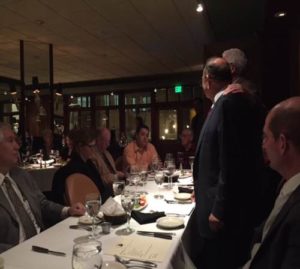
Another dinner was held on Wednesday evening—this with the Senate Finance Committee. Once again, Max and I represented Highlands. Photo from the event depicting Dr. Dan Lopez and Secretary Barbara Damron: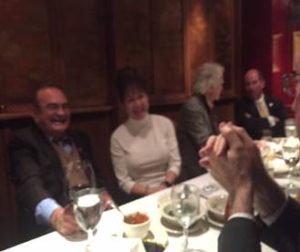
- On Wednesday afternoon, I met with LV education leaders—Superintendent Ruben Cordova, Superintendent Gene Parson, and VP Vidal Martinez—to discuss possible partnerships and collaborations. This meeting was prompted by a report developed by the EDC titled San Miguel County Economic Development Leadership Collaborative: 2014-2019. The basic idea here is for various entities in our region to identify projects we need, prioritize them, and then work as a team to seek funding to get them done. People believe that we’ll be more likely to secure funding if we present a more unified approach rather than individual entities lobbying for their individual projects. That makes sense to me. I volunteered to lead a discussion in the education domain. The four of us talked about a variety of projects including one we called The Las Vegas Career Pipeline Program: LV-CPP. The basic idea here is to identify local students and promote their interest in specific career vectors leading to good jobs and hopefully, broader economic development throughout the region. We identified three broad career sectors: (1) technology,(2) health and allied health, and (3) entrepreneurial ventures. If we move forward on this and can secure the funding, we’ll identify local/regional students interested in one of these areas and work with them over time to increase their knowledge and skills and then, hopefully…get them enrolled at Luna or Highlands. As noted in the title of the program…we are trying to build a pipeline of students from the local community and or region who go into these disciplines, graduate with a certificate, 2 year degree, or four year degree and go on to good jobs…ideally in this region. It was a very productive meeting with many good ideas shared and debated. The next step is to refine the concept and share it with the Leadership Collaborative.
- I did a radio interview on Thursday morning. I discussed my first six-months on the job here, what I thought might be before HU, and other issues including funding. It was a good interview and a positive experience. I’m not sure if it was recorded for podcast, but I’ll find out and let everyone know in the event you want to listen.
- Joan and I attended a very nice alumni event on Thursday evening. Juli Salmon and our new VP for Advancement, Theresa Law, are doing great things to connect with alums and design engaging alumni events. We had nice attendance at the Albuquerque Country Club including members of the Board of Regents, individuals from the Foundation Board, and many alums and friends. Several faculty members and their students spoke at the event including Dr. Carol Linder, Ms. Lauren Addario, Dr. Jennifer Lindline, and Dr. Edward Martinez. We raised some additional funds for the HIPs Foundation project. A photo from the event in Albuquerque:
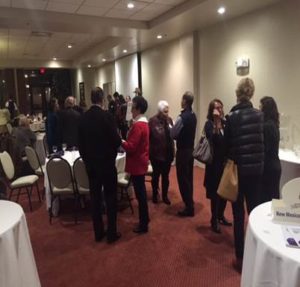
A $10,000 check we received last night to support the HIPs initiative: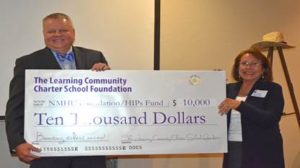
- On Friday, the Campus Climate Committee met—our second meeting. I gave everyone a copy of the book we are reading, The Best Place To Work; The Art and Science of Creating an Extraordinary Workplace by Dr. Ron Friedman. Here’s a link to the book: http://chroniclegreatcolleges.com/. We made a few decisions—-someone from our committee will check with the staff and faculty senates to ascertain if those bodies have any concerns with us proceeding with the 2016 Best Place To Work survey. We need to make this decision soon. We also decided to query the campus community about the campus delay/closure policy. Some members thought it might need attention, so we’ll get a read from the campus on that. We also talked about how the committee might move forward. More on that later.
- After a national search attracting many qualified applicants, we recently hired a new Education Dean, Dr. Lora Bailey and she is now on campus. Dr. Bailey comes to us from Indiana. She has a strong record of faculty and administrative accomplishments and I am confident she will do many great things here. Look for a notice of a campus reception for Dr. Bailey where all can meet and welcome her. This week I received a letter of resignation from Dr. Fidel Trujillo. Fidel has done many wonderful things on the HU campus and I know we all wish him well in whatever is before him. I have asked Ms. Kim Blea to assume the Dean of Students duties on an interim basis, which will allow me some time to reflect on possible changes in the unit prior to initiating a national search. I have high confidence in Kim and I know everyone will support her in this new role.
- On Friday, I met with the Full Professors on our campus. I made a few comments about contemporary events—the budget, accreditation, some personnel issues, and others—and we then had a good conversation about a variety of topics. I have served as a Full Professor (with tenure) at several schools and in my experience, it is very rare for the Full Professors to come together as a group. On some campuses, it never happens at all. I was told that the Full Professors getting together today was perhaps a Highlands first. That was certainly not the case in early universities and I do not think it is wise today. Full Professors have achieved at high levels (or they would not have been promoted to that rank) and they embody much institutional, disciplinary, and professional wisdom. Often, they have the deepest commitments to the institution by virtue of their long-term professional investments there. I sometimes got the message as a Full Professor that I was intractable, set in my ways, and somehow “blocking” innovation and or that my best days were behind me and I was taking up a valuable spot for a new assistant professor. A Full Professor in the audience echoed these sentiments. I suppose that might be true in some cases, but frankly, I never thought it was true in my case nor among the vast majority of my full rank colleagues. Indeed, as a tenured Full Professor I felt more free than ever to try new things, experiment with different teaching approaches, and follow-my-nose in regard to scholarly activities. As a Full Professor, I was not so darned focused on establishing my career, earning tenure and promotion, etc. It was liberating really. The best senior professors I’ve known remain vibrant throughout their careers and are often at the very tip of innovations and new thinking. They often also play a key role in mentoring new folks. Such colleagues have been inspirational and aspirational in regard to my own career. I imagine we’ve all known some senior colleagues who are bitter (I wasn’t given that chair’s job in 1977!), cynical (We tried that years ago…it will never work), and just kind of downers to be around and then there are the others—senior colleagues who remain active, interested and interesting, and great role models. I certainly know which type I want to embody if I return to a faculty role at the end of my career. We talked about how we might more powerfully engage Full Professors on our campus. The group would like to meet on some regular basis and I agreed to do that. Plus, the group will be invited to the University Residence for a social function in the near future. Date TBD. Overall, it was an interesting meeting, from my perspective, with many opinions and perspectives shared. The task will be to turn at least some of these ideas and challenges into actions that result in improved outcomes.
- The men’s and women’s basketball teams are back in town this Friday and Saturday and I hope to see some of you at the games. Our new AD, Bob Clifford, is working hard to improve school spirit at our home games. Let’s cheer the Cowgirls and Cowboys on to some additional RMAC victories. I think we are competing with an East-West game on Friday and I understand that is always a popular local event. AD Clifford also informed me that we had a great recruiting day on Wednesday with many excellent student-athletes committing to Highlands, particularly in soccer and football. I believe we signed 12 women soccer players and 18 football recruits.
- At this point, our Fall, 2016 numbers remain strong. This same time last year, 824 students were admitted to HU and today, 1488 have been admitted. Last year, we had 2164 completed and initiated (but not completed) applications. Today, that number is 3213. Most all of this increase is from new freshmen. We’re basically flat in the transfer, international, and non-degree areas. The major task for us now is to increase our yield from the number of admitted students. There are better and worse ways to do that, of course, but merely reaching out to them, encouraging them, and making it as easy as possible for them to enroll in classes and show up in the fall can improve the yield. Interim VP Edward Martinez is working on a strategy to do just that. If you have ideas, I encourage you to speak with him.
- I recently received a request from Professor Emerita Sara Harris to help sponsor this year’s Fiesta de la Hispanidad. I understand this is a wonderful campus-community event and I thank Professor Harris for devoting her time to making it a success. I am pleased to help with this and I encourage the faculty and staff to attend. It will occur on Friday, April 8 in Ilfeld.
- This spring term, Joan and I will once again host students at the University Residence for small dinner parties allowing for some good conversation and some recommendations about HU can get even better. I benefitted a great deal from the dinners we hosted last term. This time around, we’ll be hosting students from the Centers.
- Finally, on Saturday I will greet some students on our campus from Amigos de las Americas. The Amigos group is a well-known non-profit providing great opportunities for students to experience a powerful cultural and language immersion. This group of students is being prepared to visit Central America. Later on Saturday, I will make a few remarks about the future of HU at an event sponsored by the American Association of University Women (AAUW). I will be joined by several other education leaders in the area. This event will commence at 2:00 p.m. at Charlie’s.
Have a nice weekend, my colleagues.
Sam Minner,
President
Greetings Colleagues. A brief update for the week of January 25-29:
- The men’s and women’s basketball teams both had big wins last Friday evening only to experience tough losses the following night against very good teams. The men continue to share first place in the RMAC. Some big games are coming up this evening and Saturday.
- At this week’s Executive Leadership Team meeting, we opened with a discussion of the concept of “executive presence”—the important but nebulous idea that many (maybe most) great leaders have some presence about them—some aura—that makes people want to follow them. We explored the question—why would anyone want to be led by you? Here’s the article:http://www.huffingtonpost.com/greg-j-stone/what-is-executive-presenc_b_7307648.html. It was an interesting discussion. People provided examples of leaders who they felt had a strong leadership “presence” and how that helped them achieve things. There was also some discussion of leaders who had low or weak presence and yet, still got things done. So—leadership presence in and of itself was not necessary, but I felt most thought it was very helpful. One member of our group suggested that leadership presence was mostly about the ideas—the values—one held and less about one’s deportment, appearance, how articulate they are, etc. Other routine matters were discussed—personnel, some budget issues, and planning for our retreat at the Mora Refuge.
- We had some snow this week and I thought I’d review our process for announcing a delay or a closure. Basically, our process is for an individual from General Maintenance to check the snowfall (on campus) at 5:00 a.m. If there are four or more inches, the Facilities Director calls me at home and I decide no later than 6:00 a.m. if we go to a two-hour delay, close altogether, or remain open. I consider other variables of course—I do not rely only on the amount of snow at 5:00 a.m. Other relevant factors include the forecast (is the snow likely to continue?), extreme wind and or temperature conditions, and others. I first consider the safety of all employees and students, but also try to remain open if it is safe to do so. I think this process is sound, but of course, at the end of the day it is still a judgment. One relevant factors is that we can have a few inches of snow on campus and a few miles away, it can be a very different story. For example, on Tuesday, I had maybe two inches of powdery snow at the University Residence. Here’s a photo from Mora with a bit more than 2 inches on the ground…more like two feet or more. Put on a hat and gloves Edward….

- Max and I (and others) were in Santa Fe on Tuesday, Wednesday, and Thursday this week. On Tuesday, we attended the Higher Ed. Senate Finance Committee hearing. As I have previously reported, the Council of Presidents, as a group, advocated to (1) not modify the higher education funding formula in any significant way, (2) provide resources for compensation increases on our campuses, and (3) provide some new (one time) money for technology enhancements. Members of the committee indicated that few, if any, new dollars were likely in this year’s budget, mainly due to falling prices in gas and oil. Committee members suggested that it was even possible to have a cut. On Wednesday, I appeared before the House Committee. The situation was very similar—the revenue forecast was down and there was limited hope for any significant improvements before the budget had to be set. The presidents spoke with one voice—maintain the current funding formula and if there is any new money, compensation is our #1 priority. On Thursday I attended the Governor’s annual prayer breakfast and then had a full day in the Roundhouse to celebrate Las Vegas Day. Our students and many faculty and staff were in attendance and HU made a great impression on everyone. That evening, there was a Las Vegas reception at the Eldorado Hotel and Joan and I greeted many friends and alums at the event. A photo of the Senate chambers immediately before Senator Campos introduced the proclamation celebrating Las Vegas Day:
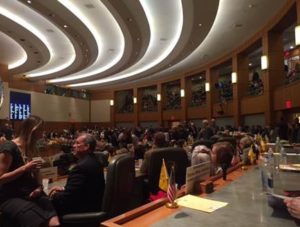
- Joan and I were able to attend the fundraiser for Daniel Torres on Tuesday evening. Daniel is a gifted musician, a Highlands grad, and is destined for a great musical career, no doubt.
- On Saturday morning, Joan and I will attend a breakfast at Coach Mills’ home to meet several football recruits. Coach Mills has been a real road warrior lately cirss-crossing the state and region recruiting prospective student athletes for HU football. He and I are in accord—we want good students who will graduate from HU on-time, will consistently represent HU in the best possible light, and will bring home victories.
Have a good weekend, my colleagues.
Sam Minner, President
Greetings Colleagues,
An update for the week of January 18-January 22:
- I spent half of last week at the national NCAA meeting in San Antonio. There were a few interesting issues, but really nothing that directly impacts the RMAC or our program. We devoted some time to a few issues—minors as bat boys (came up due to a serious injury last year…not at HU), archiving webcasts, and some scheduling issues. I will say that our conference—the RMAC—is well respected in the NCAA. Our Commissioner is respected there and I have high faith in his ability to effectively lead and manage the conference. We are on sound financial footing and there is some interest in other schools coming into the conference. The conference also looks good in regard to six-year graduation rates. Thirty-seven percent of all students in the RMAC graduate in six years. Among RMAC athletes, the rate is 49%. That’s a significant edge for student athletes. HU is also doing well in regard to viewers tuning in Stretch Internet. In 2015, 6,769 people watched a streamed HU game—one of the highest rates of viewership among RMAC schools.
- I hope everyone took an opportunity to reflect on Dr. King’s legacy and possibly participated in some volunteer event to honor him and what he stood for. Joan and I participated in an MLK program in Santa Fe, which was very moving and helped me reflect on Dr. King’s role in our nation and the world.
- Enrollment: Our Spring 2014 to Spring 2015 enrollment numbers are in. We are up a few students this spring mostly due to some enrollment increases at the Centers. Our fall 2015 to Fall 2016 admitted numbers are also in and those show a nice increase in admitted students—up more than 1000. Now, of course, that’s admitted students and does not mean they will actually enroll and show up this coming fall. The immediate task is improve our yield—transform those admitted students to enrolled students this fall.
- The Cowboys played two great games last Friday and Saturday. I was out of town (the NCAA meeting), but was able to watch the games via Stretch Internet (our streaming provider). At present, the Cowboys are alone at the top of the RMAC and there was much discussion of this at the recent NCAA meeting. I think we were picked to finish 10th in the conference. Coach Snow and the team are doing great things. The Cowgirls continue to show promise in what is a building year. I am confident that good things are ahead for them. I should also note that a guard on the men’s team, Jonathon Mines, was recently named to the 2015-2016 First Team All-Academic roster. Mr. Mines has a GPA of 3.46.
- VP Baca and I spent most of Tuesday in Santa Fe. Tuesday was the opening day of the short legislative session. We visited with numerous elected officials and other friends of Highlands (and there were many) and I attended the State of the State address delivered by the Governor. I was honored to be introduced to the joint senate/representative body and afterward, many other folks introduced themselves to me and told me about their personal connection to HU. As I wrote, we have many friends and supporters in the legislature and Max was able to introduce me to many of them. He is well known at the Roundhouse and has many key connections of benefit to HU. This is shaping up as a difficult legislative session for many reasons—mainly falling gas and oil prices. As you know, the New Mexico state budget is directly tied to gas and oil and when prices are down (which they are), that bodes poorly for the state budget. A photo from this year’s joint opening session:

- At this week’s Executive Leadership Team meeting we began the meeting by focusing on an article in a recent Chronicle of Higher Ed. The piece was titled Loyalty, Schmoyalty and was authored by James Dixon. That is a pseudonym of a humanities professor at some school in the South. In this article (here’s the link: http://chronicle.com/article/Loyalty-Schmoyalty/234609), Dixon wrote about how he could care less about the school that pays him every two weeks and asserted that he did not, “…believe in his college the same way anymore” and that for many years what he used to feel for his college could accurately be described as love, until he realized that the college did not love him back. The guy claimed he was not at all bitter, but I must say it did not read that way to me. Something had happened to this guy…I gather that is was something to do with colleagues being mean to him in some way…and man….that clearly changed him and made him what he is today. There have always been interesting and sometimes heated issues regarding loyalty in the academy. Maybe the term “loyalty” is the problem here. Can or should a person be loyal to an institution? Does that even make sense? Aren’t people loyal (or not) to other people and of course in any institutions, the roster of people working there changes all the time. If we are talking about faculty, there is almost always a tension between affinity to the institution and to the person’s discipline and larger national or even international professional community. Some faculty do not really see themselves as a faculty member working at X (a given school), but as a physicist, or a historian, or a whatever who happens to work at a given school at a point in time. I have known people like that. Quite a few of them really. Then again, I have known many who have truly deep and even profound affinity for the university employing them. What makes some of our colleagues unconcerned about institutional loyalty (or even opposed to it) while in the case of others, institutional identity and affiliation is a huge thing? Is it something people at an institution do or not do that makes the difference or is it mainly dispositional…that is, some people are just bent that way? We talked about this quite a bit. I think most agreed that institutions were neither loyal or disloyal, but some people working at institutions made a person fee valued…and some, of course, did not. I thought of an argument I heard once…and was made in the comments section following the article we read…that faculty members were…kind of…on a “team”, but only “kind of” and like baseball players, their individual performance was also carefully scrutinized by others and high performers could become free agents and join other teams at improved salaries, if that was their wish. I’m not sure that analogy is all that great, but I have heard in frequently in regard to members of the academy. We also focused a bit on the “the institution does not love me back so I just don’t care” argument. I think we had all heard that at one time or another and maybe made that argument ourselves. Several folks around the table agreed that important professional standards were to try hard and do one’s best not in hopes that your colleagues and administrators will show you the love (thought that is very nice when it happens), but because it is part of being a professional and acting with integrity. It was a rich conversation, from my perspective, and helped me think all this through more deeply. We went to our other agenda items—some personnel items, issues associated with some physical moves, HLC issues, and a proposed campus alcohol policy. I will be seeking the endorsement of the Executive Team, the staff senate, the faculty senate, and the student senate and afterward, I’ll make a recommendation to the board in regard to that policy. We also discussed the branding and marketing initiative. There will soon be a meeting scheduled to discuss this and get some feedback and recommendations for the path forward.
- In a modest effort to make our campus more inviting and receptive to the needs of everyone, we are installing a small lactation room on campus. This space will afford individuals the opportunity to more personally care for infants in a private and comfortable environment. The space is being installed now and will soon be available to interested students, staff, and faculty. Also relative to facilities, Sylvia, Max, and I met this week to review the existing Campus Master Plan and to make adjustments. I do plan on making some adjustments, but the top three priorities—-Rodgers, Facilities (moving it away from the Trolley Building), and infrastructure improvements are not likely to change.
- Joan and I attended the free screening of Sicario Wednesday evening in the Ilfeld. It was a cold and snowy evening, but a substantial crowd of university folks and individuals from the local community were in attendance.
- The first Campus Climate Committee meeting was held on Thursday. Numerous staff members and members of the faculty are on the committee. The names of these individuals were provided to me by the Faculty and Staff Senates. Not everyone could attend our first meeting due to other obligations, but I’ll try to find the optimal time/date to get everyone there in the future. Professor Edward Harrington volunteered to serve as our chair. I’ll make sure those not in attendance are comfortable moving ahead with Professor Harrington before we proceed. I really appreciate his willingness to serve in this capacity. A couple decisions were made—those in attendance felt that HU should probably participate in this year’s Chronicle of Higher Ed “Best Campus To Work” survey. We have to make a final decision on that prior to this year’s deadline—February 15. If we move ahead with this year’s survey, we’ll register with a firm The Chronicle uses to do the surveying, staff and faculty will be queried, and we’ll receive a report noting what the campus climate is like at HU. There are numerous domains in the instrument—overall job satisfaction, facilities, pride, respect, and others. We’ll be able to see where we stand as a campus on these various constructs and perhaps more critically, where we stand relative to other schools. Assuming we move forward, we’ll use the results as baseline and then determine what areas we want to work on to improve campus life. In some cases, the committee’s recommendations might result in some policy changes. In some cases, our business practices might change and in yet other cases, we simply may elect to use the resources we have to purchase something or enhance something on campus. Members of the committee will also be reading a new book, The Best Place To Work; The Art and Science of Creating an Extraordinary Workplace by Ron Friedman (for a review, go to:http://www.goodreads.com/author/show/7877310.Ron_Friedman ). We’ll take a look at what it would cost to get this guy on our campus for a talk. If the committee thinks we should do that, I’ll then see if I can identify the resources to do so. From my perspective, it was a good and true conversation about working at HU and what we might/could/should do to make improvements. I personally think that getting a baseline measure on this is extremely helpful. Doing so provides some clear directions for areas we need to work on. If we do not do that, I think we’re all left with nothing except a kind of malaise that things should/could be improved, but too little specificity to really make much forward progress. For example, where I previously worked, there were all kinds of swirling issues around work-life balance, but until the faculty and staff were queried, little was really done. Once we all knew this was a significant issue and people voiced some specific concerns, we were able to move forward. The faculty senate passed a “stop-the-clock” bill that allowed faculty to step off the tenure track timeline after the adoption of a child or some other significant family matter. I approved that and we moved on to the next thing. There was no policy language in place about job-sharing. What if two historians wanted to “share” a full time job? We passed a policy on that and again moved on. We closed a popular campus facility where many staff and faculty members worked out (that issue was duly noted on the survey) and instead of just complaining about it, the staff and faculty senates put forth a joint resolution to enhance another workout area to make up for what was lost. I eventually found the dollars to get that done. My point—an organization is either continuously working on workplace environment improvements or not. If not, it is inevitable that issues will arise and often take a great deal of time and energy to untangle, often with a lot of pain along the way. Some of them are never addressed and fester for years. To me, that’s an outdated approach that takes too much time and all too often results in few if any improvements. My take on this—let’s be proactive and work in a more continuous improvement manner to make HU the best work environment possible. That is the goal of this committee. Many but not all things in this domain cost money, not everything can be done at once, and it often takes difficult prioritizing to determine what will be done first, particularly when the resources have to be found to get something done, but still….I know this kind of process can work and I know that real and substantial improvements can be made.
- On Friday, Theresa Law, Vice President for Advancement, and I met with Mr. Bill Garcia, President of the HU Foundation, to chart a possible path forward to improve our outcomes and strengthen the HU Foundation. We discussed many aspects of the Foundation including strategic planning, fundraising strategies, governance, and others. I am very confident that under Bill’s and Theresa’s leadership, we can and will make great strides in the Foundation and to the ultimate benefit of HU.
Have a nice weekend.
Sam Minner,President
Greeting Colleagues: A brief update for the week of January 11-15. I am out of town on Thursday and Friday. Hence, this week’s message on Wednesday.
- Last week I mentioned the HED budget recommendations for Highlands. This week we have some recommendations from the LFC. Consistent with those recommendations, HU would receive an overall budget increase of 1.1%. This is hardly great news, but it is more positive than the recommendation from HED and better than the situation at some other schools. We are also looking good in regard to getting the resources to renovate Rodgers—our #1 priority for renovation. The Rodgers Building requires fairly extensive renovation (HVAC, etc.) plus the job will be a little tougher given our high interest in maintaining the WPA murals on the walls of the staircase. If we actually do the Rodgers renovation, the occupants of Rodgers will have to temporarily move. Media Arts will be available and that might be the best choice. I’ll pass on more budget information as the legislative session gets underway. The short legislative session will soon begin. Max and I will be spending quite a bit of time in Santa Fe working on HU’s behalf.
- The Cowboys lost a heartbreaker last Friday, but once again came back to win one on the road last Saturday night. Joan and I planned on attending the games in Pueblo, but weather prohibited us from doing that so we had to watch the game online. The men’s team remains tied for first place in the RMAC with some key home games coming up this week. The women continue to scrap and make substantial improvements and I am confident that good things are ahead for them. Along with presidents and chancellors throughout the nation, I will be attending the NCAA national meeting this week in San Antonio. I visited with the men’s team and Coach Snow and his staff on Tuesday and I was impressed by their overall attitudes, their commitment to excellence, and their recognition that their on and off court performance is an important and very public reflection of HU.
- Educate To Career (ETC) is a non-profit that provides information to students, parents, policymakers, and others about the value added by virtue of a degree from a given institution. In other words, if you go to school X, what kind of debt do you have and what kind of earnings can you expect? Each year, ETC complies a ranking of schools and I am pleased to announce that HU was ranked 196 out of 1,182 schools in the pool. We are the top ranked school in NM.
- Provost Aguilar recently announced the interim appointments to pick up Dr. LaGrange’s duties and we will hopefully be able to soon announce the name of the new dean in education. I should also note that in regard to the permanent administrative hires we’ve recently made—the new Athletic Director, the Vice President of Advancement, and if all goes well, the Dean of the College of Education—we have been able to secure our #1 pick in all cases. This bodes well for us. From my perspective, it means we are attracting strong pools and once the finalists are on our campus, they like what they see and we secure them.
- Last week I mentioned that this spring we’d initiate a new cultural film series in collaboration with United World College. I did not specify the dates of the screening. The films will be shown every Thursday beginning January 21. I’ve already seen the January 21 Argentine film, Wild Tales, and I thought it was really interesting. All films will screen at 7:30 p.m. International students from NMHU and UWC selected the films and will introduce them followed by some Q and A. I hope to see many of you there. In my view, having the Indigo Theatre available for first-run screenings (and right down the street from campus), the regular free Ilfeld screenings, and now the cultural film series all available right here in town makes for a pretty good environment for film. The fact that most of these screenings are free is even better. Just as an example, the He Named Me Malala film (the second film in our cultural film series) is currently being screened across the country. The typical price of admission: $14.50. The cost to see it on our campus—-nothing.
- At this week’s leadership team meeting we read a piece in a recent NYT Corner Office by Peter Miller, the CEO of a pharmaceutical firm. One of the issues in that short piece touched on….can a supervisor by “friends” with someone she or he supervises? Miller thinks you can…and should, which I should note is mostly contrary to what you read in many management books and or hear from many managers. Here’s the article: http://www.nytimes.com/2015/07/19/business/peter-miller-of-optinose-to-work-here-win-the-nice-vote.html?_r=0 . Miller asserts, “…you can and should try to create friends at your company, because underneath friendship is this concept of trust and respect. When you get that as a team, that’s when great things happen. And that comes from creating a culture of openness, of authenticity, of being willing to have fearless conversations. It’s about being yourself, not being afraid to say what’s on your mind.” Contrast that with a second article we read where the author asserted, “No matter how close a manager may feel to an employee, it should never be confused with a real friendship. You might be a friendly boss, and maybe even share some of the characteristics of a true friendship. You might even call it a ‘friend with boundaries’. However, the role of a manager transcends friendships and creates a boundary and potential scenarios that would never exist between true friends.” We discussed this issue at some length. I didn’t take a poll, but I think most people around the table felt that even if it was possible to be friends (not friendly, but real friends) with the people reporting to you, doing so was fraught with landmines and many dangers. Common problems include accusations of special treatment in regard to the “friend”, issues with confidentiality, and others. I shared my personal view which was that is very hard to play the dual roles of buddy and boss and shared some of my early and mostly failed attempts to do both. It was a good and honest discussion—or so it felt to me—and I personally came away from it with some new perspectives on the whole subject. We went on to other agenda items including personnel matters, budget issues, and a proposed policy on tailgating.
- On Thursday, Max and I met with Dr. Gerald Burke regarding this year’s GO Bonds. The campaign to get this year’s bond passed will begin soon.
- Sometime early this spring term, I will invite all Full Professors to a breakfast meeting or luncheon. Full Professors are, of course, the most senior group of faculty at an institution and embody great institutional and disciplinary wisdom, but are often not relied upon enough to solve problems and move things forward. I have been a Full Professor at a couple schools and in most cases, I mostly felt ignored. Sometimes worse. One president at a former school often said that he could hire two assistant professors for every one full professor and if he could do that, he would. That made me feel really good about working there and of course, endeared him to all the full profs. I don’t want the session to be overly prescriptive. I thought I’d begin the session with a brief overview of things on campus, what is ahead of us from my perspective, and then simply have a conversation about HU and our future. I know that it will be impossible to schedule this in such a way to include all Full Professors, but I’ll do my best.
All the best,
Sam Minner, President
Greetings Colleagues. A brief update for the week of January 4-8.
- I hope you had an opportunity to either attend or view the streamed basketball games over the weekend. Our women showed great determination against two excellent teams and our men lost a heartbreaker last Friday only to come back and win a close one on Saturday. The men’s team remains tied for the lead in the RMAC. We play CSU-Pueblo this Friday and weather permitting, Joan and I will be driving there to see the games. A brief video of me showing the team how it is (not) done: https://vimeo.com/149199300
- The Leadership Team met on Tuesday, as usual, and we started the meeting with a brief discussion of a concept or idea intended to improve our management and leadership skills. This week we read a few pages from the eight-part series in Forbes titled How To Be The Worst Possible Boss. We read and discussed Parts 1 and 2. Go to:http://www.forbes.com/sites/simonconstable/2015/10/26/how-to-be-the-worst-boss-possible-part-1/ and http://www.forbes.com/sites/simonconstable/2015/11/06/how-to-be-the-worst-boss-possible-part-2/. This is a tongue-in-cheek piece, of course, but it does provide some opportunities for good reflection and discussion. We focused mainly on the recommendation—don’t defend your team. Basically, the author asserts that only good managers defend team members and if you want to be a really bad manager, do not do so and indeed, go out of your way to not defend the people with whom you work. We discussed examples of this in our work histories and I mentioned a few examples (both good and bad) I have observed here at Highlands. We identified several things people sometimes do when they are talking with a colleague and the colleague says something negative or worse about someone else. Most of us agreed that we sometimes are simply silent (sometimes taken by others as affirmation of the criticism; sometimes not), sometimes we defend the actions of the person being criticized in an unrealistic and or overly personal way (how dare you say that…she did nothing wrong. Of course, sometimes, that is simply not true), and sometimes we pile on and join in on the criticism. Everyone agreed that these approaches do little or nothing to help the organization or to strengthen team affiliation. People want to feel that they are on a strong team with colleagues who will support them to the maximum degree possible. That doesn’t mean that everything everyone does is OK. No one believes that. But in general, people want to feel a part of something bigger than themselves and want to feel they have the support of others to try new things and take reasonable risks to make things better. In that kind of environment, of course, there will be miscues and failures and people need to believe that those miscues and even failures will not result in unreasonable harm. I’ve certainly worked in environments where people were afraid to take risks and basically what happens is people hunker down and a “good day” means that nothing really improves, but you don’t get into trouble either. I mean, really, who wants to work in that kind of situation? Other more healthier approaches to this kind of situation were also offered. One common approach is to say something like, “Well, I really don’t have the information that he had at the time he made the decision and if I did, I might agree with the decision. Maybe not too. But, I pretty much trust that he did what he thought was right at the time given the information he had. Short of that, I am left with nothing but…he went out of his way to make a bad decision and I reject that in most cases.” A few folks offered other responses they’ve made or heard when they were confronted with someone criticizing a member of their or some other team, particularly when that individual was not present. Overall, it was a good discussion and I hope it resulted in some reflection afterward. We went on to other business including some details associated with new hires, the physical moves associated with those personnel changes (and the angst associated with physical moves), some fiscal issues, an update on our HLC response, etc. I announced that the Team will have a retreat this spring term, hopefully at the Mora Refuge facility. We’ll start around noon and end the next morning. Edward Martinez joined us at this meeting (his first with the group) and he was warmly welcomed. Karin Gadberry and Jim Deisler were publicly recognized for the exceptional job they did as Co-Interim Athletic Directors. If you see Karin and or Jim, please thank them for the work they did in the interim period. It was excellent and in my view, our athletics program did not miss a beat.
- A few days before we started our break, I received a two volume set titled Diary of Faculty Affairs; New Mexico Highlands University 1947-1970. They were in the vault of a local bank. Why they were there and how they got there…I do not know and no one at the bank could provide any details. These volumes are by Lynn Perrigo, who was apparently a professor of history and the history department chair during this period. Most of the pages are typed with a view handwritten notations and some newspaper articles. It is a fascinating read. There are some pretty wild anecdotes regarding colleagues and administrators, lawsuits threatened and realized, budgets unspent and squandered, a pronounced lack of faculty input in decisions large and small, way too much faculty input in other cases, and numerous anecdotes about all types of interesting people and their (basically, human) foibles. It is really a remarkable two volume set. It certainly must be placed in our archives, which I will do soon. But, I want to get through them before I give the volumes up.
- I previously sent out a global message regarding some administrative changes. We have a new Athletic Director—Bob Clifford—as well as a new Vice President of Advancement, Theresa Law. Bob has already started at HU and Theresa will start soon. These are key hires at Highlands and I know everyone will welcome our new colleagues and help them succeed. Edward Martinez will soon begin his interim stint in Strategic Enrollment Management…in my view, the most critical initiative on our campus right now and the one that will predict our mid and long-term success more than any other. I’ve shared my views on these various initiatives on many occasions, but putting my Year One thinking in a succinct formula: HU Success = Improvements in Advancement (a strong annual fund, Strategic Cases For Need and plans to accrue the revenue to achieve them, and more vibrant alumni activities ) + Improvements in HU Athletics (improved retention and graduation rates, more RMAC victories, and improved facilities) + Strategic Enrollment Management (4500 by 2019 and improvements in retention rates). The fourth critical variable and the one I will devote time to this term is improved campus life. These are the critical initiatives I have worked on and will continue to address in my first year here. Of course, we are an academic organization and the absolutely most critical variables predicting our outcomes are the level and quality of engagement between the faculty and our students. I think we do a pretty good job with all that now, but we can improve, no doubt. In my view, the work we are doing in Learning Communities and our recent commitment to Faculty Development symbolize our commitment to continuous improvement in teaching and learning.
- One dimension of the plan to achieve the 4500 headcount enrollment is to examine our branding and marketing approach at HU and that process will begin this spring term. Given our fiscal realities, we’ll need to do this internally. I’ve been a part of these efforts at other schools and they can run hundreds of thousands. We cannot afford that. Our effort will be led by Sean Weaver and a small team. I have high confidence in Sean and he and I will call a meeting early this term to go over the preliminary scheme to accomplish this task and get some feedback, suggestions, etc. J.D. Fite, the director of university relations (the job Sean has here) at a school recently wrapping up their rebranding noted that a brand should accurately reflect the school’s image to both those who are familiar and unfamiliar with the organization. He stated, “The purpose of branding is to help people make decisions and choices. “What we want to be able to do is state as concisely possible who we are so that prospective students can say: ‘is this the right fit for me?’ And prospective donors and people who support the college can say: ‘is this a place that I want to support? Are they doing the kinds of things that are of value to me?” These questions are just as relevant for us here at HU. Basically, we’ll query a variety of groups. We’ll query faculty, staff, current students, alums, prospective students, students who applied but enrolled somewhere else, and others in an attempt to determine the “best” things about HU, the things we need to change, and what we should consider to move the institution forward. What good things have we been known for in the past? Now? Likewise, what things have we been known for historically and known for now that are challenges for us? After these data are collected and analyzed, there’ll be an iterative process to refine the HU brand. Potential examples: HU = Affordable Excellence. HU = Big Time Opportunities/Small Campus Feel. HU = Start Here…Go Anywhere. HU = Low Cost + High Quality Education = Incredible Value. Should we focus more on value? The 120 hour baccalaureate and $1000 back if you graduate in four years? Should we focus more on our location? Wide open skies and wide open possibilities. We need a small number of themes—drivers—that can help shape our future and, of course, help drive students to us. These drivers—wherever we land on them—must be true, of interest to prospective students, and should also be distinctive to the degree possible. To say we care about students is true and that matters to prospective students, of course. But, is it distinctive? Everyplace I’ve ever worked said that. Sometimes it was true. Sometimes not and at least in my experience, the size and even stated mission of the school had little bearing on how true it was. I saw some students receive close personal attention at a large land-grant and students at a small liberal arts school register for a “seminar” and wind up sitting through endless lectures with virtually no engagement whatsoever. To say that we have small classes is generally true and that certainly matters to many students, of course. But is it distinctive and is it likely to drive students to us? I should note that I once worked at a school serving a similar student demographic as Highlands and everyone thought that the small class argument was a good one. However, when tested, we found that many of our new students, particularly first generation students with serious doubts about succeeding at the school, did not think that small classes were a plus at all. Initially, they wanted large classes where they could hopefully, from their perspectives, remain anonymous—not called on, not singled out, etc. Over time, that all changed—they liked small classes if…we retained them at the school and I should note we did not retain them in large numbers. My point…we must select drivers that are meaningful and resonate with prospective students—not just or merely those we think are positive. Ideally, we need to meet all three criteria—true, matters to students, and……a competitive advantage (that is, distinctive). Once that phase is done, we’ll engineer a marketing campaign, which will include new print materials, new electronic pushes, website changes, etc. Of course, all this will cost something and we’ll have to figure out a way to pay for everything. The marketing push alone can be very expensive. I worked at one school that rented electronic (that is to say, moving color) billboards next to major highways and the bill for those displays was incredibly high. But, our analytics revealed that a very large percentage of initial student contacts came from those billboards so we stuck with them. Even added one. I am not saying we’ll do that kind of thing here, but whatever marketing initiatives we undertake should be based on good analytical data…not just hunches. Anything we do will cost something. But, I see this an investment. The alternatives are to keep doing what we’re doing now, which has resulted in some success of course, but the trend is not at all positive, or to do nothing and hope that things somehow improve on their own. I can’t imagine anyone thinks that is a good strategy. Speaking of enrollment, we just received our fall 2016 undergraduate data and things are looking positive at this point. Compared to this time last year (January 2015 to January 2016) , we are up 1203 freshmen students. These are admitted students—it doesn’t mean they will actually enroll and show up this fall, but still, moving from 1791 admitted new freshmen in January 2015 to 2994 admitted new freshmen in January 2016 is a very nice improvement.
- The brief legislative session will begin very soon. Max and I have been carefully monitoring the recommendations from HED. We only have recommendations at this point and it is impossible to predict where things will land, but at this point, HU is in for a very modest increase in funding (.16%). I should note, however, that the recommendation for some schools is decreased funding—by as much as 3.49%. As I wrote, these recommendations at this point predict little, but I share them with you to underscore the position I have taken throughout my time here—reliance on state funding to improve budgets, fund new things, etc.—is a fantasy. The difficult, but more likely source of new revenue is more students.
- I’ll soon call the first meeting of the Campus Climate Committee. This is the group that will discuss what we might/could/should do to make HU a great place to work. One goal I have established is for HU to be named to the Chronicle of Higher Ed’s “Best Campuses To Work For” list, but really, my goal is broader than that. Quite simply, I want HU to be a great place to work and to be known for that. Members of the committee include Luis Ortiz, Helen Blythe, Ed Harrington, Lori Rudolph, Dennis Rivera, Sharon Doom, Yvette Wilkes, and Kim Blea. It is my hope that the focus of the group will be forward thinking. That is to say, instead of only focusing on this or that negative dimension of our work environment, we’ll focus on what we will do to make the workplace environment as good as it can be. In some cases, this will mean first discussing some challenge or problem—I get that—but organizations that focus too much on the problems and especially problems that happen to be troublesome at a particular point in time rarely improve, at least in my view. As someone experiencing HU with relatively new eyes, I think we are already doing a pretty good job (e.g., free parking, a tuition remission plan, free entrance to many campus events, on-site and free health screening, reduced dining costs once per week), but more could be done and my perspective is that people in an organization dedicated to a good work environment can never really be satisfied. It is a process and a continuous improvement approach needs to be employed. At any rate, the group will soon meet, a chair will be selected (not me), and we’ll move forward. I am certain there will be opportunities for the campus community in general to provide input into the plan. The committee will decide how to do that.
- During the spring term, Joan and I will continue the tradition of inviting students to the University Residence for informal dinner parties and lively discussion. This time, we’ll invite some members of HU athletic teams, students from some of the Centers, and others. We’ll also host another “Big Ideas” book discussion group, one or more events for HU staff members, and a few other events as well.
- We are launching a new film series this term. The Thursday evening series will focus on documentaries, foreign films, and other screenings that get limited play in the region. These films are free to all students, faculty, and staff. The first film in the series is He Named Me Malala. This film portrays a young Pakistani woman persecuted by the Taliban. It has already won numerous awards and more to come, no doubt. Here’s a review if you care to peruse: http://www.thenational.ae/arts-life/film-reviews/film-review-revealing-warmth-in-malalas-tale. I am dedicated to bringing more film and other cultural events to the campus and the region, but am also mindful of the great efforts some individuals in the city and the region have made and are making to bring new businesses to our area. I assure you, I will not compete with them. For example, I am working with the owner of the recently opened cinema in town to make certain we do not compete with each other (e.g., screen similar films, etc.). Ideally, we can enhance each other’s efforts to make our region more vibrant. That’s the goal.
Have a good weekend my colleagues.
Sam Minner,
President
